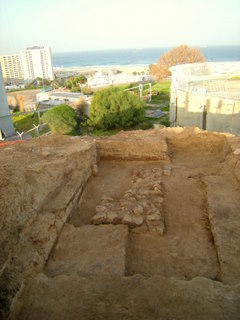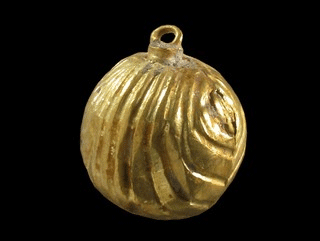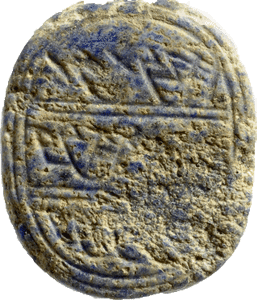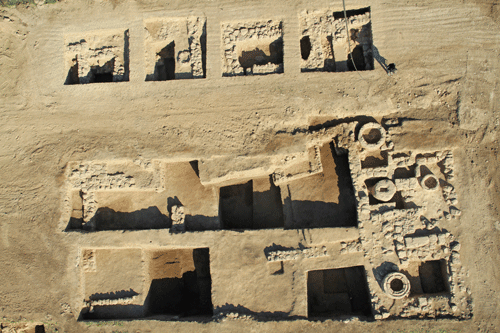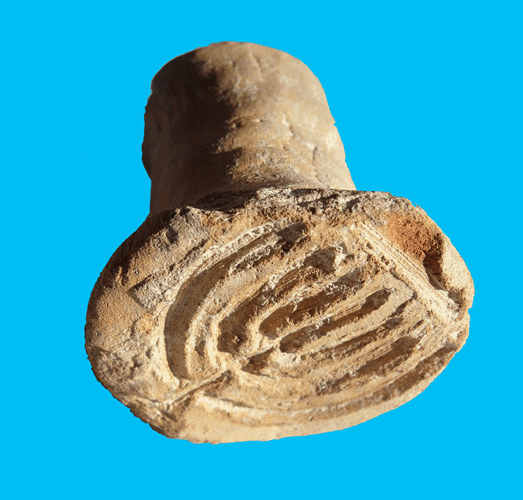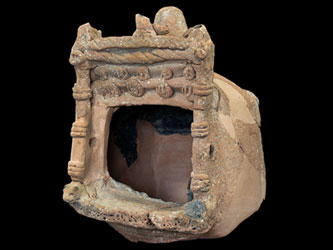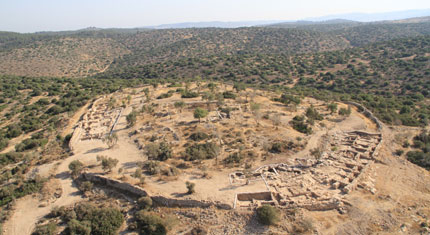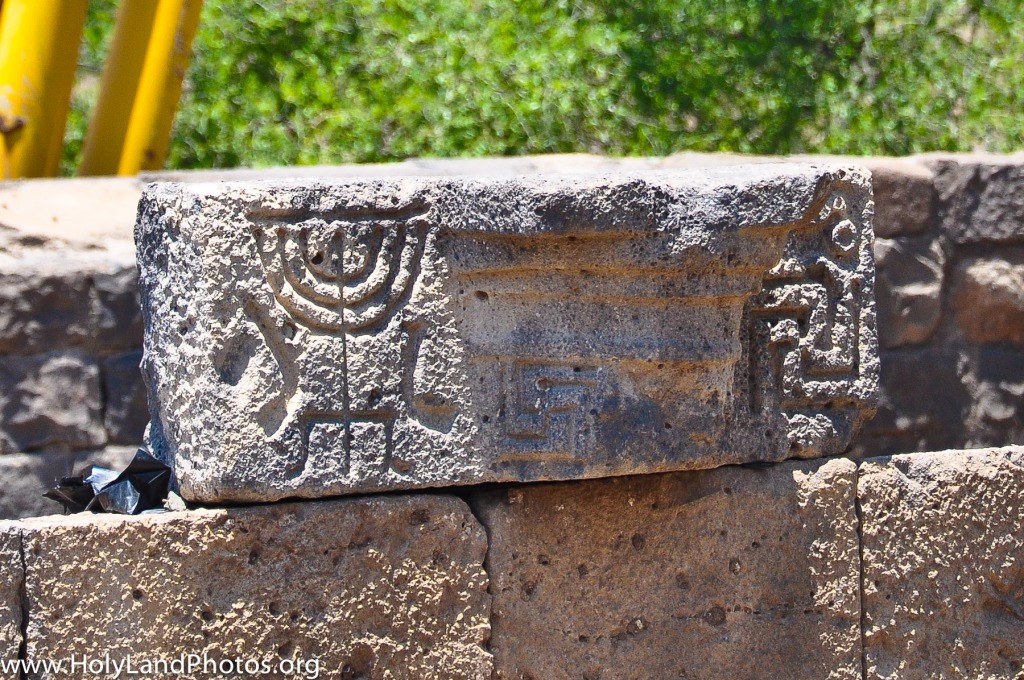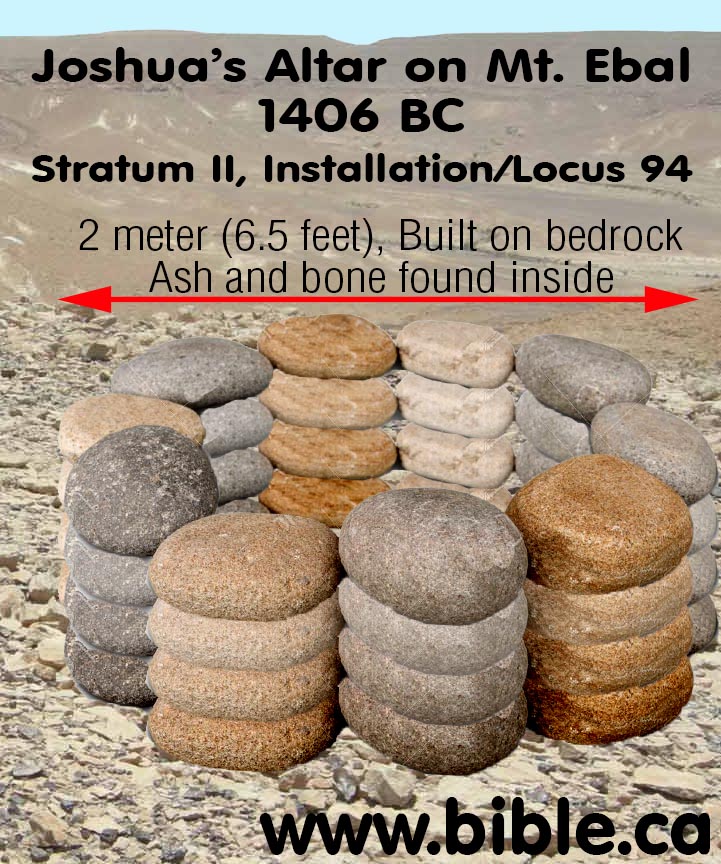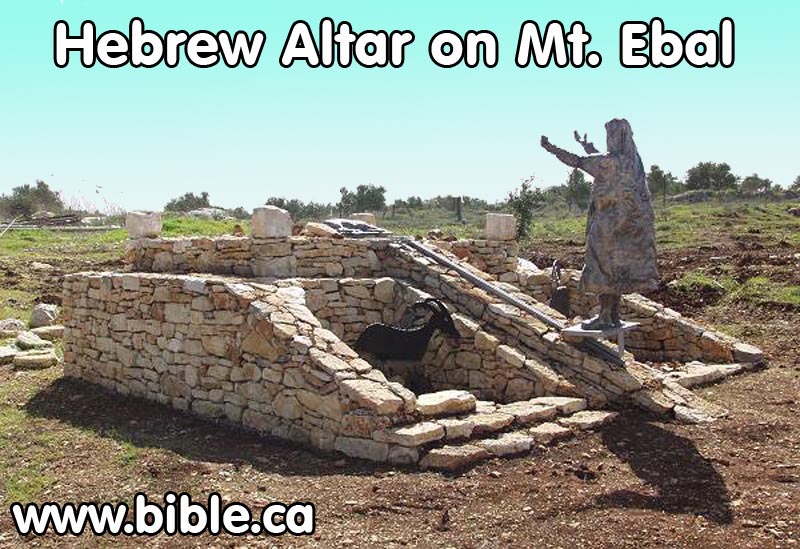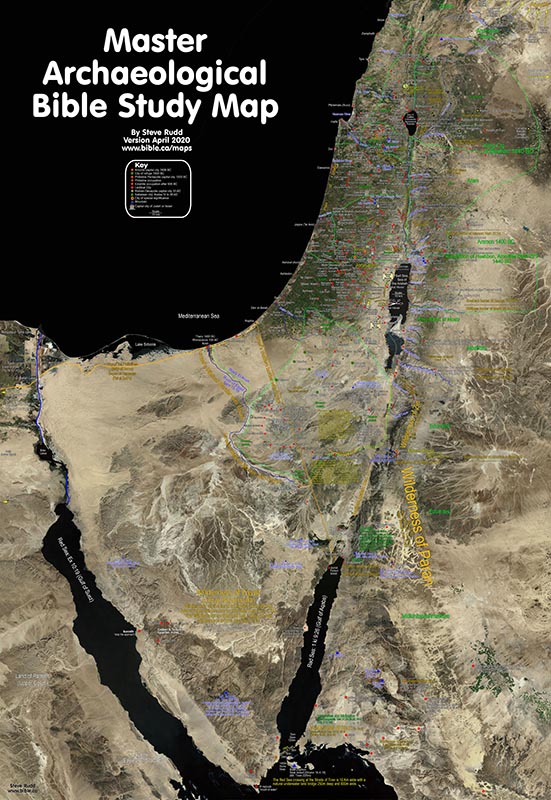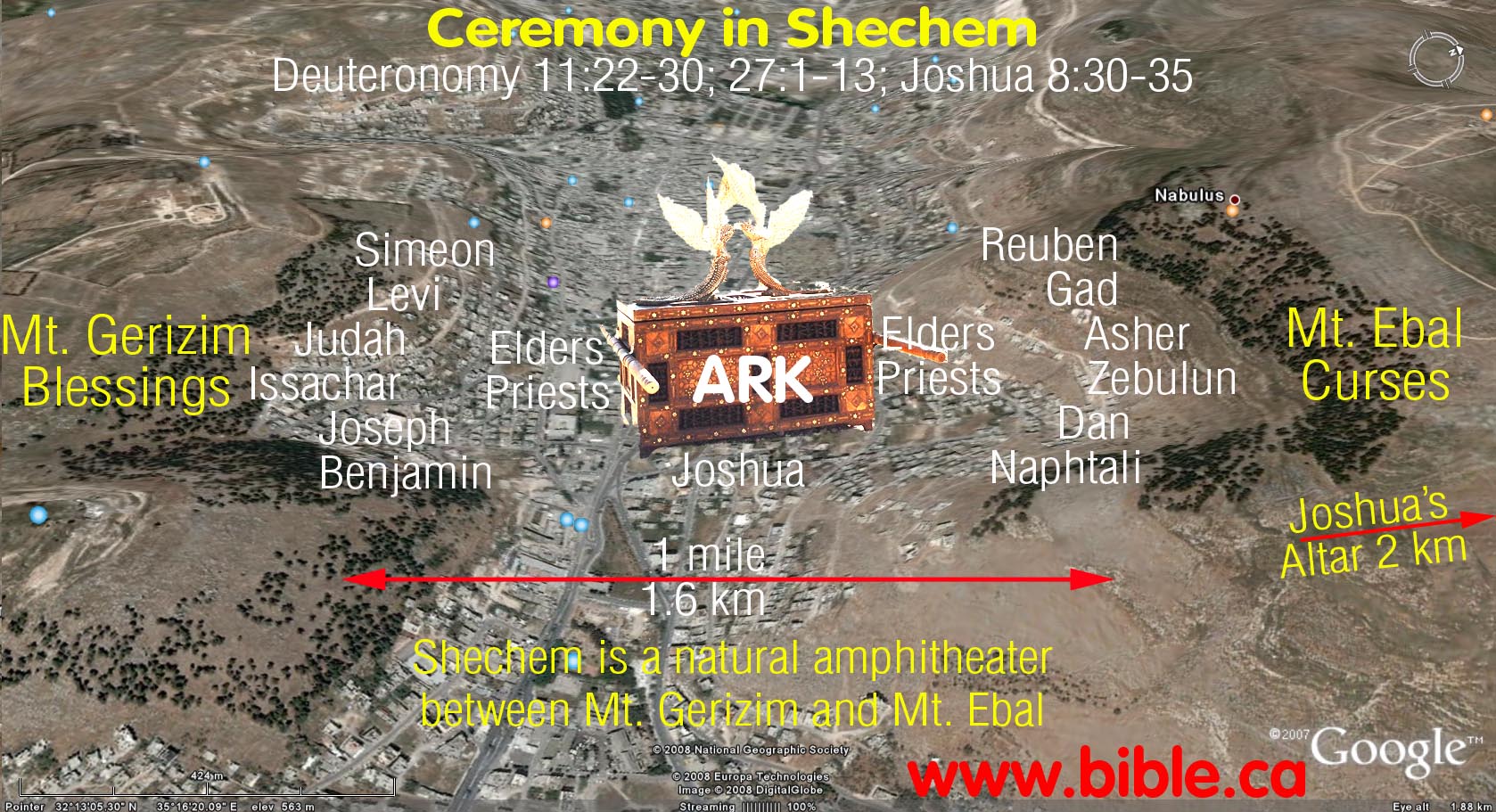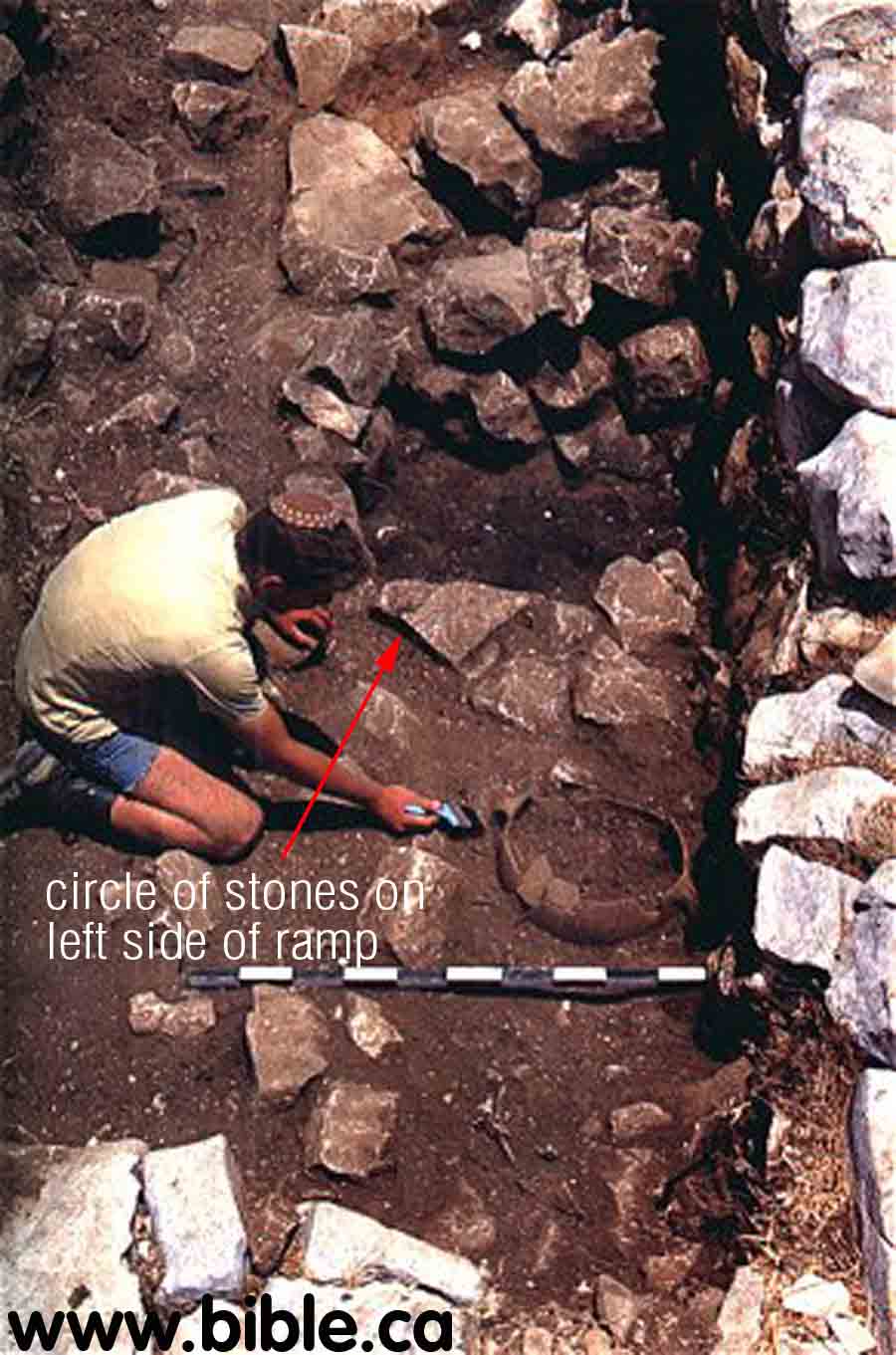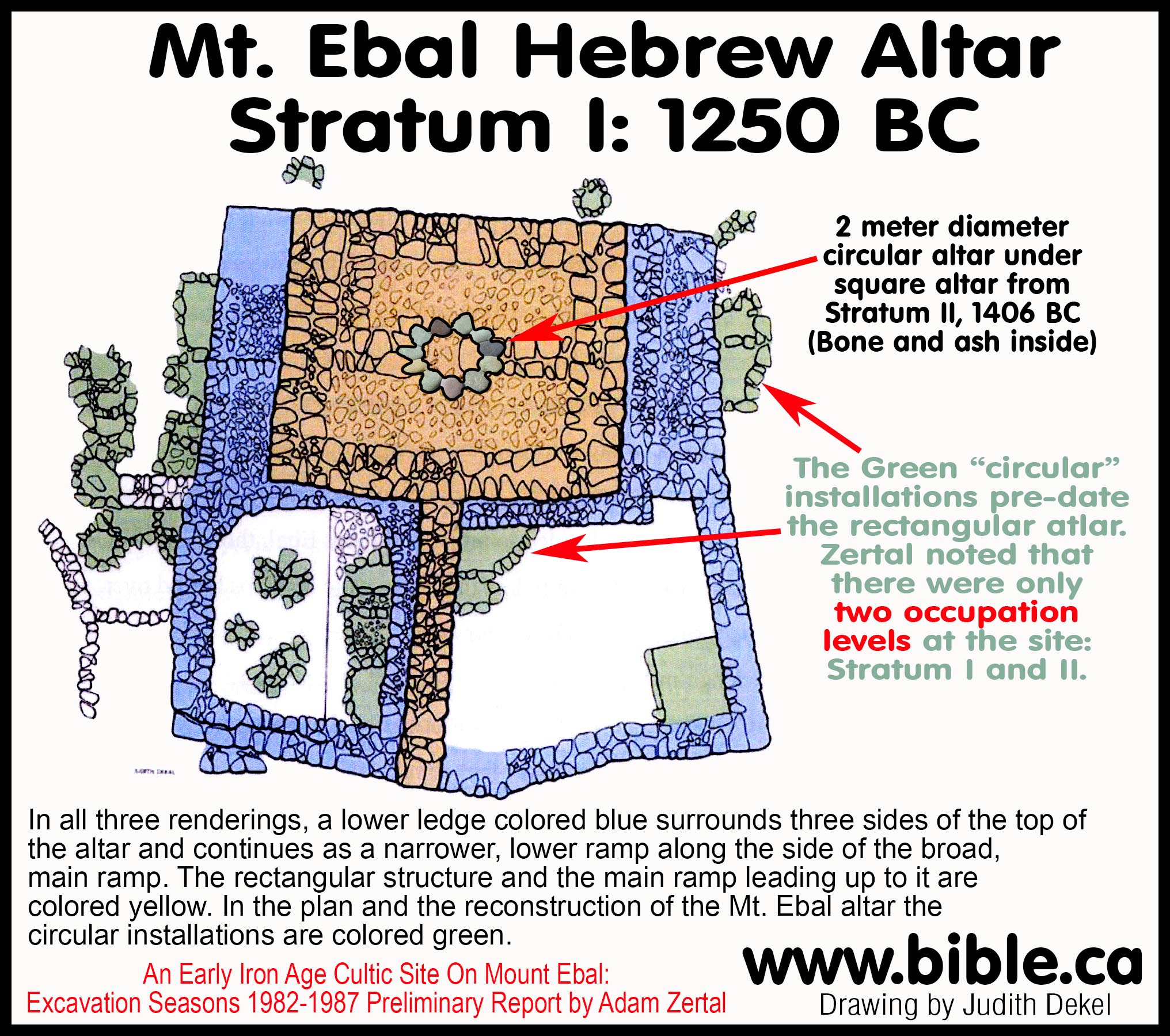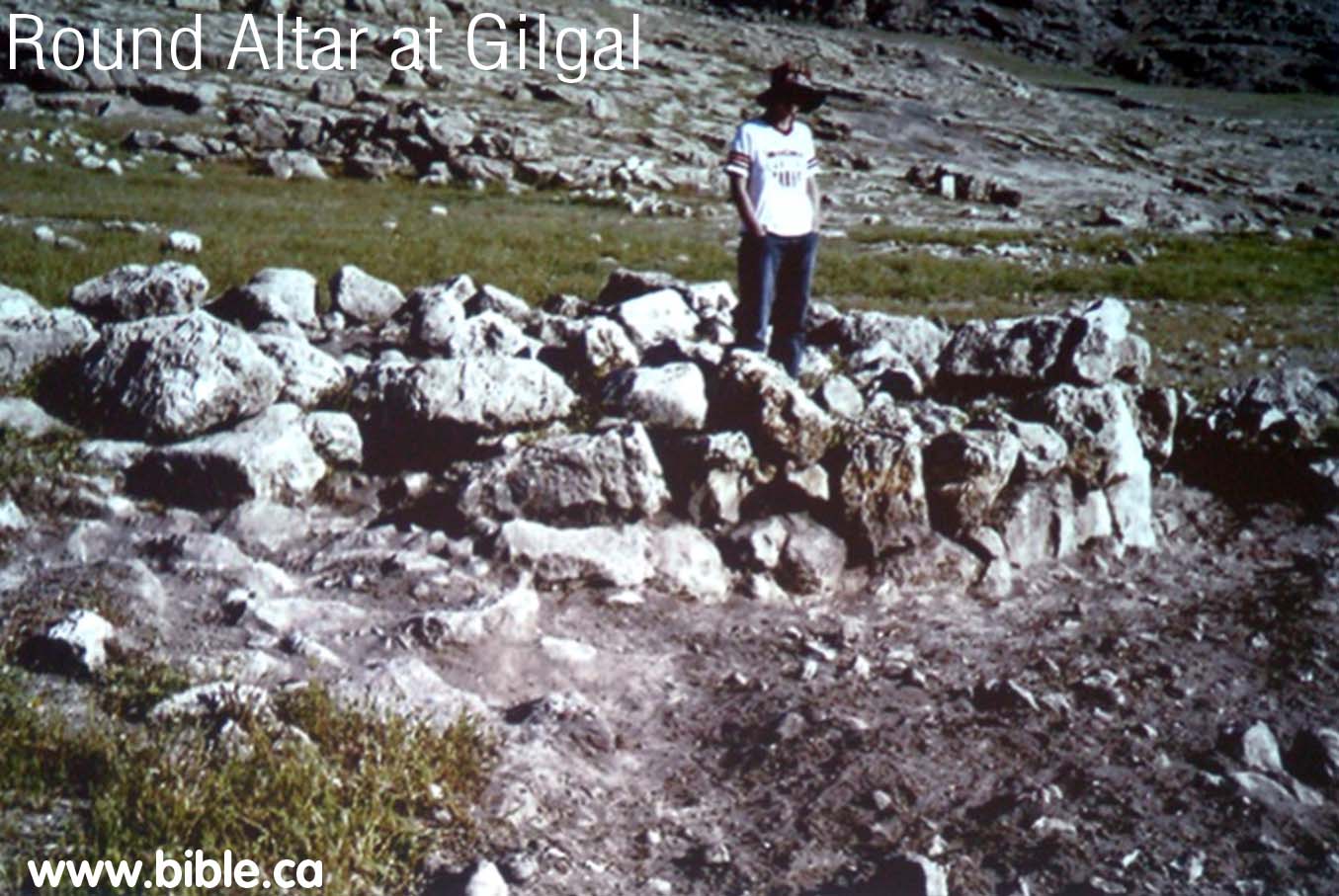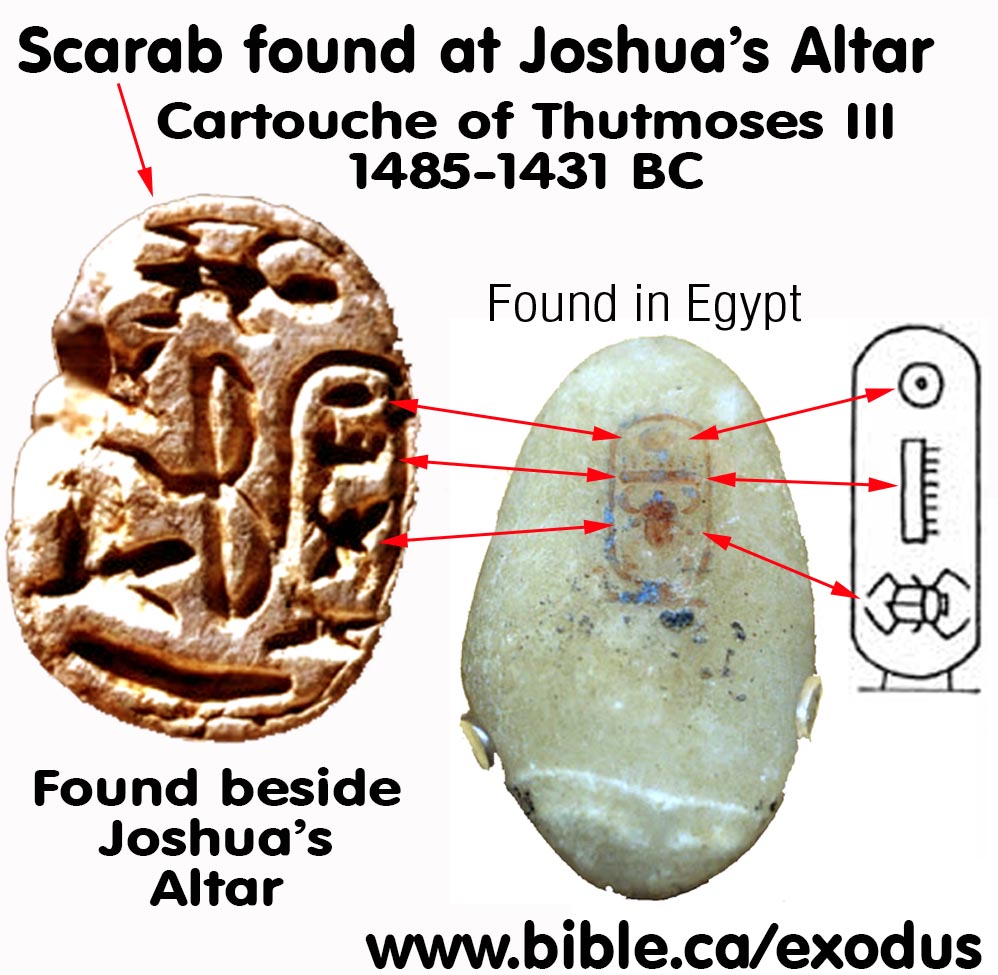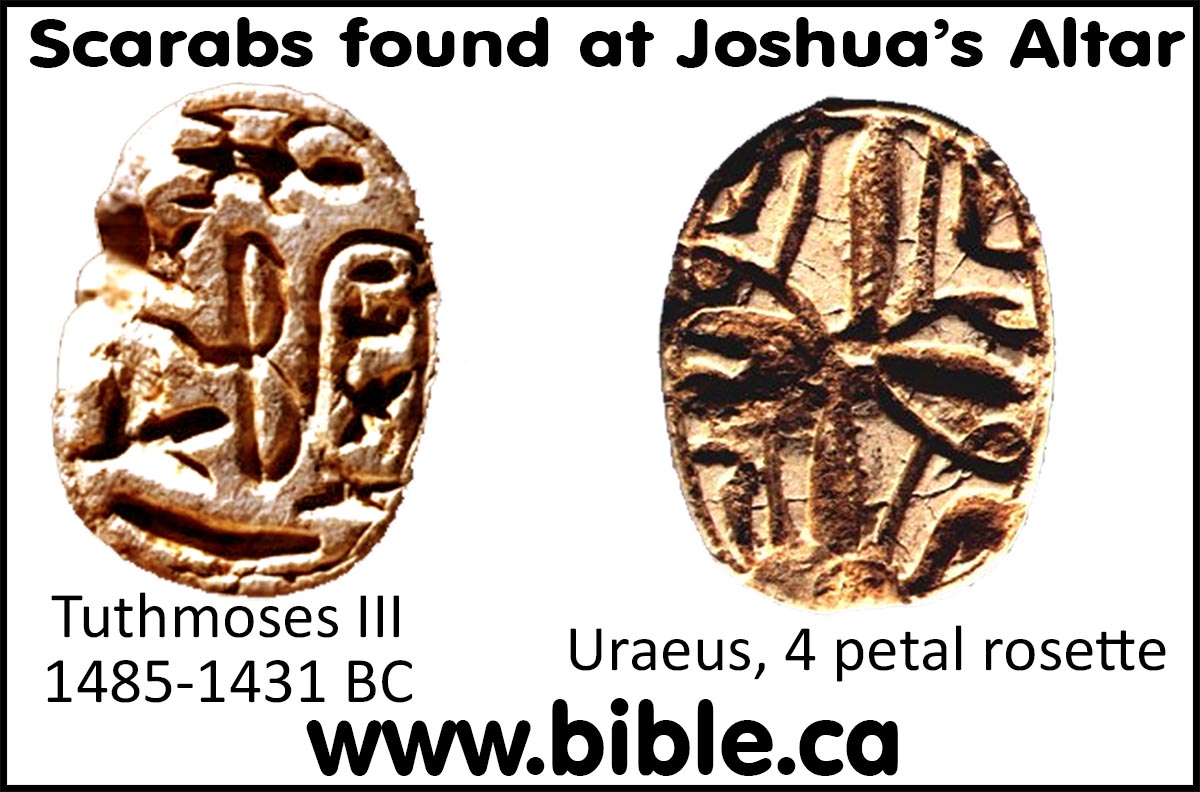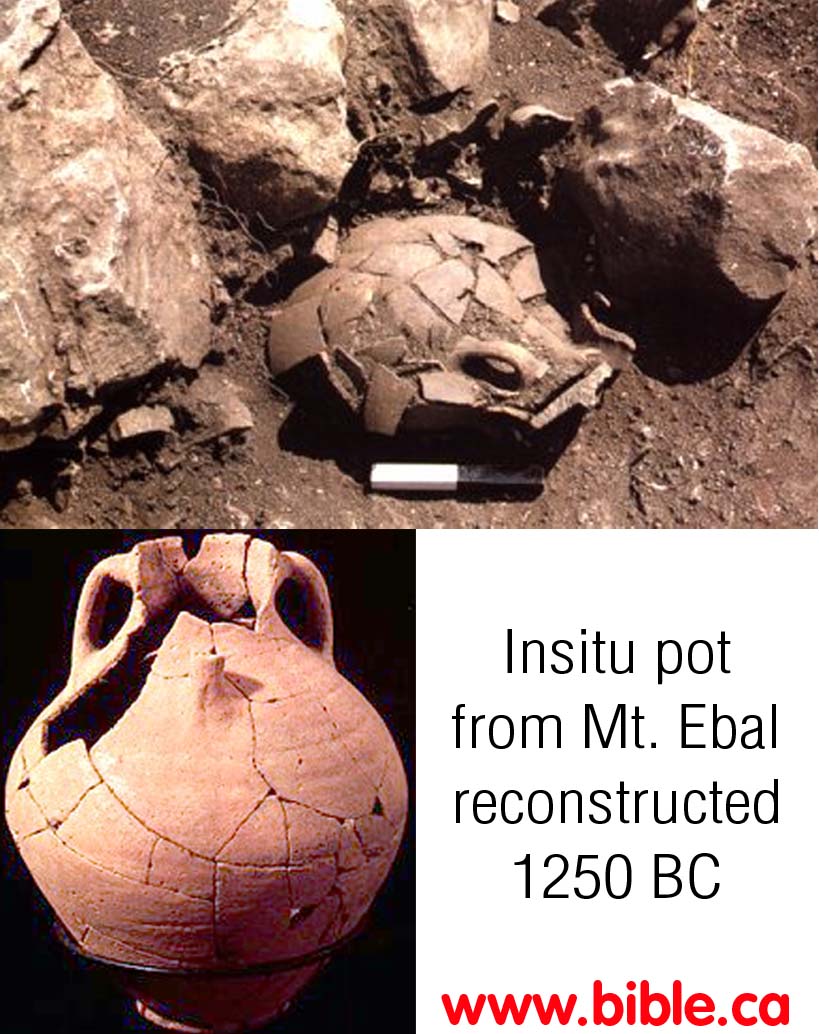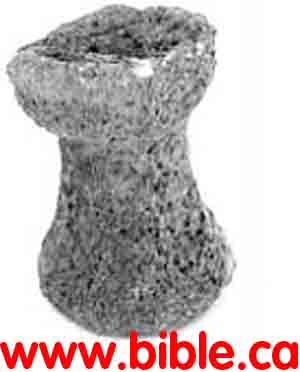|
|
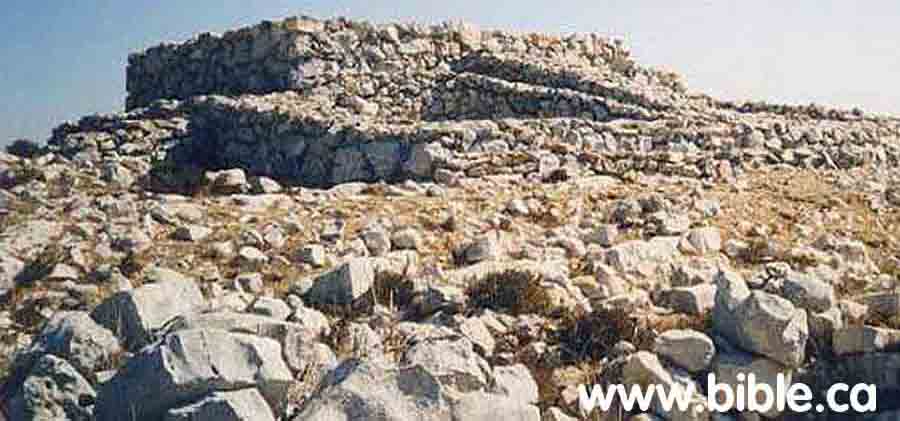 Above is the altar on Mt. Ebal as seen today
Right is a reconstruction at Garden of Biblical Samaria Park
|
|
| | |
Site location:
50 km N of Jerusalem
GPS: 32.239679N 35.287205E
|
Altar of Joshua, Mt. Ebal
(Click balloon for info, move with mouse)
|
Introduction:
- On April 6, 1980, Adam Zertal, Ph.D, Prof. Of Archeology, Univ. of Haifa was doing a formal archaeological survey of the traditional lands of Manasseh and discovered a Hebrew Altar that dated to 1250 BC. Using pottery to date the site Zertal said: "More important, however, is that they [the pottery] fix a date for the construction of the altar - approximately 1250 B.C.E." (Adam Zertal 2004 AD) Zertal is the author of "A Nation is Born: The Mt. Ebal Altar and the Beginnings of the Nation of Israel". See also: (Zertal, A. 1986/87 An Early Iron Age Cultic Site on Mt. Ebal: Excavation Seasons 1982-1987. Tel Aviv 13-14: 105-65. 1993.) and (The New Encyclopedia of Archaeological Excavation in the Holy Land, Vol. 1, ed. E. Stern. Jerusalem: Israel Exploration Society and Carta. Ebal, Mount. Pp. 375-77)
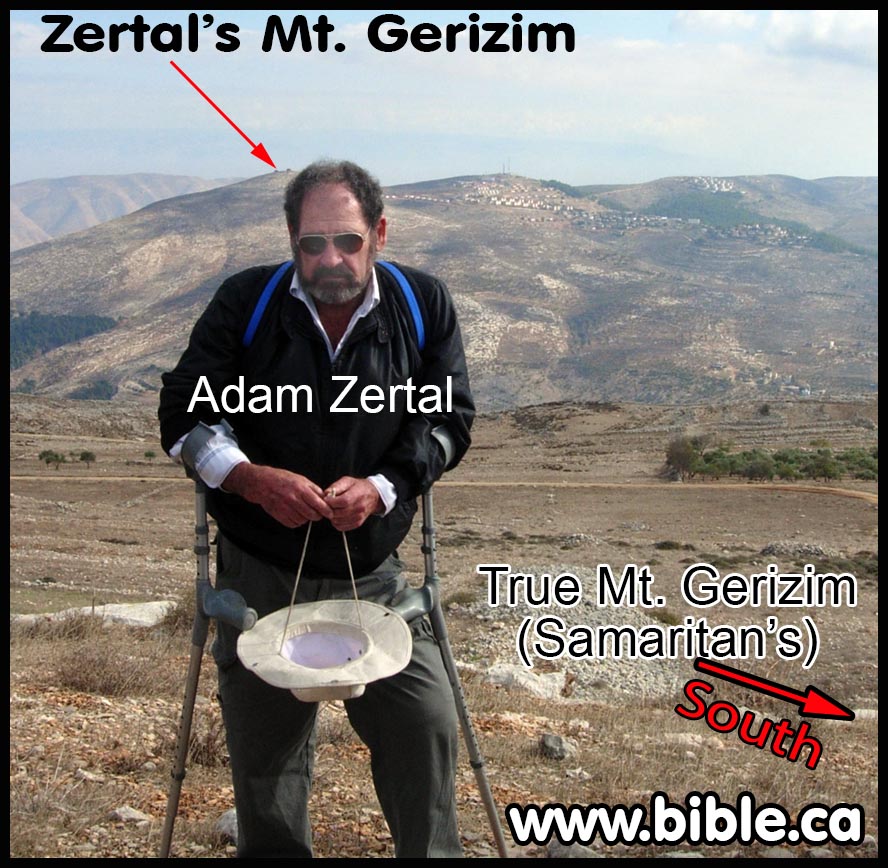
- The site at Mt. Ebal had two occupation levels. Zertal calls the older occupation "level II" which he dates 1300 BC and the younger level I to 1250 BC.
- If this site is no older than 1300 BC, then none of it could be built by Joshua, because the exodus took place in 1400 BC. However this is a Hebrew altar built during the time of Deborah the Judge and underneath we believe is the actual altar of Joshua that should be dated to 1400 BC since a scarab from Tuthmosis III was found but wrongly dated to 1250 BC.
- We agree that there are clearly two occupation levels. The rectangular altar we see today was built about 1250 BC. The 6.5 foot circular stone structure with burnt kosher bones inside was is located directly beneath the rectangular altar and was built about 1400 BC by Joshua. (We call it an altar, Zertal does not. We date it to 1400 BC, Zertal dates it to 1300 BC)
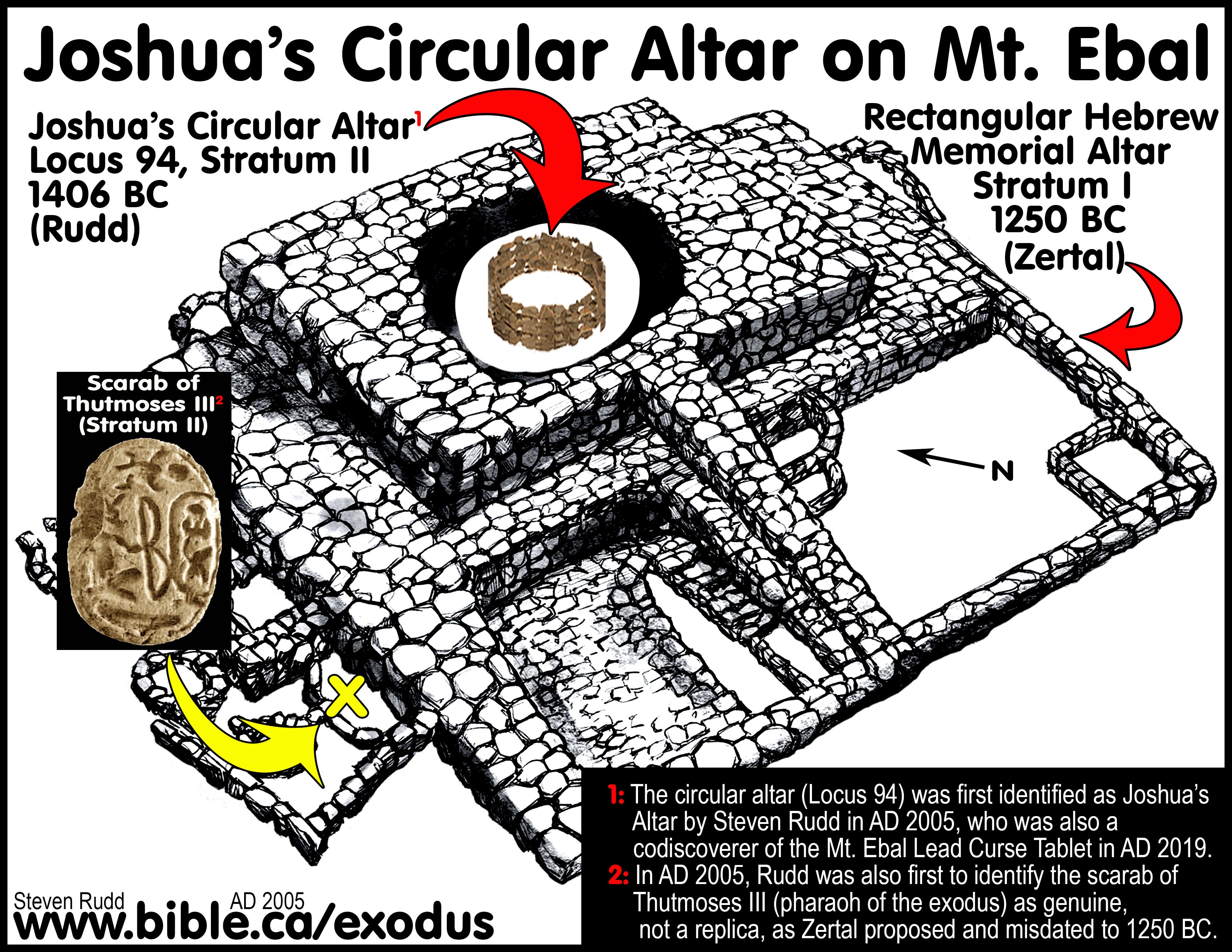 . .
- We speculate that since Abraham and Isaac lived in the area and built altars, we believe that the site dates back to the time of Abraham and that Joshua built his altar on top of Isaac's who in turn built his altar on top of Abraham's. In other words, the site has a long tradition of use as an altar from 2000 BC down to 1250 BC.
A. Discussion:
- I personally met Adam Zertal at the very site of Joshua's Altar where he discussed the find under the watchful eye of an IDF ground army escort including F-16s in November 2004. Trips are often thwarted by the terrorists in the area. One ill-fated tour, in October 2000, ended with the death of Rabbi Binyamin Herling, one of several hikers who left the main route and were shot at by Palestinian terrorists in Shechem. The army was widely accused of not taking offensive action to save the hikers when the terrorists pinned them down with long-range but accurate fire. A later trip to the same area during Chanukah was canceled by the army with just two days notice, because of intelligence warnings of another planned terror attack. On October 7, 2000, Joseph's Tomb, the third most holy place in Judaism, was destroyed by Muslims. It is located east of modern Nabulus between Shechem (Tel Balata) and Sychar at the foot of Mt. Ebal. It had come under attack and the Israeli Defense Forces (IDF) withdrew after gaining reassurances from the Palestinian Authority (PA) that they would protect the site in accordance with their obligations under the Oslo Accords to protect holy sites. Two hours after the withdrawal Muslims began destroying the site. It was burned and torn down stone by stone, then bulldozed. It was immediately declared a Muslim holy site. I was extremely fortunate and privileged to have actually reached the site, although the army did cut short my visit for "security reasons". I also assisted in reconstruction of the outer temenos wall of the altar under his personal supervision.
 . .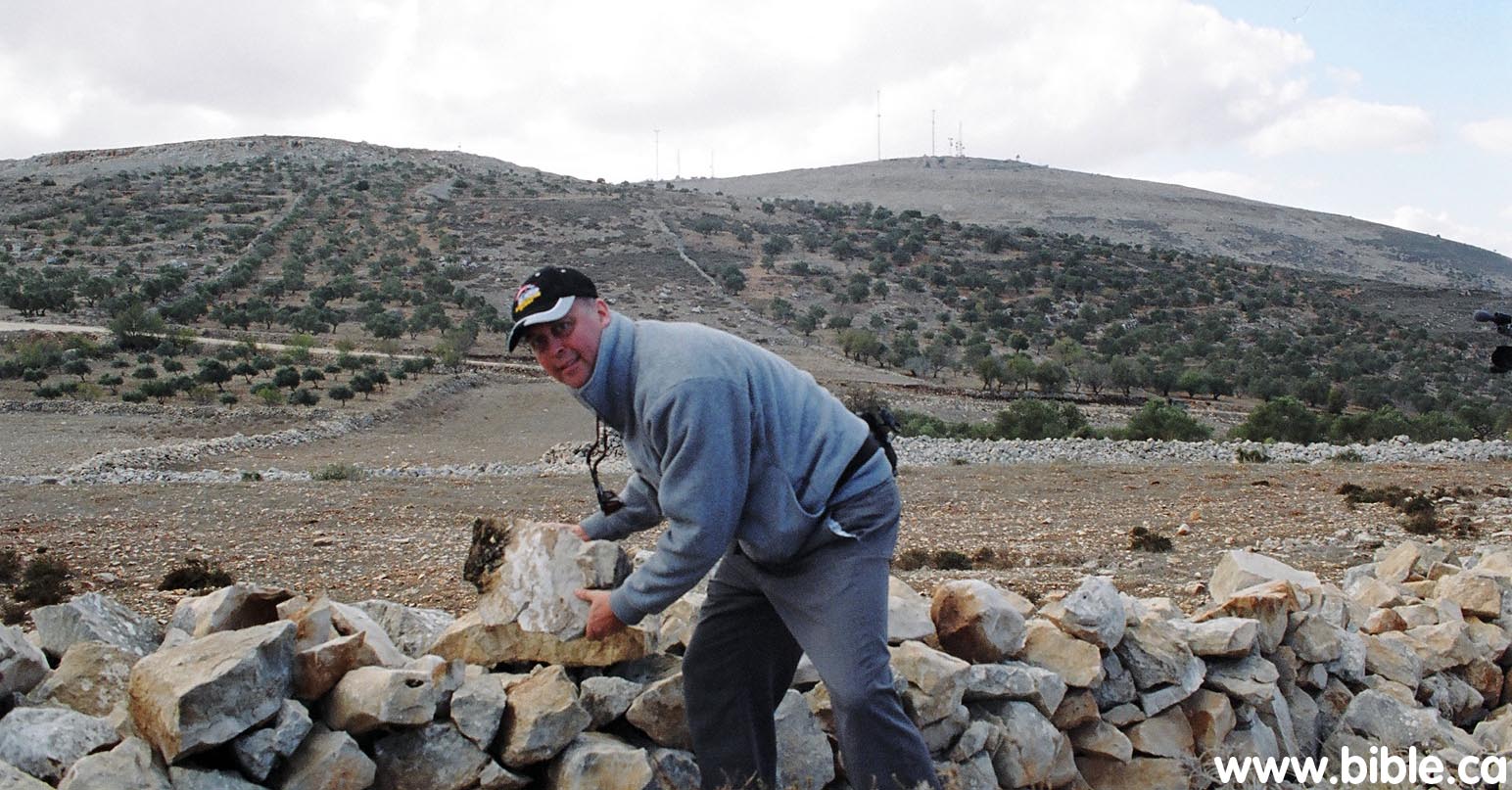
- In a discussion with Adam Zertal, he said that this archeological site has made a Bible believer out of him. Amen! Adam Zertal has undergone a transformation of faith that is truly remarkable. Like most of his fellow Israeli archeologists, he did not believe the Bible stories of the exodus to be true. He told me directly that the most anti-Biblical forces in archeology are the professors in the various Universities in Israel. Many Christians and Jews are surprised that this would be the case. Palestinian Muslims quote these Israeli archeologists in Tel Aviv as proof that the idea of a Jewish homeland that dates back to 1400 BC is a myth. Zertal was one of these Bible trashing archeologists. But that all changed in 1983, three years after Zertal first stumbled on the site while doing a formal archeological survey of the area. After studying the structure for three years with no idea what is was used for, he suddenly realized that it was the site of Joshua's Altar. We agree with him and now he believes the Bible. See our section on, "They are digging up Bible stories!"
- Adam Zertal commented: "We discovered this place, all covered with stones, in April 1980. At that time I never dreamt that we were dealing with the altar, because I was taught in Tel Aviv University - the center of anti-Biblical tendencies, where I learned that Biblical theories are untrue, and that Biblical accounts were written later, and the like. I didn't even know of the story of the Joshua's altar. But we surveyed every meter of the site, and in the course of nine years of excavation, we discovered a very old structure with no parallels to anything we had seen before. It was 9 by 7 meters, and 4 meters high, with two stone ramps, and a kind of veranda, known as the sovev, around."
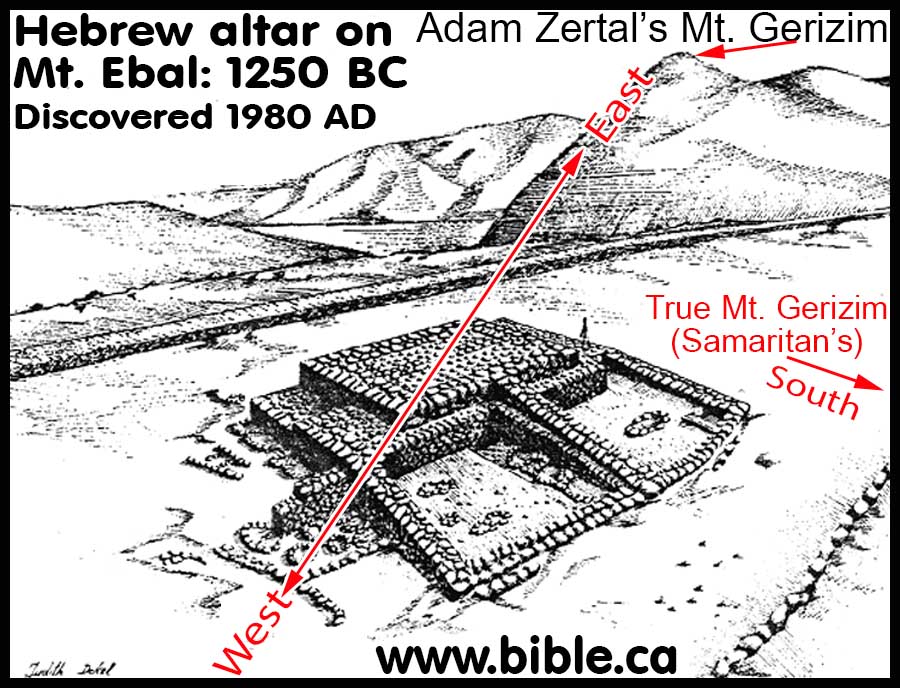
- The exodus happened in 1400 BC and the Pharaoh of the exodus was Tuthmosis III. However, there is a problem, because Adam Zertal dates the exodus at 1250 BC, when the Bible tells us it was 1440 BC. 1 Kings 6:1 says that Israel was at Joshua's Altar in 1400 BC. The structure we see today simply cannot be Joshua's alter since it is dated to 1250 BC.
- Zertal discovered a second circular structure 6.5 feet in diameter underneath what we see today. Zertal dates this second structure to 1300 BC but we question this. We have superimposed the circle of stones onto the drawing so you can see what it looked like. These stones were on bedrock level underneath the altar we see today. We call this circle of stones an "altar", although Zertal does not. However, he does document that burnt bones found inside of it.

- Hebrew altars can be distinguished from pagan altars in 5 respects: 1. They are made of uncut natural stone. 2. Ramps, never stairs. 3. Hebrew altars are square. 4. Hebrew altars have their sides oriented to the 4 points of the compass (NSEW), as we see in the orientation of the tabernacle. It is clear that Adam Zertal has discovered a Hebrew altar because it is made of uncut stones with ramps. However since the altar is rectangular and the corners, not the sides point NSEW, this site presents some challenges. We believe this mix of pagan and Hebrew elements of the rectangular altar of 1250 BC can be explained. This was the time of Deborah the Judge and perhaps this altar was built by Hebrews to worship to both YHWH and a pagan god. Perhaps the mix of Hebrew and pagan elements in the altar are typical of such times of compromise. "Then the sons of Israel did evil in the sight of the Lord and served the Baals, and they forsook the Lord, the God of their fathers, who had brought them out of the land of Egypt, and followed other gods from among the gods of the peoples who were around them, and bowed themselves down to them; thus they provoked the Lord to anger. So they forsook the Lord and served Baal and the Ashtaroth." Judges 2:11-13
- Adam Zertal refined his views of the two level of occupations at the Mt. Ebal site. In 2004 Zertal dates the rectangular altar to 1250 BC. "More important, however, is that they [the pottery discovered] fix a date for the construction of the altar - approximately 1250 b.c.e." (Adam Zertal). In 1986: "Zertal calls the older occupation "level II" which he dates 1225 - 1200 BC and the younger level I to 1200 -1150 BC. Zertal also uncovered a raised step behind the courtyards, which he assigns to Level II. "Animal bones from Level II have been found in the area of the courtyards; these bones are not burnt and thus are probably the remains of meals, not sacrifices. Cultic installations in the area of the later altar are also attributable to this early phase. In Level I (the later phase), many new structures were added (tinted red). The Israelites constructed a thin stone wall parallel to the old revetment wall. They filled in the space between the Level II revetment wall and the Level I wall with medium-size stones to make a sturdy temenos wall that supported the courtyards. At the same time, says Zertal, they built the altar. Surrounding the inner temenos, the altar and the courtyards, an outer temenos wall was constructed. Entrance to this larger walled area was from an opening on the southeast. A three-stepped entrance from the west in the inner temenos wall gave access to the altar area." (How Can Kempinski Be So Wrong!, Adam Zertal, BAR, 1986 AD)
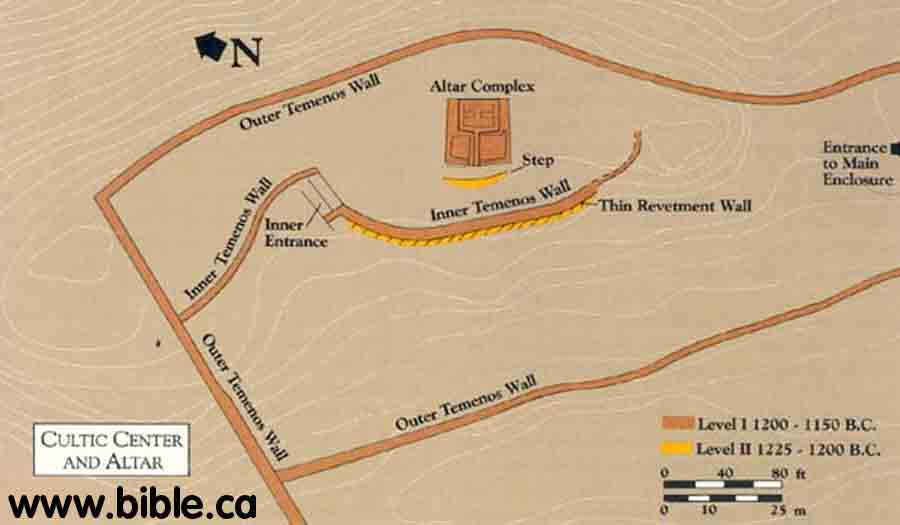
Since 2004, Zertal now dates level II to 1250 BC.
- Amazingly, Zertal has already discovered the proof he needs to date the site to the 1400 BC. He discovered the cartouche of Tuthmosis III at the site. (see below). Tuthmosis III was the pharaoh of the exodus.
B. The Bible texts:
- Moses: "For if you are careful to keep all this commandment which I am commanding you to do, to love the Lord your God, to walk in all His ways and hold fast to Him, then the Lord will drive out all these nations from before you, and you will dispossess nations greater and mightier than you. "Every place on which the sole of your foot treads shall be yours; your border will be from the wilderness to Lebanon, and from the river, the river Euphrates, as far as the western sea. "No man will be able to stand before you; the Lord your God will lay the dread of you and the fear of you on all the land on which you set foot, as He has spoken to you. "See, I am setting before you today a blessing and a curse: the blessing, if you listen to the commandments of the Lord your God, which I am commanding you today; and the curse, if you do not listen to the commandments of the Lord your God, but turn aside from the way which I am commanding you today, by following other gods which you have not known. "It shall come about, when the Lord your God brings you into the land where you are entering to possess it, that you shall place the blessing on Mount Gerizim and the curse on Mount Ebal. Are they not across the Jordan, west of the way toward the sunset, in the land of the Canaanites who live in the Arabah, opposite Gilgal, beside the oaks of Moreh?" Deuteronomy 11:22-30
- Moses: "Then Moses and the elders of Israel charged the people, saying, "Keep all the commandments which I command you today. "So it shall be on the day when you cross the Jordan to the land which the Lord your God gives you, that you shall set up for yourself large stones and coat them with lime and write on them all the words of this law, when you cross over, so that you may enter the land which the Lord your God gives you, a land flowing with milk and honey, as the Lord, the God of your fathers, promised you. "So it shall be when you cross the Jordan, you shallset up on Mount Ebal, these stones, as I am commanding you today, and you shall coat them with lime. "Moreover, you shall build there an altar to the Lord your God, an altar of stones; you shall not wield an iron tool on them. "You shall build the altar of the Lord your God of uncut stones, and you shall offer on it burnt offerings to the Lord your God; and you shall sacrifice peace offerings and eat there, and rejoice before the Lord your God. "You shall write on the stones all the words of this law very distinctly." Then Moses and the Levitical priests spoke to all Israel, saying, "Be silent and listen, O Israel! This day you have become a people for the Lord your God. "You shall therefore obey the Lord your God, and do His commandments and His statutes which I command you today." Moses also charged the people on that day, saying, "When you cross the Jordan, these shall stand on Mount Gerizim to bless the people: Simeon, Levi, Judah, Issachar, Joseph, and Benjamin. "For the curse, these shall stand on Mount Ebal: Reuben, Gad, Asher, Zebulun, Dan, and Naphtali." "The Levites shall then answer and say to all the men of Israel with a loud voice, 'Cursed is the man who makes an idol or a molten image, an abomination to the Lord, the work of the hands of the craftsman, and sets it up in secret.' And all the people shall answer and say, 'Amen.'" Deuteronomy 27:1-15
- The Curses towards Mt. Ebal: ""For the curse, these shall stand on Mount Ebal: Reuben, Gad, Asher, Zebulun, Dan, and Naphtali. "The Levites shall then answer and say to all the men of Israel with a loud voice, 'Cursed is the man who makes an idol or a molten image, an abomination to the Lord, the work of the hands of the craftsman, and sets it up in secret.' And all the people shall answer and say, 'Amen.' 'Cursed is he who dishonors his father or mother.' And all the people shall say, 'Amen.' 'Cursed is he who moves his neighbor's boundary mark.' And all the people shall say, 'Amen.' 'Cursed is he who misleads a blind person on the road.' And all the people shall say, 'Amen.' 'Cursed is he who distorts the justice due an alien, orphan, and widow.' And all the people shall say, 'Amen.' 'Cursed is he who lies with his father's wife, because he has uncovered his father's skirt.' And all the people shall say, 'Amen.' 'Cursed is he who lies with any animal.' And all the people shall say, 'Amen.' 'Cursed is he who lies with his sister, the daughter of his father or of his mother.' And all the people shall say, 'Amen.' 'Cursed is he who lies with his mother-in-law.' And all the people shall say, 'Amen.' 'Cursed is he who strikes his neighbor in secret.' And all the people shall say, 'Amen.' 'Cursed is he who accepts a bribe to strike down an innocent person.' And all the people shall say, 'Amen.' 'Cursed is he who does not confirm the words of this law by doing them.' And all the people shall say, 'Amen.'" Deuteronomy 27:13-26
- The Blessings towards Mt. Gerizim: " "Now it shall be, if you diligently obey the Lord your God, being careful to do all His commandments which I command you today, the Lord your God will set you high above all the nations of the earth. "All these blessings will come upon you and overtake you if you obey the Lord your God: "Blessed shall you be in the city, and blessed shall you be in the country. "Blessed shall be the offspring of your body and the produce of your ground and the offspring of your beasts, the increase of your herd and the young of your flock. "Blessed shall be your basket and your kneading bowl. "Blessed shall you be when you come in, and blessed shall you be when you go out. "The Lord shall cause your enemies who rise up against you to be defeated before you; they will come out against you one way and will flee before you seven ways. "The Lord will command the blessing upon you in your barns and in all that you put your hand to, and He will bless you in the land which the Lord your God gives you. "The Lord will establish you as a holy people to Himself, as He swore to you, if you keep the commandments of the Lord your God and walk in His ways. "So all the peoples of the earth will see that you are called by the name of the Lord, and they will be afraid of you. "The Lord will make you abound in prosperity, in the offspring of your body and in the offspring of your beast and in the produce of your ground, in the land which the Lord swore to your fathers to give you. "The Lord will open for you His good storehouse, the heavens, to give rain to your land in its season and to bless all the work of your hand; and you shall lend to many nations, but you shall not borrow. "The Lord will make you the head and not the tail, and you only will be above, and you will not be underneath, if you listen to the commandments of the Lord your God, which I charge you today, to observe them carefully, and do not turn aside from any of the words which I command you today, to the right or to the left, to go after other gods to serve them." Deuteronomy 28:1-14
- The Curses: " "But it shall come about, if you do not obey the Lord your God, to observe to do all His commandments and His statutes with which I charge you today, that all these curses will come upon you and overtake you: "Cursed shall you be in the city, and cursed shall you be in the country. "Cursed shall be your basket and your kneading bowl. "Cursed shall be the offspring of your body and the produce of your ground, the increase of your herd and the young of your flock. "Cursed shall you be when you come in, and cursed shall you be when you go out. "The Lord will send upon you curses, confusion, and rebuke, in all you undertake to do, until you are destroyed and until you perish quickly, on account of the evil of your deeds, because you have forsaken Me. "The Lord will make the pestilence cling to you until He has consumed you from the land where you are entering to possess it. "The Lord will smite you with consumption and with fever and with inflammation and with fiery heat and with the sword and with blight and with mildew, and they will pursue you until you perish. "The heaven which is over your head shall be bronze, and the earth which is under you, iron. "The Lord will make the rain of your land powder and dust; from heaven it shall come down on you until you are destroyed. "The Lord shall cause you to be defeated before your enemies; you will go out one way against them, but you will flee seven ways before them, and you will be an example of terror to all the kingdoms of the earth. "Your carcasses will be food to all birds of the sky and to the beasts of the earth, and there will be no one to frighten them away. "The Lord will smite you with the boils of Egypt and with tumors and with the scab and with the itch, from which you cannot be healed. "The Lord will smite you with madness [mental illness] and with blindness and with bewilderment of heart; and you will grope at noon, as the blind man gropes in darkness, and you will not prosper in your ways; but you shall only be oppressed and robbed continually, with none to save you. "You shall betroth a wife, but another man will violate her; you shall build a house, but you will not live in it; you shall plant a vineyard, but you will not use its fruit. "Your ox shall be slaughtered before your eyes, but you will not eat of it; your donkey shall be torn away from you, and will not be restored to you; your sheep shall be given to your enemies, and you will have none to save you. "Your sons and your daughters shall be given to another people, while your eyes look on and yearn for them continually; but there will be nothing you can do. "A people whom you do not know shall eat up the produce of your ground and all your labors, and you will never be anything but oppressed and crushed continually. "You shall be driven mad by the sight of what you see. "The Lord will strike you on the knees and legs with sore boils, from which you cannot be healed, from the sole of your foot to the crown of your head. "The Lord will bring you and your king, whom you set over you, to a nation which neither you nor your fathers have known, and there you shall serve other gods, wood and stone. "You shall become a horror, a proverb, and a taunt among all the people where the Lord drives you. "You shall bring out much seed to the field but you will gather in little, for the locust will consume it. "You shall plant and cultivate vineyards, but you will neither drink of the wine nor gather the grapes, for the worm will devour them. "You shall have olive trees throughout your territory but you will not anoint yourself with the oil, for your olives will drop off. "You shall have sons and daughters but they will not be yours, for they will go into captivity. "The cricket shall possess all your trees and the produce of your ground. "The alien who is among you shall rise above you higher and higher, but you will go down lower and lower. "He shall lend to you, but you will not lend to him; he shall be the head, and you will be the tail. "So all these curses shall come on you and pursue you and overtake you until you are destroyed, because you would not obey the Lord your God by keeping His commandments and His statutes which He commanded you. "They shall become a sign and a wonder on you and your descendants forever. "Because you did not serve the Lord your God with joy and a glad heart, for the abundance of all things; therefore you shall serve your enemies whom the Lord will send against you, in hunger, in thirst, in nakedness, and in the lack of all things; and He will put an iron yoke on your neck until He has destroyed you. "The Lord will bring a nation against you from afar, from the end of the earth, as the eagle swoops down, a nation whose language you shall not understand, a nation of fierce countenance who will have no respect for the old, nor show favor to the young. "Moreover, it shall eat the offspring of your herd and the produce of your ground until you are destroyed, who also leaves you no grain, new wine, or oil, nor the increase of your herd or the young of your flock until they have caused you to perish. "It shall besiege you in all your towns until your high and fortified walls in which you trusted come down throughout your land, and it shall besiege you in all your towns throughout your land which the Lord your God has given you. "Then you shall eat the offspring of your own body, the flesh of your sons and of your daughters whom the Lord your God has given you, during the siege and the distress by which your enemy will oppress you. "The man who is refined and very delicate among you shall be hostile toward his brother and toward the wife he cherishes and toward the rest of his children who remain, so that he will not give even one of them any of the flesh of his children which he will eat, since he has nothing else left, during the siege and the distress by which your enemy will oppress you in all your towns. "The refined and delicate woman among you, who would not venture to set the sole of her foot on the ground for delicateness and refinement, shall be hostile toward the husband she cherishes and toward her son and daughter, and toward her afterbirth which issues from between her legs and toward her children whom she bears; for she will eat them secretly for lack of anything else, during the siege and the distress by which your enemy will oppress you in your towns. "If you are not careful to observe all the words of this law which are written in this book, to fear this honored and awesome name, the Lord your God, then the Lord will bring extraordinary plagues on you and your descendants, even severe and lasting plagues, and miserable and chronic sicknesses. "He will bring back on you all the diseases of Egypt of which you were afraid, and they will cling to you. "Also every sickness and every plague which, not written in the book of this law, the Lord will bring on you until you are destroyed. "Then you shall be left few in number, whereas you were as numerous as the stars of heaven, because you did not obey the Lord your God. "It shall come about that as the Lord delighted over you to prosper you, and multiply you, so the Lord will delight over you to make you perish and destroy you; and you will be torn from the land where you are entering to possess it. "Moreover, the Lord will scatter you among all peoples, from one end of the earth to the other end of the earth; and there you shall serve other gods, wood and stone, which you or your fathers have not known. "Among those nations you shall find no rest, and there will be no resting place for the sole of your foot; but there the Lord will give you a trembling heart, failing of eyes, and despair of soul. "So your life shall hang in doubt before you; and you will be in dread night and day, and shall have no assurance of your life. "In the morning you shall say, 'Would that it were evening!' And at evening you shall say, 'Would that it were morning!' because of the dread of your heart which you dread, and for the sight of your eyes which you will see. "The Lord will bring you back to Egypt in ships, by the way about which I spoke to you, 'You will never see it again!' And there you will offer yourselves for sale to your enemies as male and female slaves, but there will be no buyer."" Deuteronomy 28:15-68
- Joshua: "Then Joshua built an altar to the Lord, the God of Israel, in Mount Ebal, just as Moses the servant of the Lord had commanded the sons of Israel, as it is written in the book of the law of Moses, an altar of uncut stones on which no man had wielded an iron tool; and they offeredburnt offerings on it to the Lord, and sacrificed peace offerings. He wrote there on the stones a copy of the law of Moses, which he had written, in the presence of the sons of Israel. All Israel with their elders and officers and their judges were standing on both sides of the ark before the Levitical priests who carried the ark of the covenant of the Lord, the stranger as well as the native. Half of them stood in front of Mount Gerizim and half of them in front of Mount Ebal, just as Moses the servant of the Lord had given command at first to bless the people of Israel. Then afterward he read all the words of the law, the blessing and the curse, according to all that is written in the book of the law. There was not a word of all that Moses had commanded which Joshua did not read before all the assembly of Israel with the women and the little ones and the strangers who were living among them." Joshua 8:30-35
- "Abram passed through the land as far as the site of Shechem, to the oak of Moreh. Now the Canaanite was then in the land." Genesis 12:6
- "So they gave to Jacob all the foreign gods which they had and the rings which were in their ears, and Jacob hid them under the oak which was near Shechem." Genesis 35:4
- "Now the people came up from the Jordan on the tenth of the first month and camped at Gilgal on the eastern edge of Jericho." Joshua 4:19
- ""Are they [Ebal and Gerizim] not across the Jordan, west of the way toward the sunset, in the land of the Canaanites who live in the Arabah,opposite Gilgal, beside the oaks of Moreh?" Deuteronomy 11:30
- "Now when they told Jotham, he went and stood on the top of Mount Gerizim, and lifted his voice and called out. Thus he said to them, "Listen to me, O men of Shechem, that God may listen to you." Judges 9:7
- ""You shall make for them linen breeches to cover their bare flesh; they shall reach from the loins even to the thighs. "They shall be on Aaron and on his sons when they enter the tent of meeting, or when they approach the altar to minister in the holy place, so that they do not incur guilt and die. It shall be a statute forever to him and to his descendants after him." Exodus 28:42-43
- "'If you make an altar of stone for Me, you shall not build it of cut stones, for if you wield your tool on it, you will profane it. 'And you shall not go up by steps to My altar, so that your nakedness will not be exposed on it.'" Exodus 20:25-26
- "All the numbered men of the Levites, whom Moses and Aaron numbered at the command of the Lord by their families, every male from a month old and upward, were 22,000." Numbers 3:39
- "Then the whole congregation of the sons of Israel assembled themselves at Shiloh, and set up the tent of meeting there; and the land was subdued before them." Joshua 18:1
C. The history of Shechem, Mt. Ebal and Mt. Gerizim:
- Today, ancient Shechem is located Tel Balata, which is about 3 km east of modern Nabulus. It may be that Tel Balata which literally means "a paving stone or tile" may in fact derive from Arabic balut, meaning "oak".
- In 2085 BC Abraham left Haran at age 75 and the same year God appeared to him at Shechem: Gen 12:4. In 2085 BC, Abraham built an altar in Shechem beside the Oak of Moreh where God appeared to him and promised to give his seed the land: "Abram passed through the land as far as the site of Shechem, to the oak of Moreh. Now the Canaanite was then in the land. The Lord appeared to Abram and said, "To your descendants I will give this land." So he built an altar there to the Lord who had appeared to him." Genesis 12:6-7. Regarding the "Oaks of Moreh": Not just a single oak tree but a forest called the "oaks of Moreh" were located near, but not in Shechem, (Genesis 35:4) and apparently not directly on either of the two mountains: "Are they [Mount Gerizim & Ebal] not across the Jordan, west of the way toward the sunset, in the land of the Canaanites who live in the Arabah, opposite Gilgal, beside the oaks of Moreh?" Deuteronomy 11:29-30. The location of the oaks of Moreh are clearly outside the formal city limits of Shechem: "Then Hamor the father of Shechem went out to Jacob to speak with him." Genesis 34:6
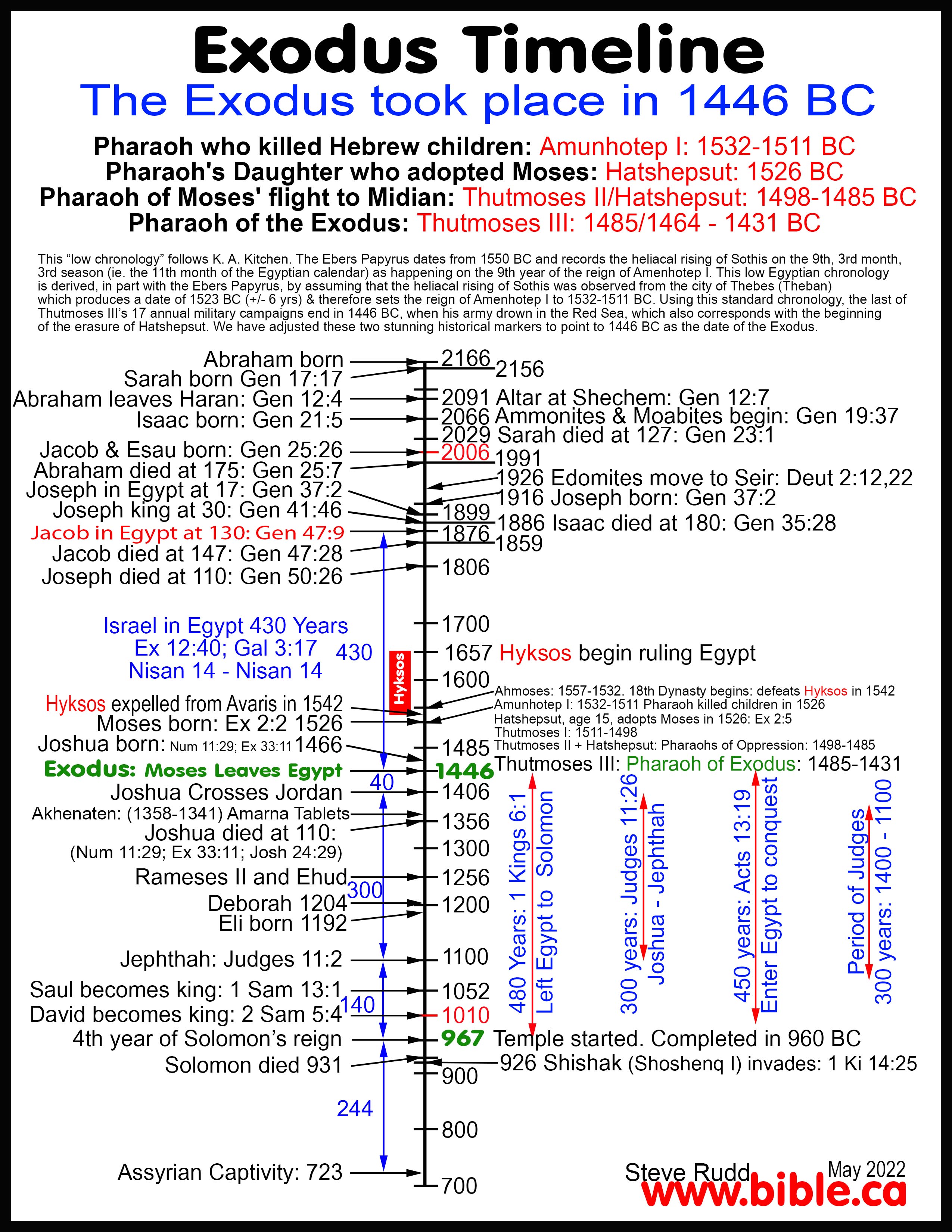
- In 1900 BC, Jacob after he had fled from Laban back to Canaan, he built an altar at the place he camped "before the city of Shechem", not in Shechem. He bought this land: "Now Jacob came safely to the city of Shechem, which is in the land of Canaan, when he came from Paddan-aram,and camped before the city. He bought the piece of land where he had pitched his tent from the hand of the sons of Hamor, Shechem's father, for one hundred pieces of money. Then he erected there an altar and called it El-Elohe-Israel." Genesis 33:18-20
- In 1900 BC, just before Jacob moved from Shechem to Bethel, he hid the idols of his family under the "oak of Moreh" which was the very spot where Abraham had built an altar: "So they gave to Jacob all the foreign gods which they had and the rings which were in their ears, and Jacob hid them under the oak which was near Shechem." Genesis 35:4
- In 1883 BC, Joseph was sold into slavery. Jacob sent Joseph to Shechem to find his brothers, who had moved on to Dothan, where they betrayed him: "Israel said to Joseph, "Are not your brothers pasturing the flock in Shechem? Come, and I will send you to them." And he said to him, "I will go."" Genesis 37:13
- Joshua lived 1460 - 1350 BC: Joshua is described as a young man, a youth and was about 20 years old when Israel left Egypt in 1440 BC: (Ex 33:11; Num 11:28). Joseph was called "a youth" at age 17: Genesis 37:2. Joshua was chosen by Moses to fight Amalek at (Exodus 17:9)Rephidim. It is truly remarkable that a 20 year old was given the responsibility of leading the armies of Moses. Since the exodus was 1440 BC and Joshua lived to be 110 years old. (Joshua 24:29) This means Joshua was born about 1460 BC and died 1350 BC. This means that Joshua began serving Moses at age 20, and served Moses for 40 years in the wilderness and then 50 years in Canaan after crossing the Jordan.
- In 1400, when Israel crossed the Jordan, the tabernacle was first set in the Gilgal (Josh 4:19).
- In 1390 BC, Joshua traveled from Gilgal, where the tabernacle was located, to Mt. Ebal beside Shechem to built the "altar of Joshua". The ark of the covenant was taken to Mt. Ebal and used in the blessings and curses ceremony, while the tabernacle remained at Gilgal. Josh 8:30
- In 1385 BC, the tabernacle then moved to Shiloh (Josh 18:1,10) where he divided up the land by lot (Joshua 19:51). Shiloh was the central gathering point for Israel at the time of Joshua: "When the sons of Israel heard of it, the whole congregation of the sons of Israel gathered themselves at Shiloh to go up against them in war." Joshua 22:12.
- In 110 AD, Josephus says that the tabernacle was first at Gilgal, then Shiloh after which Joshua built the Altar on Mt. Ebal. The correct order was Gilgal, Ebal, Shiloh: "The fifth year was not past, and there was not one of the Canaanites remained any longer, excepting some that had retired to places of great strength. So Joshua removed his camp to the mountainous country, and placed the tabernacle in the city of Shiloh, for that seemed a fit place for it, because of the beauty of its situation, until such time as their affairs would permit them to build a temple; and from thence he went to Shechem, together with all the people, and raised an altar where Moses had beforehand directed; then did he divide the army, and place one half of them on Mount Gerizim, and the other half on Mount Ebal, on which mountain the altar was; he also placed there the tribe of Levi, and the priests. (And when they had sacrificed, and denounced the [blessings and the] curses, and had left them engraved upon the altar, they returned to Shiloh. (Josephus, Antiquities 5.1.19, 68-70)
- In 1385, Shechem became a central "city of refuge" for Ephraim and Manasseh: "They gave them Shechem, the city of refuge for the manslayer, with its pasture lands, in the hill country of Ephraim, and Gezer with its pasture lands," Joshua 21:21 (Josh 20:2,7; 1 Chronicles 6:67)
- In 1380, From Shiloh, Joshua sent the tribe of Reuben transjordan for their inheritance: Joshua 22:9. The sons of Reuben built an exact replica of the altar of burnt offering in the tabernacle at Shiloh on the east side of the Jordan which created a huge problem. Altars had to be endorsed directly by God or else they were considered apostate and rebellious: "Thus says the whole congregation of the Lord, 'What is this unfaithful act which you have committed against the God of Israel, turning away from following the Lord this day, by building yourselves an altar, to rebel against the Lord this day?" Joshua 22:16 "Therefore we said, 'It shall also come about if they say this to us or to our generations in time to come, then we shall say, "See the copy of the altar of the Lord which our fathers made, not for burnt offering or for sacrifice; rather it is a witness between us and you." '" Joshua 22:28
- In 1360 BC Just before Joshua died, the tabernacle "sanctuary of the Lord" was moved from Shiloh to Shechem and placed near the Oaks of Moreh. Joshua gathered all the people there for his farewell address: "Then Joshua gathered all the tribes of Israel to Shechem, ... and they presented themselves before God." (Joshua 24:1). He also set up a memorial stone directly underneath the very oak that Abraham had built an altar near and Jacob had hid his family idols underneath: "So Joshua made a covenant with the people that day, and made for them a statute and an ordinance in Shechem. And Joshua wrote these words in the book of the law of God; and he took a large stone and set it up there under the oak [of Moreh] that was by the sanctuary of the Lord. Joshua said to all the people, "Behold, this stone shall be for a witness against us, for it has heard all the words of the Lord which He spoke to us; thus it shall be for a witness against you, so that you do not deny your God." Then Joshua dismissed the people, each to his inheritance." Joshua 24:25-28
- In 1360 BC, Joshua died and was buried at Timnath-serah: Josh 24:30. At the same time Joseph, who had died in Egypt 440 years earlier (1800 BC), was buried at Shechem in a plot of land Jacob had bought 540 years earlier (1900 BC): "Now they buried the bones of Joseph, which the sons of Israel brought up from Egypt, at Shechem, in the piece of ground which Jacob had bought from the sons of Hamor the father of Shechem for one hundred pieces of money; and they became the inheritance of Joseph's sons." Joshua 24:32; Genesis 33:18-20; Acts 7:16.
- Today, the tomb of Joseph is located east of modern Nabulus between Tel Balata and Sychar: "one of the tombs whose location is known with the utmost degree of certainty and is based on continuous documentation since biblical times. (Zvi Ilan, Tombs of the Righteous in the Land of Israel, p. 365)
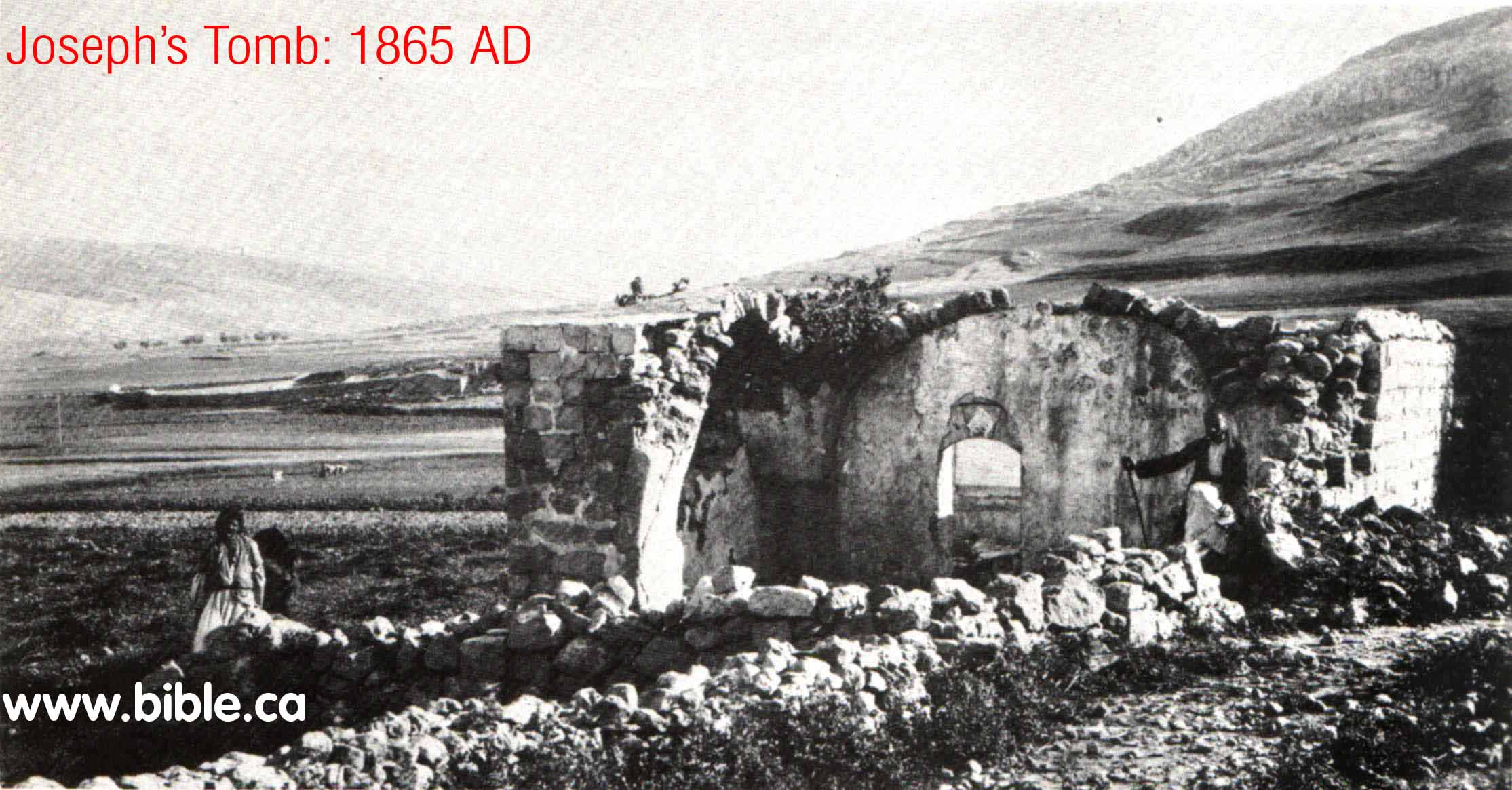 . .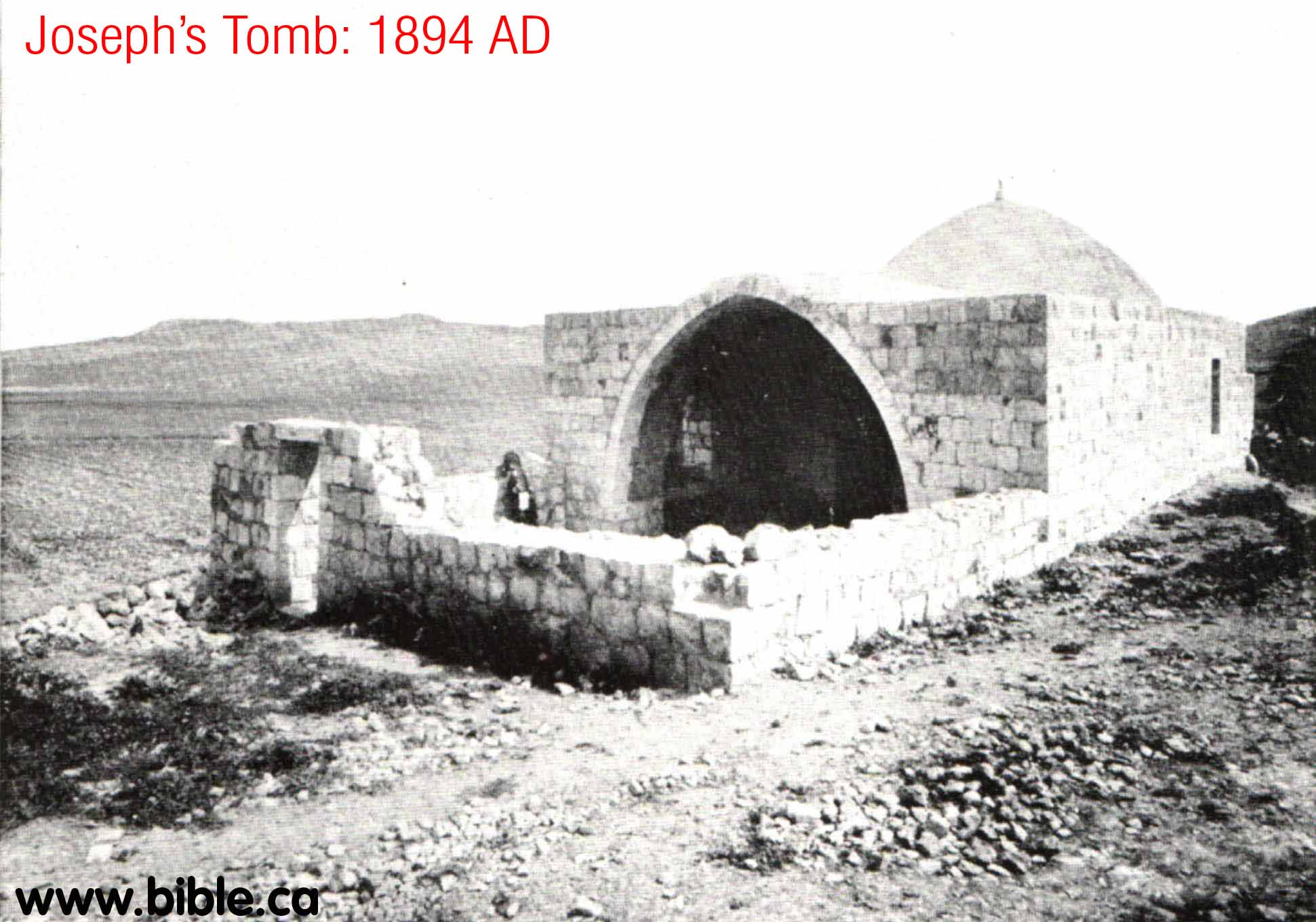
- On 7 October 2000, Joseph's Tomb, the third most holy place in Judaism, was destroyed by Muslims. It is located east of modern Nabulus between Shechem (Tel Balata) and Sychar at the foot of Mt. Ebal. It had come under attack and the Israeli Defense Forces (IDF) withdrew after gaining reassurances from the Palestinian Authority (PA) that they would protect the site in accordance with their obligations under the Oslo Accords to protect holy sites. Two hours after the withdrawal Muslims began destroying the site. It was burned and torn down stone by stone, then bulldozed. It was immediately declared a Muslim holy site.

D. The ceremony in Shechem, Mt. Ebal and Mt. Gerizim.
|
|
Scientists have tested this natural amphitheater many times and it works very well. This proves the ceremony of Joshua 8 could have really happened here.
Deut 11:22-30; 27:1-13; Joshua 8:30-35
|
- There was an elaborate and unique ceremony that took place at Shechem. It must have been an absolutely spectacular thing to be part of.
- In 110 AD, Josephus says recounts the ceremony: "from there he went to Shechem, together with all the people, and raised an altar where Moses had beforehand directed; then did he divide the army, and place one half of them on Mount Gerizim, and the other half on Mount Ebal, on which mountain the altar was; he also placed there the tribe of Levi, and the priests. (And when they had sacrificed, and denounced the [blessings and the] curses, and had left them engraved upon the altar, they returned to Shiloh. (Josephus, Antiquities 5.1.19, 68-70)
- It is clear that the ark of the covenant was located in the valley between Mt. Ebal and Mt. Gerizim. Joshua stood beside the ark. The elders, priests and leaders of the people divided up into two groups and stood directly beside each side of the ark. The 2.5 million people then divided up into two groups: 7 of the tribes on the slopes of Mt. Gerizim and the other 6 tribes on the slopes of Mt. Ebal. Remember that Levi was not one of the twelve tribes and Joseph was represented by two tribes.
- There were 22,000 Levites: Numbers 3:39 who spoke the curses and blessings were read by all the Levite priests to the people. This would make it easy to hear on each mountain as each of the corresponding blessings and curses were read. 22,000 men can create quite a volume.
- The Census of Numbers 26, at just before crossing the Jordan: 601,730 of men over the age of 20. This number did not include Levi who was not enumerated. Curses on Mt. Ebal: Reuben + Gad + Asher + Zebulun + Dan + Naphtali = 307,930. Blessings on Mt. Gerizim: Simeon + Levi + Judah + Issachar + Joseph (Ephraim + Manasseh) + Benjamin = 293,800. But Levi was not enumerated in the census. The difference in numbers between the two sides was 14,130 and when we add in the women and children from Levi, that brings it up about equal. We know from Numbers 3:39 that there were 22,000 male Levites aged 20 and older. But many of these would likely be included in the actual pronouncements of the blessings and curses. So in the end, the numbers on each of the two mountains was pretty close to an equal split of about 1.25 million on each side for a total of 2.5 Million. Today, this many people easily fit into areas much smaller than the space Israel had on the two mountain tope, sides and valleys in front of the ark.
- When the priests read the curses to the people sitting on Mt. Ebal, the people sitting on Mt. Ebal would reply "Amen" after each curse was pronounced. The same was repeated for the blessings to the people sitting on Mt. Gerizim. "The Levites shall then answer and say to all the men of Israel with a loud voice, 'Cursed is the man who makes an idol or a molten image, an abomination to the Lord, the work of the hands of the craftsman, and sets it up in secret.' And all the people shall answer and say, 'Amen.'" Deuteronomy 27:15
- Joshua was to do a burnt offering sacrifice of an animal at the altar. It is not clear when this offering was made in respect to the timing of the ceremony. It could be that the offering was made before, during or after the blessings and curses were pronounce.
- The altar appears to be a one time use structure never intending to replace or compete with the altar of burnt offerings of the Tabernacle.
- The town of Shechem is a natural amphitheater which has been tested several times to see if the ceremony of Joshua 8 is possible. Each test proved the ceremony was easily possible, especially if 22,000 priests are shouting and one million people are replying!
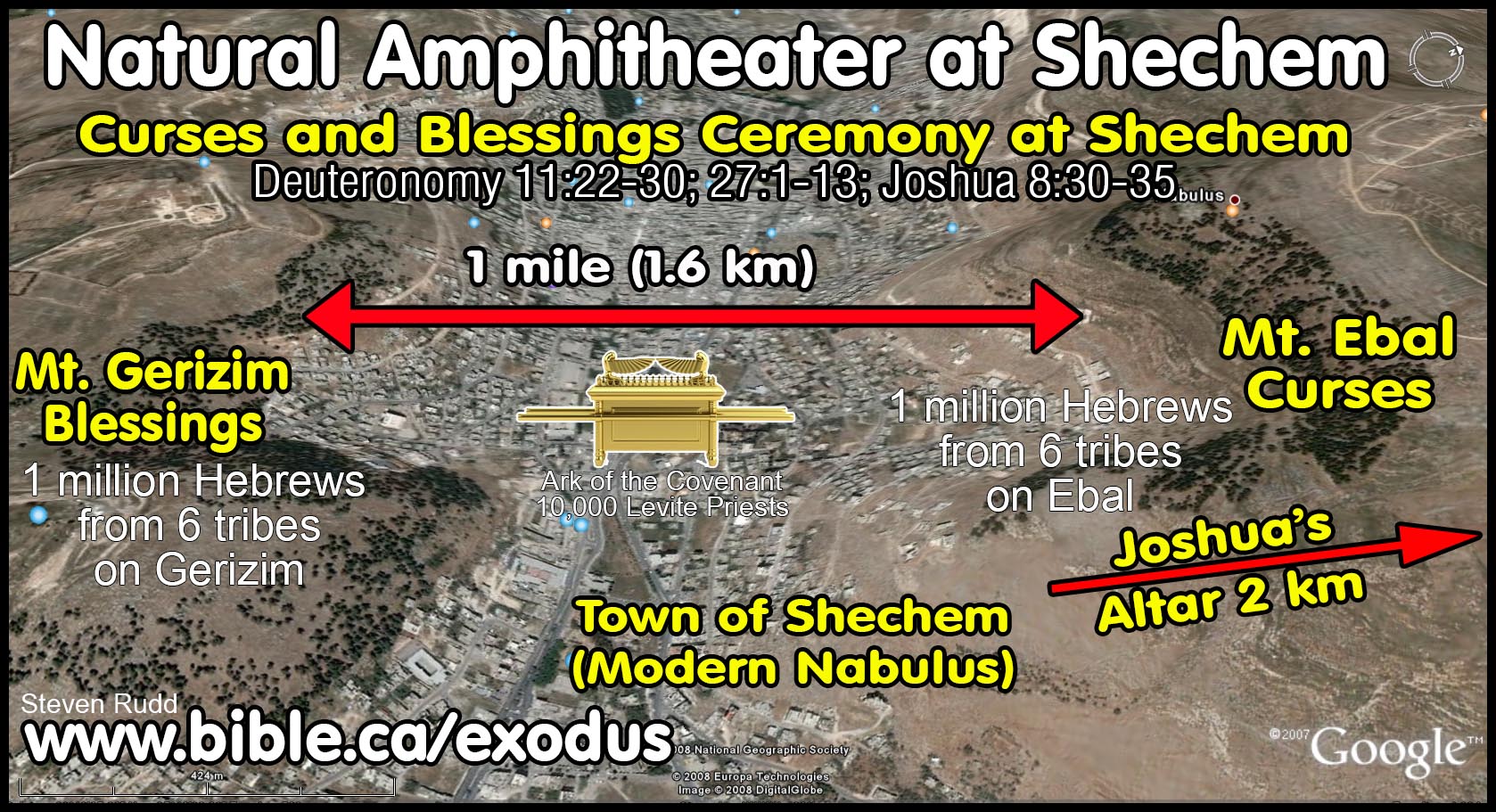
- The location of the altar was about 3 km north of where the ark was located. There is no reason why the altar had to be located within view of the people.
- The location of Joshua's altar that Adam Zertal discovered in 1980 doesn't disqualify the traditional Mt. Gerizim from being the correct location for that mountain. Zertal mistakenly thinks the location of the altar proves the Samaritans chose the wrong mountain in 500 BC as Mt. Gerizim. Zertal has chosen a new different mountain for Mt. Gerizim because of this. (see below) We disagree with Zertal and accept the Samaritan location for Mt. Gerizim.
E. The location of Joshua's Altar on Ebal:
- Here is what the mound of rocks looked like before excavation. "The excavators were surprised to find that the site had been deliberately buried under a layer of stones before it was abandoned, presumably to prevent its desecration. Perhaps abandoning Mt. `Ebal was related to establishing a sacred site at Shiloh and the focus of the Israelite population shifting from the territory of Manasseh in the north to that of Ephraim in the central part of the country." (Adam Zertal)

- Ancient Shechem (Modern Nabulus) is located between Mt. Ebal and Mt. Gerizim.

- Here is an aerial view of Joshua's Altar site:
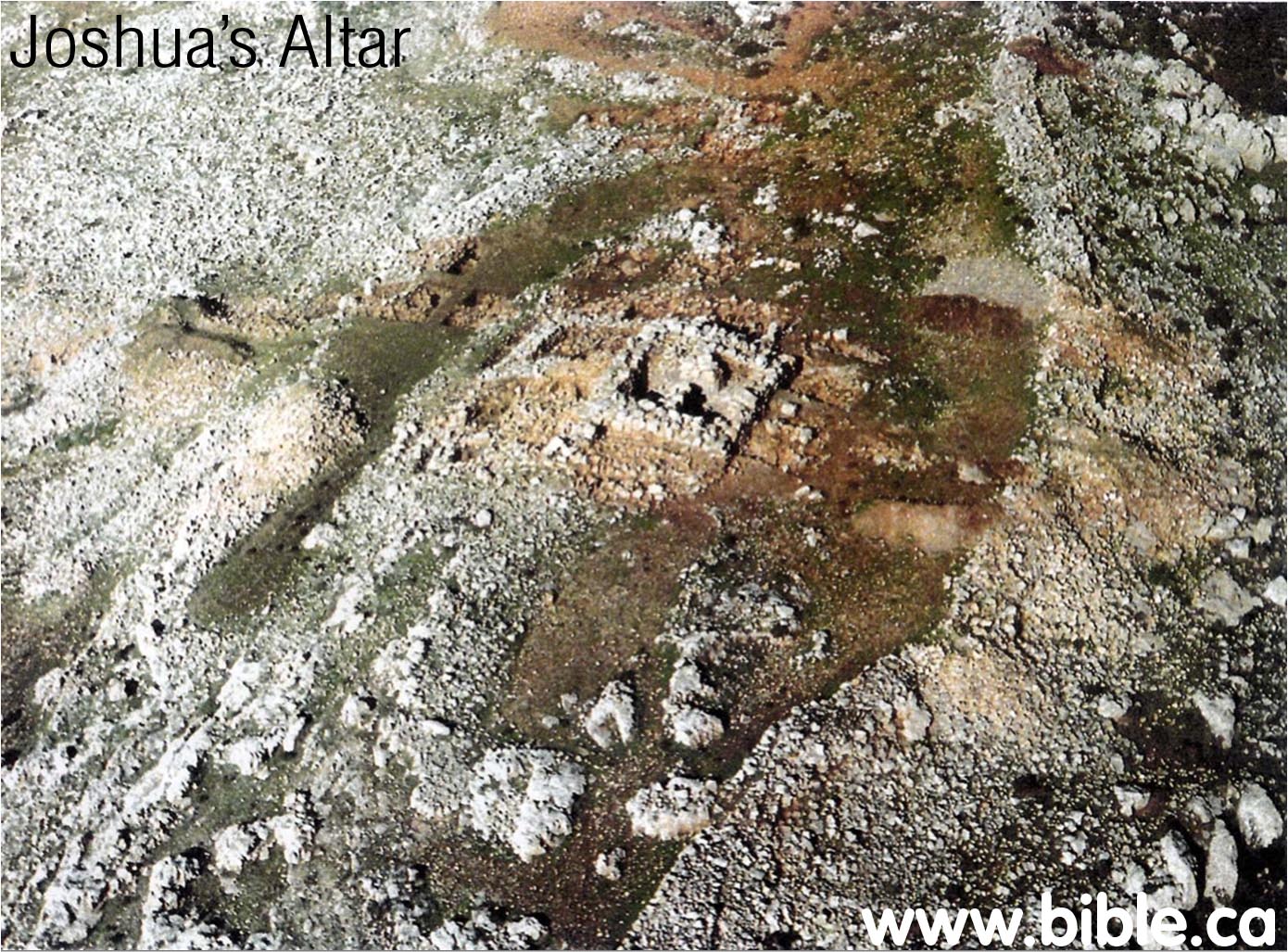
- A close up view of the site with an aerial photo inset

F. The rectangular Hebrew altar of 1250 BC:
- If you visit the site today, this is what the altar looks like. This altar was built in 1250 BC and is a Hebrew altar.

- Here is the site early on in the excavation:
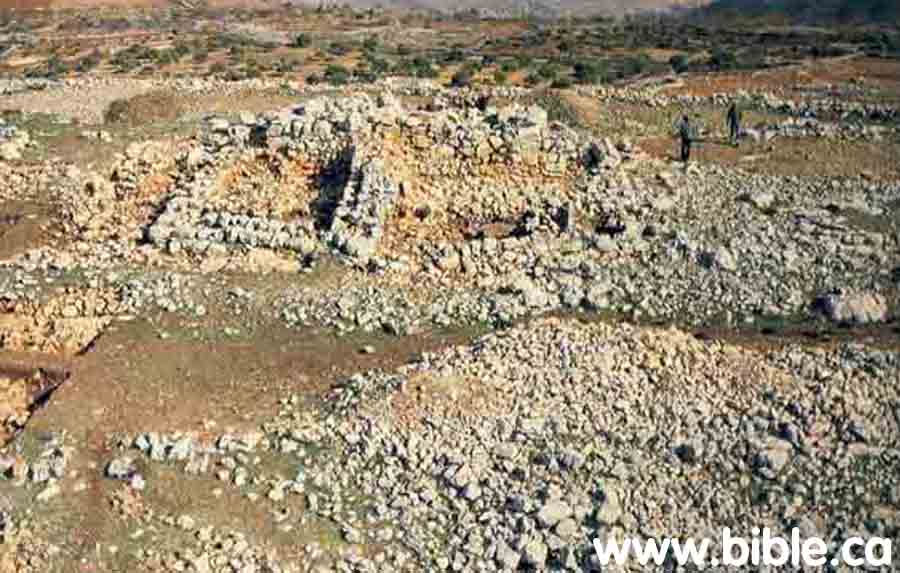
"A ramp of unhewn stones, 4 feet wide by 23 feet long, rises to the top of the platform from the southwest. The gentle incline, easily climbed and the presence of the ramp itself accord with the explicit scriptural injunction: "Neither shalt thou go up by steps unto Mine altar, that thy nakedness be not uncovered thereon" (Exodus 20:26)." (Adam Zertal)
- The four corners of the altar point to the four corners of the compass instead of the usual Hebrew custom of the sides facing to the compass. "Yet another detail of our altar suggests its Mesopotarnian roots. The four corners of our altar point north, south, east and west. In Mesopotamia, all sacred structures were oriented so that each corner was directed to a point on the compass. By contrast, the Second Temple was oriented so that its sides, not its corners, faced the four directions of the compass. The Temple altar had this same orientation." (Adam Zertal) "It is interesting that the corners of the platform point due north, south, east and west. The practice of constructing sacred buildings so that their corners pointed in the directions of the compass was characteristic of Mesopotamia throughout its history. Temples, as well as altars, were always oriented in this way. The practice stems from the nature of the religion which developed in Babylonia and Assyria, based on four principal natural forces: earth, fire, air and water." (Adam Zertal)
- This must be an altar, it cannot be a house or a watchtower: "Our initial thought was that this was a farmhouse or perhaps a watchtower. But it was different in almost every respect from the farmhouse's watchtowers we know from examples all over the country. When we reached the bottom of the structure, we immediately noticed that there was neither a floor nor an entrance. The walls were laid directly upon bedrock. Obviously, we were not dealing with a building that had been regularly lived in. To explain the structure as a watchtower is even less satisfactory, because there is no reason for a watchtower to be here. Mt. Ebal has always been an obstacle to transportation. All transportation routes have avoided it. There is, thus, no road for a watchtower to observe. And there were no Iron Age settlements nearby." (Adam Zertal)
- This is a drawing of the site discovered in 1980 by Zertal:
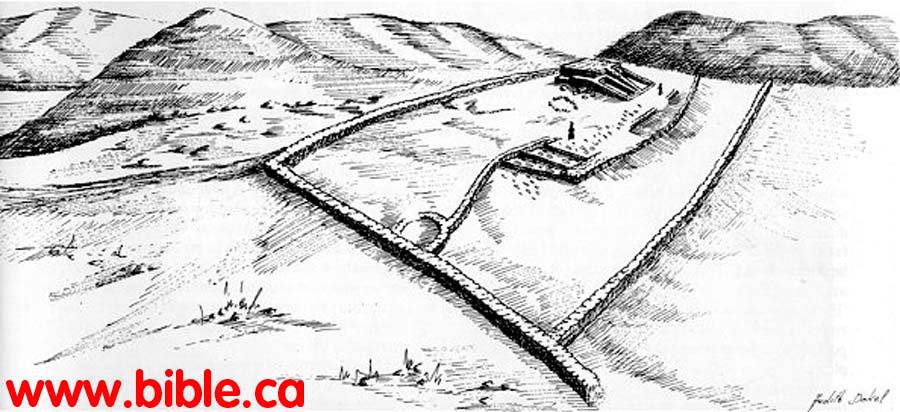
- Kempinski, who is a Bible trasher, has suggested that the 1250 BC altar at Mt. Ebal is exactly like the installations at Giloh. Superficially there appear to be similarities, but Kempinski has been soundly refuted in this regard and it is generally agreed that Mt. Ebal is not a watchtower. "According to Aharon Kempinski, this plan of Giloh, an Iron Age site near Jerusalem, shows a square structure, top, left, similar in shape and details to the Mt. Ebal structure that Adam Zertal identifies as an altar. The plan has been drawn by Amihai Mazar, the excavator of Giloh. Mazar identifies this building as a watchtower, built in Iron Age II (1000-586 B.C.) and reused in the Middle Ages. Mazar's plan shows a wall built around the Iron Age settlement that, according to Kempinski, closely resembles Zertal's temenos wall at Mt. Ebal." (Joshua's Altar—An Iron Age I Watchtower, Aharon Kempinski, 1986, BAR)

- "In Level I (the later level), around 1200 B.C., the site underwent a complete change. A large burnt-offering altar was erected upon the earlier cultic area, burying it under the debris of the earlier cultic activities and leaving the central feature of the earlier stage or platform in the exact center of the new one. The altar complex included courtyards, installations, a surround on the altar and ramps leading to it—all typical of the Israelite-altar model found in the Book of Ezekiel and the Second Temple altar described in Mishnaic sources. At the same time that the altar was built (in Level I) an inner temenos wall was added, surrounding the site and enlarging the earlier cultic area four times. There were no structures besides the altar within the inner temenos wall. A wide gateway in the inner temenos wall was constructed. Also, a second and much larger enclosure wall (the outer temenos wall) was constructed, thus creating one enclosure inside the other. No doubt, this ritual center was intended mainly for the gathering of a relatively large number of people. The evidence for this lies in the special location of the enclosure, in a way that the viewer could see the ceremonies on the altar from outside the enclosure wall. How long did this cultic center exist? Archaeologically speaking, not very long. The evidence of the pottery cannot be stretched beyond the middle of the 12th century B.C. (The most recent analysis of Level I pottery has necessitated raising the date of the end of this level about 50 years.) I would estimate this center's existence to be not more than 50 years. The site was never destroyed, however. Rather, it was deserted while in a complete and finished state. Why? We do not yet know. Its desertion, just as its erection, seems somehow to have been the result of a deliberate decision, and not of a natural development. There was no reason for such an abandonment based on environmental conditions. But such desertions are well known at Iron Age I sites; Mt. Ebal is no exception. The desertion of the site resulted in the fact that we now have a complete and untouched Israelite cultic center from the time when monotheism began—to be studied by archaeologists, Biblical scholars and other concerned scientists, both Jewish and Christian, from all over the world." (How Can Kempinski Be So Wrong!, Adam Zertal, BAR, 1986 AD)
- Here are two drawings of the small ramps on the left and right hand side of the altar. These were understood when reading the Mishna. "Adjacent to the northern side of the ramp is another small, narrow wall, somewhat lower than the one beside it. It turns out that this smaller ramp, which greatly intrigued us since we could find no constructional logic for it, was intended as a means of ascent for the priests to reach another part of the altar, the surround or ledge. This is none other than the above-mentioned terrace adjacent to the altar, which was reached by climbing the smaller ramp adjacent to the larger one. All this became clear to us only after reading the extremely precise Mishnaic descriptions of the Second Temple in Jerusalem: "The altar was thirty-two [cubits] by thirty-two [cubits]. It rose up one cubit and receded one cubit; this was the base. [Thus] we find left [a square space of] thirty by thirty. [The next part built up on the base] rose up five [cubits] and receded one cubit; this was the surround. Thus we are left with twenty-eight by twenty-eight... And there was a ramp at the south of the altar, thirty-two cubits by sixteen cubits in width..." (Middot 3:1-3). About the smaller ramp the Mishnah writes: "How was this performed? The priest went up the ramp and passed around the ledge, and came to the southeast corner..." (Zevahim 5:3).The mishnaic description of the altar depicts a sort of graduated tower in which each successive level is somewhat smaller than the one below it. In the Second Temple period there were three levels, whereas the altar on Mt. 'Ebal has only two. These levels are formed by the surrounding ledge (see photographs and reconstruction). Interestingly enough, the future altar, described by Ezekiel, which most scholars believe reflects the altar in the First Temple, was also built in successive levels: "And these are the measures of the altar by cubits - the cubit is a cubit and a handbreadth: the bottom shall be a cubit, and the breadth a cubit, and the border thereof by the edge thereof roundabout a span; and this shall be the base of the altar. And from the bottom upon the ground to the lower settle shall be two cubits, and the breadth one cubit; and from the lesser settle to the greater settle shall be four cubits, and the breadth a cubit: And the hearth shall be four cubits; and from the hearth and upward there shall be four horns"(Ezekiel 43:13-15)." (Adam Zertal)
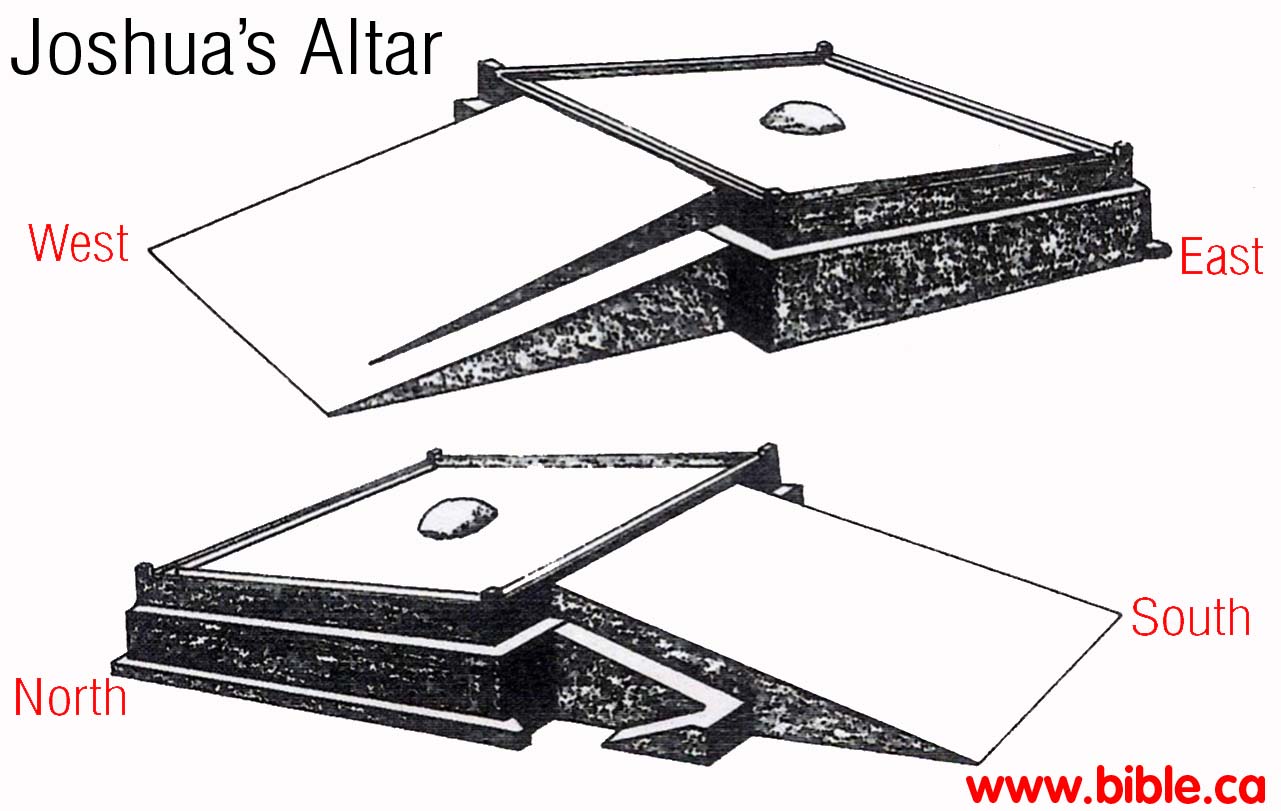
G. Joshua's actual Altar: The older round altar of 1400 BC:
NOTE: Here is a brief account by Adam Zertal in 2004, of the round structure underneath the rectangular altar. We must make it clear that Adam Zertal does not call the round structure an altar, WE DO. He dies not date it to 1400 BC, WE DO. He dates the round structure 50 years older (1300 BC) than the rectangular altar we see today on top (1250 BC).
"As we dug deeper into the strata of fill, it became clear that the cultic center, even the large altar itself, had been preceded by another cultic site. On the natural bed-rock, beneath the geometric center of the altar, we discovered a round structure, about 6.5 feet in diameter, built of unhewn stone. It was found full of yellowish material, above which was a thin layer of ashes and burned animal bones. At first we thought this was part of the altar. Shortly, however, levels of habitation preceding the large altar emerged in other parts of the site as well. Around the early, circular structure were signs of further cultic activity: an earthen floor paved with pottery, a large collar-rimmed jar, and other vessels. ... A rough wall, constructed of large boulders, was built to enclose a sacred area. In the center was a round structure, possibly used for sacrifice, and around it other activities took place." (Adam Zertal, 2004)
"After several decades of the site's existence, a revolutionary change occurred there. From a small place, sacred to one family or perhaps to the region, it suddenly became a central cultic site of supra-tribal or perhaps even national importance to the entire alliance of the tribes. A new temenos was built, as well as a broad, paved gateway. A large and complex burnt offering altar, comprised of the platform itself, a surround, a small and a large ramp, and paved courts, was built on top of the earlier round structure. When this larger complex was constructed, so it seems to us today, the remains of bones and ashes from the earlier rites were gathered together and used to fill the new altar. Burying the earlier structure in the center of the newer one apparently symbolized the continuity of the tradition of sanctity attached to the site." (Adam Zertal, 2004)
|
|
"When we excavated under the fill, we found some curious stone-built installations. One installation consisted of a circle made of medium-sized field stones laid on bedrock andlocated at the exact geometric center of the structure. The outside diameter of the circle of stones was 6.5 feet. The circle of stones was filled with a thin, yellowish material that we have not yet identified. ...
|
On top of this yellowish layer was a thin layer of ash and animal bones. This installation as well as the others inside the structure were clearly used in some fire-related activity before the structure was built. It is quite obvious, now, that the installations at the bottom of the structure represent an earlier phase, and the large structure itself represents a later phase-both from the same Iron I period." (Adam Zertal)
|
|
"Strange installations in the northern court of the altar complex. Five box-like installations built of stone were discovered in a row near the ramp that ascends the altar. Some contained large quantities of ash and burned bones from animal sacrifices, others complete pottery vessels unearthed in situ. This discovery, like that of the altar, reveals the hitherto undisclosed world of religious ritual of the early Israelites." (Zertal 2004)
|
|
|
|
"In all three renderings, a lower ledge colored blue surrounds three sides of the top of the altar and continues as a narrower, lower ramp along the side of the broad, main ramp. The rectangular structure and the main ramp leading up to it are colored yellow. In the plan and the reconstruction of the Mt. Ebal altar the circular installations are colored green." (Zertal)
|
|
|
Here is a reconstruction of what the altar would have looked like on Mt. Gerizim. It is 6.5 feet in diameter and built on bedrock.
We disagree with Adam Zertal when he dates both the round altar and the rectangular altar that was built directly on top of it to within 50 years. "I would estimate this center's existence to be not more than 50 years." (How Can Kempinski Be So Wrong!, Adam Zertal, BAR, 1986 AD) While this is entirely possible, we have a better solution.
|
Here is an actual round altar that dates back to the exodus found at Gilgal. It serves as a model for what the round altar of Joshua looks like at Mt. Ebal.
|
|
- We believe that the round altar is the one Joshua built in 1400 BC and the rectangular altar was built directly over top of the round one 150 years later in 1250 BC. It could be that the site has been used by Abraham (2000 BC) and Jacob (1930 BC) to build altars before Joshua came in 1400 BC. Then during the time of Deborah the Judge, another altar was built on top.
- Four levels of fill in the rectangular altar area: We believe Adam Zertal is wrong to date the circular altar to the same time as the rectangular one above it. It seems obvious that when they began to build the rectangular altar in 1250 BC, that they scraped everything off the immediate surface and used it as fill directly on top of the circular altar. This explains why most of what was found in connection with the circular altar is dated to 1250 BC. Fill represents the time in which the new structure was made, not the thing being buried. "The empty space itself was filled by the builders with four deliberately laid strata of fill. The lowest stratum contained a considerable quantity of ashes, above it was a stratum of dirt and stones, then another thick layer, approximately three feet deep, containing a large quantity of black ashes. In these ashes were hundreds of animal bones, some of which had been burned in a hearth." (Zertal)
- An Egyptian cartouche was discovered by Zertal at the site of Tuthmosis III dated to 1400 BC. Since this has been found here, we believe it is clear that this round altar underneath the present structure, is Joshua's Altar. aerial
- This brings us to a critical point of this entire discussion about Joshua's Altar. We believe that the reason Adam Zertal did not date the round altar more than 50 years older than the rectangular altar, is because he mistakenly believes the exodus took place in 1250 BC. In his mind, if the round altar (as we call it, not Zertal) was much older than the rectangular altar, then it would predate the time Israel crossed the Jordan. It would mean that the round altar was a pagan altar built by the Canaanites. Such would be enough to prove the rectangular altar we see today could not have been built by Joshua, because no Hebrew worshipper of Yahweh would ever build an altar overtop of a pagan altar. Of course one way around this is to speculate that Abraham or Isaac built the altar and God led him to the exact same spot. While this is possible, it is unlikely and where is the archeological evidence?
- We would humbly invite Adam Zertal to read this paper on the Exodus being at 1440 BC, not 1250 BC. The altar changed him from a Bible skeptic to a Bible believer. We suggest that he go all the way and accept the Bible's date of 1400 BC when Joshua built his altar. Zertal probably knows enough about the site that he could actually make a good case for this round ring of rocks being dated to 1400 BC, but simply could not because he mistakenly believed the exodus happened in 1250 BC. If he accepts the Bible's date of the exodus of 1440, then he can date the 6.5 foot diameter circle of stones up to 150 years earlier and still be within the time Israel crossed the Jordan. He can contact the author by email here if he wishes further discussion.

- Hebrew altars are generally square. Pagan Altars are square. This circular altar is the second one we know of. Another round altar built of stones is found at Gilgal.
- Israel Finkelstein, a known Bible trasher archeologist, may have shot himself in the foot again. He views the exodus and the kingdoms of David and Solomon as myths. In an effort to refute the truth that Israel actually settled Canaan as the Bible said, he argues that the Mt. Ebal site is older than what he believes is the date of the exodus. Problem is, he believes the exodus was 1250 BC, when in fact it was 1400 BC. "Adam Zertal, the excavator of a twelfth century hilltop site on Mt. Ebal, describes the site as cultic. A number of installations, including what may have been the remains of a stone altar, were encircled by a stone wall. Among the artifacts recovered were animal bones. These, as well as biblical references to Joshua's altar on Mt. Ebal (Deut 11:29; 27: 4-8; Josh 8:30-32) have led some to conclude that this was a open-air cultic site, perhaps an altar sacred to the early Israelites (Zertal 1986/1987; A. Mazar 1990b: 348-50). Kempinski suggested that the search for Joshua's altar should instead take place on Mt. Gerizim, in the vicinity of the Samaritan Temple (1993: 237*). Finkelstein agrees that the Mt. Ebal site was cultic but dates it to an earlier period, since he identifies ninety percent of the potsherds as Middle Bronze Age (1995 The Great Transformation: The "Conquest" of the Highlands Frontiers and the Rise of the Territorial States. Pp. 349-65 in The Archaeology of Society in the Holy Land, ed. T. E. Levy. London: Leicester University.p 359). Others disagree with the cultic identification, suggesting that its central stone installation was the foundation of a farmhouse or fortress and not an altar (Kempinski 1986; Dever 1992b: 32-34; Fritz 1993: 185). According to Coogan, the site was cultic in function, but may not have been Israelite, let alone the location of Joshua's altar (1990: 25-26). For a discussion of the difficulties in explaining the artifactual and architectural evidence on Mt. Ebal, see Gilmour 1995: 108-20. See Zertal 1993: 377 for a brief summary of the controversy." (Archaeology and the Religions of Canaan and Israel, Beth Alpert Nakhai, 2001 AD)
- At this point, we really cannot be sure until further seasons are spent excavating at the site to determine exactly what the origin of this circular altar is. We would like to see the entire rectangular altar carefully removed so it can be reconstructed later. This way excavations can take place below the rectangular altar of 1250 BC, down to the 1400 BC bedrock level of the circular altar. The significance of the discovery of a scarab of Tuthmosis III, dated to 1400 BC, found at the site cannot be underestimated.
H. Egyptian scarabs, pottery and bones found:
- Most exciting and promising is the scarab found from Tuthmosis III, who is the pharaoh of the exodus in 1400 BC.
- Zertal also found pottery that dated to 1250 BC.
- Zertal also found 8 pieces of plaster with no writing on it. Scientific testing has been done, but results are pending.
- In the altar was found a collection of 942 bones from 50-100 individual animals. These were scientifically Analyzed by Hebrew University of Jerusalem and determined to be all kosher one year old animals. The species included: Goats, Sheep, Cattle and one gazelle: "When compared to other Iron Age habitation sites, some interesting differences are apparent between Ebal and the others. The first is the difference in emphasis in species present. Equids [the genus that includes horses, donkeys, etc.], pigs, carnivores and gazelle (both wild and domesticated) are absent at Ebal, but present at the Iron Age sites of Lachish, Tel Qasile, Tel Miqneh, Tel Dan, Hazorea, Tel Michal, Shiloh, Beer-Sheva, Tel Masos and Izbet Sartah. The species represented and their frequency suggest that only edible animals are present at Ebal, while at other sites animals possibly used for various purposes (such as equids) are present. The specific absence of gazelle and pig remains is of interest considering their presence in the immediate vicinity of the site, both in antiquity and today. This is further emphasized by the high frequency of fallow deer, which shares a similar environment to wild pig, though the latter does not appear to have been hunted at Ebal. ... An aspect which further highlights the difference between Ebal and habitation sites is the number and distribution of burnt or scorched bones from Ebal (28 bones forming 9% of the diagnostic bone sample) compared with 8 bones (0.8%) from the Iron Age levels at the City of David (from a bone sample of approximately 1,000 bones). Wapnish has reported that 15% of the equid material (total of 65 bones) from Tel Jemmeh had cut marks and burning. Though the exact period distribution of this 15% is not specified, this and the City of David data indicate that the burnt material from Ebal is slightly, but not significantly higher in proportion to the total bone sample. However, the most salient feature of the Ebal burnt material is the concentration of the bone in the altar area (17 of the 28 bones or 61% of the total burnt bone samples from the site). This further suggests some difference in activities between the areas at the site. ... Ebal differs from other Iron Age sites in the absence of certain species such as equids, pigs, gazelle and carnivores and in the presence of a high frequency of fallow deer. In addition, the comparative data on burnt bones suggests a frequency at Ebal, slightly higher than that expected from a bone sample of this size. ... All of these features indicate a different pattern of animal utilization at Ebal to that found at Iron Age habitation sites. ... It is suggested that the Ebal faunal assemblage represents a narrow range of activities either in function or time. The absence of animals prohibited for consumption but frequent at other Iron Age sites, suggests conformity with Biblical tenets." (Faunal Remains from the Early Israelite Site of Mt. Ebal," Liora Kolska-Horwitz, Department of Zoology, Hebrew University of Jerusalem, Conclusions)
|
|
Scarab found from the pharaoh of the Exodus:
This scarab was found inside an offering structure. It displays a kneeling Egyptian archer and the cartouche of Tuthmosis III, the great Egyptian conqueror.
When Ramesses II reigned (about 1290-1224 B.C.) this carnelian scarab was issued to honor Tuthmosis III (1479-1425 B.C.). Found recently just north of the Mt. Ebal altar, the rare artifact pinpoints the date of the altar to this period in the 13th century B.C. What looks like a capital letter "B" in the center of the scarab is a double bow held by a kneeling archer, far left. The cartouche of the great conqueror Tuthmosis III appears at the far right. At the top is a crawling salamander, an Egyptian symbol of abundance.
|
"A scarab, or Egyptian-style signet ring, found in the altar's fill. The use of scarabs - seals and charms prevalent in ancient Egypt -spread over the entire ancient East. This seal, carved in the shape of a beetle an insect sacred to the ancient Egyptians -contains Egyptian religious symbols and scenes on its lower portion. Relatively crude in its workmanship, the scarab's ornamentation is geometric: a four-petal rosette with shoots between the petals, and a Uraeus (Egyptian cobra) emanating from each shoot. Discovering this scarab in the altar's fill enabled archaeologists to date the entire stratum, since the scarab can be ascribed with certainty to the great pharaoh Ramses II and to the latter part of his reign, 1245- 1220 b.c.e. Similar scarabs, dating to the same era, have been found in Egypt and Cyprus." (Zertal)
|
|
|
|
Pottery was found that dates to 1250 BC. Here is a photo of an insitu pot and how it looks today in the Museum.
|
Ritual chalice, or possibly an incense burner, from the 13th century B.C., the period when the altar was built. Made of very light volcanic basalt, the 4.75-inch-high artifact was found at the bottom of the altar.
|
|
I. Mt. Gerizim is located next to Shechem and beside the oaks of Moreh:
- Here is a detailed study of the Samaritans and why they chose Mt. Gerizim as "their Jerusalem".
- The oaks of Moreh were beside Mt. Gerizim and two Bible verses place the oaks of Moreh beside Shechem (modern Nabulus). Genesis 12:6 and Genesis 35:4.
- Judges 9:7 likewise places Mount Gerizim directly beside Shechem: "Jotham went and stood on the top of Mount Gerizim, and lifted his voice and called out. Thus he said to them, "Listen to me, O men of Shechem, that God may listen to you."
- In 325 AD, Eusebius believed that the Samaritan's choice for Mt. Gerizim was wrong and said so in his Onomasticon which he wrote in 325 AD. He likely based this on the Bible verse that said it was opposite Gilgal: "Are they [Mt. Ebal and Gerizim] not across the Jordan, west of the way toward the sunset, in the land of the Canaanites who live in the Arabah, opposite Gilgal, beside the oaks of Moreh?" Deuteronomy 11:30.
- In 325 AD Eusebius chose mountains sometimes called "Tyros" and "Thrax" above Aqaba jabr near Jericho. The Samaritans chose "Jebel es-Slamiyeh" and "Jebel et Tur". These are the traditional locations on all Bible maps today and are the correct locations.
- Here is what Eusebius wrote in his Onomasticon in 325 AD:Mt. Ebal: "Gaibal (Gebal). Mountain in the Promised Land where Moses commanded an altar to be built (at the command of Moses an alter was built). They say (there are) two neighboring mountains facing each other located at (near) Jericho, one of which (is said) to be Garizin [Gerizim], the other Gaibal [Ebal]. But the Samaritans erroneously point out two others near Neapolis (argue for two mountains near Neapolis but they err greatly) since the great distance of one from the other there shows that they are not able to hear one another when calling out from one (hear the voices calling out in turn blessing or cursing as Scripture records)." (Eusebius, Onomasticon 325 AD)Mt. Gerizim: "Garizein (Garizin). Mountain where those calling out the blessing (curse) stood. Read the above mentioned Gaibal (Gebal)." (Eusebius, Onomasticon 325 AD)Gilgal: "Golgol or Galgal. The Scriptures teach this is near Mt. Garisein and Mt.Gaibal. The place of Galgal is in the Jericho region (near Jericho). [Therefore the Samaritans err who would point out Mt.Gairsin and Mt.Gebal near Neapolis which Scripture testifies are near Galgal.]" (Eusebius,Onomasticon 325 AD)Footnote from Onomasticon : This and the following entry can be treated together. The Onomasticon begins by recording the simple biblical information here. The generally accepted tradition is to follow the Samaritan tradition as given here. The two mountains are on either side of Neapolis (K. 4:28) and are Jebel es-Slamiyeh and Jebel et Tur. The Madaba Map reflects this tradition by having them near Shechem (K. 150:1) called Garizin and Gōbel. The pilgrims also recognize this identity. "At Neapolis is Mt Gazaren where the Samaritans say Abraham brought the sacrifice. And to ascend up to the summit are 300 steps. At the foot of the mountain is located a place by the name of Shechem" (Itin. Bourd. PPTI, 18). Zeno and Justinian built churches on Garizein according to Procopius Buildings V, vii, 5-17. Excavation of this area is going on. But Eusebius and Jerome prefer to follow an anti-Samaritan location. The Madaba map hesitates between the two opinions and so locates Gebal Garizeini near Ierichō [Jericho] (K. 104:25). The use of the LXX names in Ierichō region and the Aramaic in the Neapolis area may signify some preference. Since Josephus and the later Byzantines had the correct tradition, this rabbinic tradition must have developed in the late first and early second centuries. Procopius 905C is also confused: "This is situated at the Eastern part of Ierichō beyond Galgal" and he continues by denying the Samaritan tradition. Yet in 908A he seems to accept the Samaritan location and tradition. The two mountains near Jericho are probably those above Aqaba jabr sometimes called Tyros and Thrax. The Roman road to Jerusalem passed between them. In Interpretation of Hebrew Names "Gebal, ancient abyss or stone building" (87). (Eusebius, Onomasticon 325 AD)
- In 542 AD, the Madaba map places the two mountains twice, in two different locations: On the Madaba map, the mountains of Ebal and Gerizim are in two different locations. One is at Shechem (Modern Nabulus) and one near Jericho and Gilgal. This is because the Orthodox Jews had created a new location near Jericho in their longstanding dispute with the Samaritans. Eusebius, Jerome and the creators of the Madaba map were fully aware of the two traditions and chose to represent both on the map.
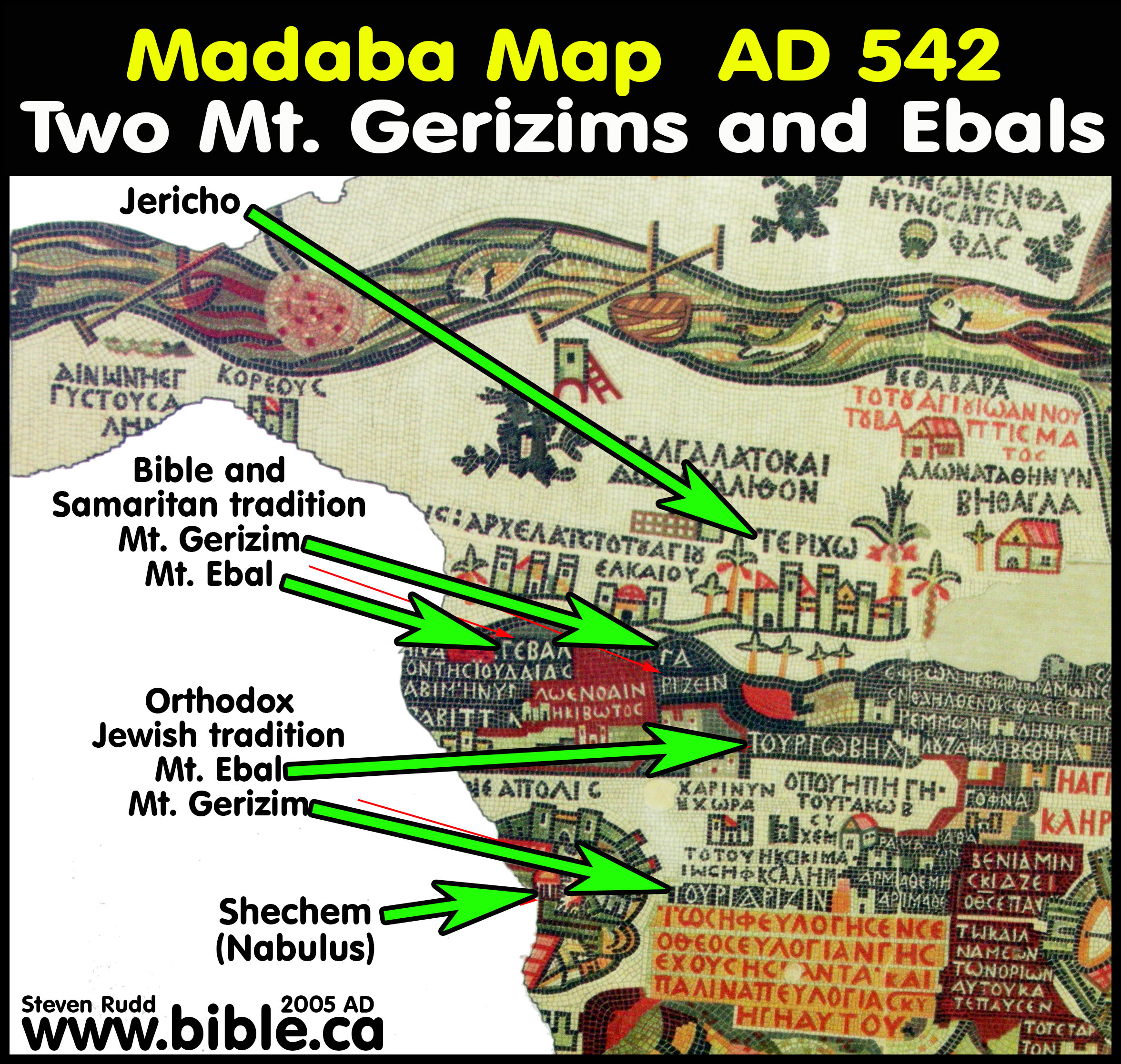
- Herbert Donner comments on this: "The mountains Gerizim and Ebal are represented twice on the Madaba Map: near Jericho and near Neapolis. What has happened here? The problem can be solved on the basis of Eus. On. 64:9-14 where, strangely enough, both mountains are indeed located near Jericho. Eusebius, however, does not fail to add: "The Samaritans show other ones near Neapolis, but they are wrong, for the mountains shown by them are too far from each other, so that it is impossible to hear one´s voice when calling to each other." Although this seems to be entirely intelligible and is confirmed by Deut. 27, the Samaritans were by no means wrong. Eusebius was wrong, and everybody knew it, perhaps he himself included. The Samaritans laid claim to the mountains, considering them to be their own holy mountains. Hostility to the Samaritans forced the orthodox Jews in Jerusalem to locate both mountains at another spot, for the Samaritans were not allowed to be right. Eusebius followed the orthodox Jewish tradition. The mosaicist, however, being well informed, preferred a Solomonic solution: he listed the mountains twice, indicating by larger letters that he regarded the location near Nabulus as being correct." (Herbert Donner, The Mosaic Map of Madaba, Kampen 1992, 24.48)
- In the 1980's, Adam Zertal has chosen an entirely new location for Mt. Gerizim after discovering Joshua's Altar. Here is a view looking due east from the left hand side of the 1250 BC altar structure we see today. Remember Joshua's altar of 1400 BC is a 6.5 circle of round rocks and is located on bedrock directly below the 1250 BC altar. One of the problems for Zertal, is that the altar doesn't directly point to his choice for Mt. Gerizim. Rather the altar is facing the open plains to the left of Zertal's Mt. Gerizim. Surely the altar would point directly to Mt. Gerizim since it was directly in view.
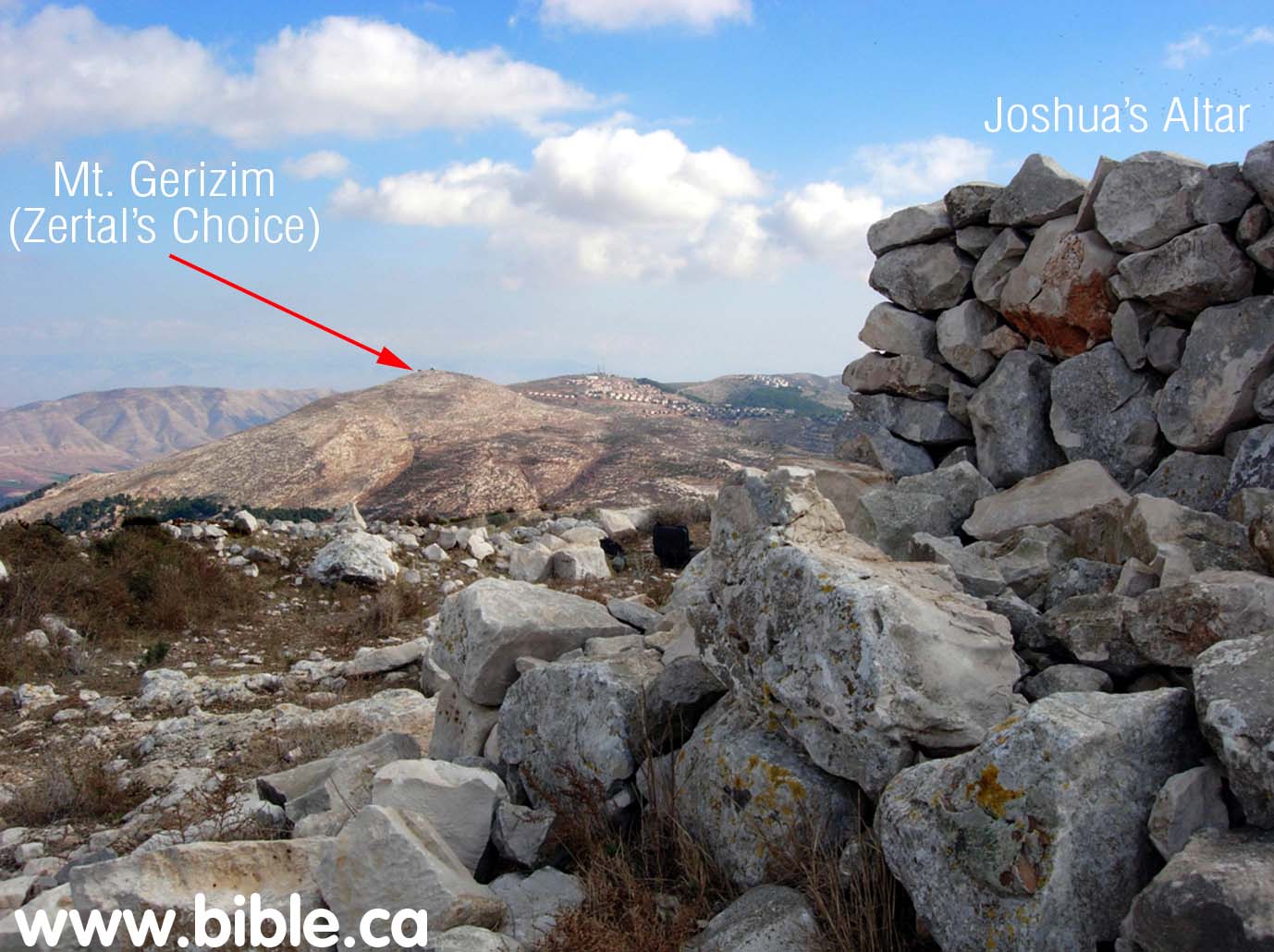 . .
- Here is a close up of Zertal's choice for Mt. Gerizim taken from the south side of the altar.
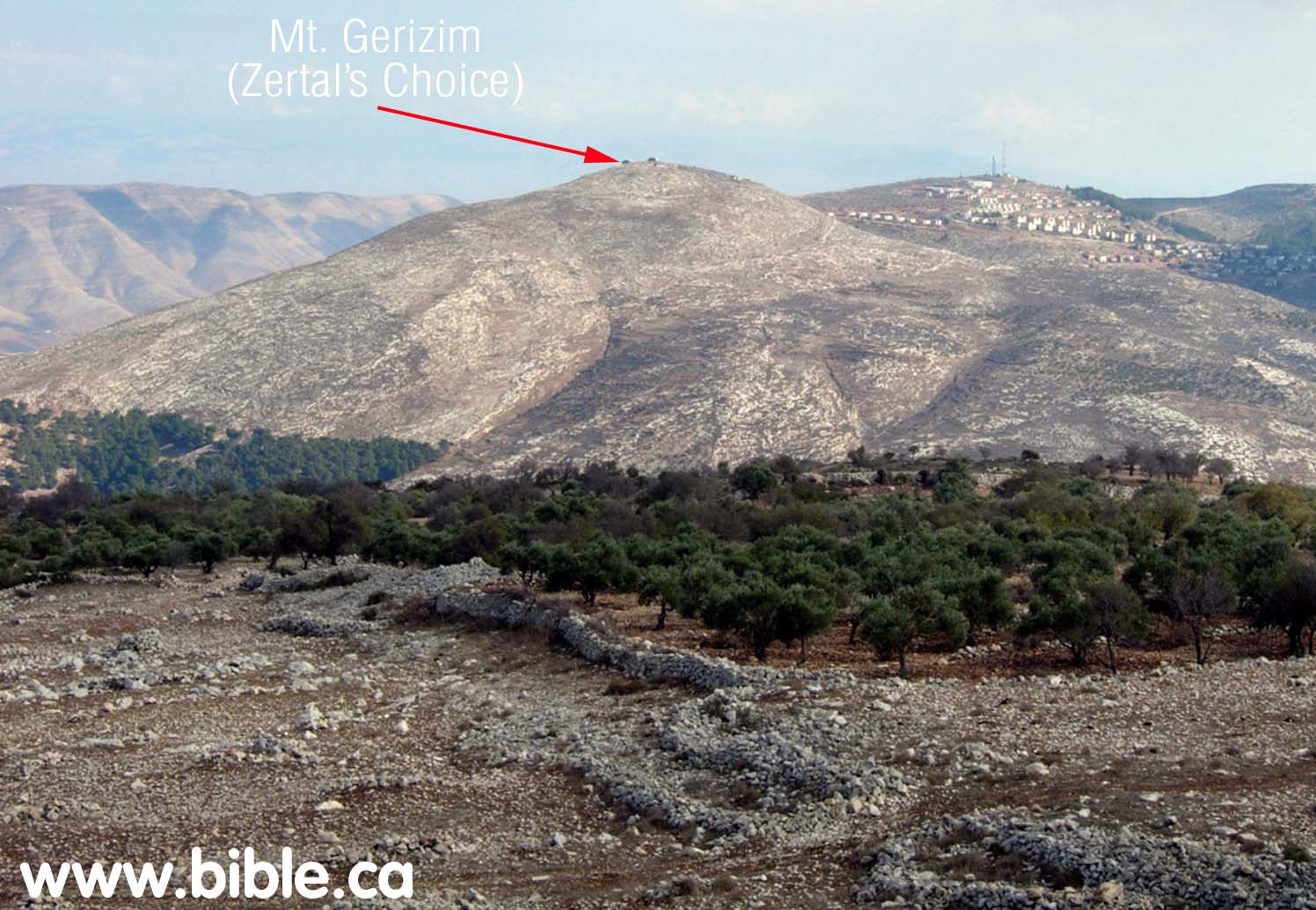
- When all has been examined it is clear that the correct location of Mt. Ebal is where Adam Zertal found Joshua's Altar. The correct location for Mt. Gerizim is where the Samaritans chose it. Zertal's choice for Mt. Gerizim is wrong. Eusebius is also wrong for locating the two mountains beside Jericho and Gilgal.
- The Bible and the Samaritan locations at Shechem (Nabulus) are correct. The orthodox Jewish locations near Gilgal are wrong.
Conclusion:
- The rectangular altar is to be dated to 1250 BC and was built in the time of Deborah of Judges 4.
- The round altar built directly below is Joshua's altar on Mt. Ebal which he built in 1400 BC. Another similar round altar has been discovered at Gilgal that was also built by Joshua at the same time.
- The true location of Mt. Gerizim is where the Samaritans say it is.
- "SUMMARY: A small cult site for offering sacrifices was established here in stratum 2. As evidence. the excavator cites the finds uncovered beneath the main stratum I B structure and the burnt areas, which contained animal bones. A four-room house adjoining the cult center was apparently the residence of its attendants. Because of the small size of the site in this stratum, it is assumed that it served as a family or tribal cult site. The excavator similarly interprets the stratum 1B remains as a main cult site of the Israelite settlers. Confirmation of this view is provided by the absence of dwellings. the presence of stone installations containing offerings, the singular architectural plan, and the ashes mixed with animal bones. The large double enclosure and the finely built main structure are in this stratum: The latter was apparently intended to serve as the focal point of ceremonies for a large assembly. The enclosure and the main building were abandoned after several decades of use and covered with a layer of stones (stratum IA). This was probably done deliberately, to bury the site. This interpretation of the site has aroused a great deal of controversy among scholars. Whereas the excavator viewed the main building as a large sacrificial altar, N. Na'aman identified the area as Shechem's main cult site in the Iron Age I—namely, as the "Tower of Shechem," and interpreted the central enclosure as the "house of El-berith" (Jg. 9:46). Some scholars (A. Mazar, M. D. Coogan, I. Finkelstein) agree that the site has a cultic nature but do not interpret it as an altar; others (A. Kempinski, A. F. Rainey) reject cultic interpretation of the Mount Ebal remains and tend to view the structure as a fortified tower." (Adam Zertal, New Encyclopedia of Archaeological Excavation i the Holy Land, Mt. Ebal, 1993 AD)
- Providentially Adam Zertal is excavating at: Gates of the Aruna Pass the summer of 2008. This may provide more insights into Tuthmosis III, as the Pharaoh of the Exodus:
"The Gates of the Aruna Pass: The site of Tell Assawir ("Mound of the Bracelets") is situated in perhaps one of the most strategically important areas in all of Israel. Located in the northern Sharon Plain at the approach to the northern foothills, Assawir controlled access to the narrow and rugged Aruna pass, the most direct route between the age-old coastal road and the inland Jezreel corridor. Assawir has thus seen its fair share of history, most notably in 1482 B.C. when Tuthmosis III of Egypt used the Aruna pass to gain a decisive victory over a large coalition of Canaanite chiefs that had fortified themselves at Megiddo. The victory would ultimately help the Egyptian New Kingdom pharaohs establish hegemony over southern Canaan for the next three hundred years. Although scholars still debate the site's ancient name and the specific role it played in the military strike of Tuthmosis III, there is little question that it was a major fortified site of the Middle Bronze and Late Bronze Ages. Recent excavations have shown that the large mounded site of Assawir (measuring some 15 acres) was established in the early second millennium B.C. and was protected by a steep-sided earthen rampart and glacis, a typical feature of Bronze Age Canaanite towns. The site continued to be occupied in the Iron Age I after the Egyptian empire had collapsed and, by the Iron II, Assawir was a major town of the northern kingdom of Israel. This summer (2008), you can help archaeologists from the University of Haifa dig deeper into this fascinating but still poorly understood site. The goals for this season will be to locate and excavate the Middle Bronze Age palace, further explore the city's Bronze Age fortification system and penetrate the mound's Iron Age I strata." (Adam Zertal, Director of dig)
Mt. Ebal updated, by Adam Zertal 2004:
|
The cult site on mount 'ebal
Adam Zertal Nov 2004
A stone mound on the northeastern ridge
Archaeological surveys are no easy task. They involve combing an area on foot, day after day, month after month, in order to map and register all sites in the area. All the historical sites known to us were discovered because of ancient traditions handed down from generation to generation, or by accident, or as a result of systematic archaeological survey. Over the millenia, sites have been forsaken and cities abandoned and destroyed, and their names have often fallen into oblivion. Many a time an archaeologist faces the difficult riddle of discovering the name of a lost city or identifying the people who inhabited it.
We began a systematic survey of Mt. 'Ebal (a large mountainous bloc north of Shechem, 940 meters above sea level, making it the highest mountain in the region of central and northern Samaria) in the winter of 1980. We knew, at that time, that the hill country of Samaria must conceal countless historical discoveries. In early 1978 a small team from Tel Aviv University, succeeded by a group from Haifa University, began an archaeological survey of the biblical allotment of the tribe of Manasseh in the hill country, an area extending from the Jezreel Valley on the north to Shechem and Nahal Qanah on the south, and from the River Jordan on the east to the Via Maris on the west. It soon became clear that Samaria was a blank spot on the map of the Land of Israel. Few studies in depth have been made of the area, and a search for substantial reference material is bound to be disappointing. There are two reasons for this neglect. Firstly, the three great monotheistic religions did not view Samaria as a holy region for pilgrimage. Judaism sanctified Judea and Jerusalem and, during the Second Temple period, also the Galilee. Christianity attributed sanctity to the Galilee, where Jesus was active, and to Jerusalem. For Islam, only Jerusalem was sacred. The sites of the land were generally first publicized by pilgrims' writings, but this area was not of particular interest to them. Secondly, for the past two hundred years Samaria has been the center of Arab nationalism and of the Arabs' struggle against both Ottoman and British rule, and few scholars have dared penetrate into its hills. It seems that Samaria is the only place left where survey techniques can still reveal large and important sites, hitherto unknown. That is how we discovered King Solomon's town of Arubboth, the zealot city of Narbata. This method of systematic survey is what brought us to the mound of stones on the ridge of Mt. 'Ebal.
The mountain is an inclined area descending steeply to the south towards the valley of Shechem. Eastward it slopes down in four broad "steps,- today mostly covered with olive groves and field crops. Most of the mountain is bald and rocky, and is built of hard, Eocene chalk. On a clear day, from its summit you can see westward all the way to the Mediterranean, southward to the mountains surrounding Jerusalem, eastward to a glorious view of Mt. Gilead, northward to the snow-capped Mt. Hermon.
1 Reconstruction of Temple in Jerusalem, as it is described in tractate Middot of the Mishnah. The . reconstruction includes all the parts discovered in the altar on Mt. Ebal: a central platform, a the altar of the Second surround, a major ramp, and a secondary ramp leading to the surround.
On the northern side of the second "step- from the summit, on an extended spur, we discovered a large pile of stones, almost 80 feet in diameter and It) feet high. The mound was situated in the center of an eliptical area enclosed by a narrow stone wall. Thousands of sherds were scattered inside this area, silent testimony to what had transpired on the site. Classification of the pottery immediately led us to one of the most fascinating periods in archaeological and biblical research in Israel: the period of the Israelite settlement in the Land of Canaan (13th-12th century b.c.e. ). Of no less interest was the fact that nowhere else on the mountain, whose area extends over 4,500 acres, were any other biblical sites, either Canaanite or Israelite, discovered. At the time the site was discovered, we did not dream of what we would find there in the end. We believed - this was the hypothesis underlying our scientific inquiry - that we were dealing with a small settlement site, perhaps a farmhouse or a fortified tower.
2 The burnt offering altar on Mt. 'Ebal (near Shechem —Nablus), viewed from the southwest. The elevated platform, preserved almost to its entire original height of approximately 10 feet, can be seen in the rear. Leading to this structure is a double ramp; the wider one, on the right, was for the High Priest to ascend the platform, bearing in his hands the animal sacrifice to be burned. The smaller ramp (the row of stones to the left) leads to a ledge that surrounds the platform of the altar on three sides. The priest used to stand on this ledge when he recited his prayers, performed the ritual of spattering the sacrificed animal's blood on the altar, and supervised the burning of the sacrifice. Paved courts were discovered on either side of the ramp, arid gift offering installations were uncovered in the courts.
3 Reconstruction of the altar. Because the structure was so well preserved, this reconstruction only required minimal intervention by the artist. A ledge for the priests surrounds the central structure on three sides. A major ramp leads to the central structure, and to its left a the secondary ramp ascends to the surround. The courtyards appear in the foreground and the temenos wall in the background, at the foot of the mountains. Sketched by Judith Dekel.
1 A scarab, or Egyptian-style signet ring, found in the altar's fill. The use of scarabs - seals and charms prevalent in ancient Egypt -spread over the entire ancient East. This seal, carved in the shape of a beetle an insect sacred to the ancient Egyptians -contains Egyptian religious symbols and scenes on its lower portion. Relatively crude in its workmanship, the scarab's ornamentation is geometric: a four-petal rosette with shoots between the petals, and a Uraeus (Egyptian cobra) emanating from each shoot. Discovering this scarab in the altar's fill enabled archaeologists to date the entire stratum, since the scarab can be ascribed with certainty to the great pharaoh Ramses II and to the latter part of his reign, 1245- 1220 b.c.e. Similar scarabs, dating to the same era, have been found in Egypt and Cyprus.
2 Map of the allotment of the tribe of Manasseh in the central hill country. The location of the cultic site matches the biblical tradition about Mt. 'Ebal.
A mysterious structure filled with ashes and burned bones
For decades the period of the Israelite settlement has been one of the most controversial periods in archaeological research, and justifiably so. On the one hand, the books of Joshua and Judges present us a rich, multi-faceted saga, full of vicissitudes, about the conquest and settlement of the land, about inter-relations between Canaanites and Israelites, about movements of families, clans, and tribes, and about man struggling with rocks, forests and groves, and the local inhabitants. On the other hand, archaeological research has run into great difficulty studying this era, for which we have no external sources. Hence also the great interest which the isolated structure within the precinct on Mt. `Ebal had for us. Over two years elapsed, however, before we succeeded in raising the funds necessary to begin work. We excavated the site for seven seasons, each of which lasted approximately one month. There being no road to the site, we broke one through with our bare hands, so that we could reach the site by jeep and bring in tools, food and water.
Unlike other sites, where the archaeologist knows what he is excavating - a house, a room, a wall or other structure - the structure on Mt. `Ebal was enigmatic from the outset. To this day no architectural parallels to it have been found within Israel. Two years of work, comprising three seasons of laborious excavation, elapsed before we got the brainstorm which solved the riddle of the nature of the site by piecing together our scientific data with literary sources on Israelite cultic worship.
When we excavated the isolated structure in the center of the walled area which encompassed approximately one acre, it became clear that we were dealing with a far more elaborate complex than we had imagined at the outset. A large elevated structure, measuring 29.5 by 23 feet, rose in the center. It was built as a frame structure with walls about 5 feet thick, made of large, rough, unhewn stones. Inside the frame two thick walls were built facing each other and leaving an open space between them. The empty space itself was filled by the builders with four deliberately laid strata of fill.The lowest stratum contained a considerable quantity of ashes, above it was a stratum of dirt and stones, then another thick layer, approximately three feet deep, containing a large quantity of black ashes. In these ashes were hundreds of animal bones, some of which had been burned in a hearth. Many potsherds, belonging to the same period of early Israelite settlement, were found there as well. All this formed a filled platform which came to a height of about 10 feet above bed-rock. A sort of terrace, about a yard lower than the structure, was built adjacent to it, surrounding the high platform on three sides. Only the southeastern edge of the platform remained exposed. It is interesting that the corners of the platform point due north, south, east and west. The practice of constructing sacred buildings so that their corners pointed in the directions of the compass was characteristic of Mesopotamia throughout its history. Temples, as well as altars, were always oriented in this way. The practice stems from the nature of the religion which developed in Babylonia and Assyria, based on four principal natural forces: earth, fire, air and water.
A ramp of unhewn stones, 4 feet wide by 23 feet long, rises to the top of the platform from the southwest. The gentle incline, easily climbed, and the presence of the ramp itself accord with the explicit scriptural injunction: "Neither shalt thou go up by steps unto Mine altar, that thy nakedness be not uncovered thereon".
Adjacent to the northern side of the ramp is another small, narrow wall, somewhat lower than the one beside it. It turns out that this smaller ramp, which greatly intrigued us since we could find no constructional logic for it, was intended as a means of ascent for the priests to reach another part of the altar, the surround or ledge. This is none other than the above-mentioned terrace adjacent to the altar, which was reached by climbing the smaller ramp adjacent to the larger one. All this became clear to us only after reading the extremely precise mishnaic descriptions of the Second Temple in Jerusalem: "The altar was thirty-two [cubits] by thirty-two [cubits]. It rose up one cubit and receded one cubit; this was the base. [Thus] we find left [a square space of] thirty by thirty. [The next part built up on the base] rose up five [cubits] and receded one cubit; this was the surround. Thus we are left with twenty-eight by twenty-eight... And there was a ramp at the south of the altar, thirty-two cubits by sixteen cubits in width..." (Middot 3:1-3).
About the smaller ramp the Mishnah writes: "How was this performed? The priest went up the ramp and passed around the ledge, and came to the southeast corner..." (Zevaltint 5:3).
3 The stone mound beneath which the burnt offering altar complex was discovered. As excavation began, thousands of potsherds, dating to the 13th century b.c.e., the beginning of the period of the Israelite settlement, were found among the stones. The excavators were surprised to find that the site had been deliberately buried under a layer of stones before it was abandoned, presumably to prevent its desecration. Perhaps abandoning Mt. `Ebal was related to establishing a sacred site at Shiloh and the focus of the Israelite population shifting from the territory of Manasseh in the north to that of Ephraim in the central part of the country.
4 Strange installations in the northern court of the altar complex. Five box-like installations built of stone were discovered in a row near the ramp that ascends the altar. Some contained large quantities of ash and burned bones from animal sacrifices, others complete pottery vessels unearthed in situ. This discovery, like that of the altar, reveals the hitherto undisclosed world of religious ritual of the early Israelites.
The mishnaic description of the altar depicts a sort of graduated tower in which each successive level is somewhat smaller than the one below it. In the Second Temple period there were three levels, whereas the altar on Mt. `Ebal has only two. These levels are formed by the surrounding ledge (see photographs and reconstruction). Interestingly enough, the future altar, described by Ezekiel, which most scholars believe reflects the altar in the First Temple, was also built in successive levels: "And these are the measures of the altar by cubits — the cubit is a cubit and a handbreadth: the bottom shall be a cubit, and the breadth a cubit, and the border thereof by the edge thereof roundabout a span; and this shall be the base of the altar. And from the bottom upon the ground to the lower settle shall be two cubits, and the breadth one cubit; and from the lesser settle to the greater settle shall be four cubits, and the breadth a cubit. And the hearth shall be four cubits; and from the hearth and upward there shall be four horns" (Ezekiel 43:13-15).
On the west, adjacent to the altar and the ramps, are two stone-paved courts. In these we found structures constructed and paved with crushed chalkstone. Some of them contained ashes and animal bones, others pottery vessels which had been deliberately placed in the spot, apparently for offerings. Similar structures containing pottery were found round about the altar.
bones provide the solution
Examining the bones in the laboratories of the Hebrew University's Department of Zoology took several months. These were tense months for us, the excavators. When Liora Kolska-Horwitz, who did the bone analysis, brought us the results, they were very surprising. Except for the bones of a wild rabbit and a hedgehog (that happened to die on this site at a later date), 942 bones were examined, representing 50-100 specimens. These were attributed to four kinds of animals: goats, sheep, cattle, and fallow deer. The latter is a light-spotted animal which inhabited the woodlands of our country in antiquity. Examination of the sex and age of the animals revealed that all those that could be diagnosed were young males, approximately one year old. This correlates remarkably with the laws of sacrifice in the book of Leviticus: [The fallow deer does not fit the definition of sacrificial animals but is included in the list of animals fit for eating (Deuteronomy 14:5).] It appears that in this ancient period fallow deer were sacrificed, as well. And the Lord called unto Moses, and spoke unto him out of the tent of meeting, saying: Speak unto the children of Israel, and say unto them: When any man of you bringeth an offering unto the Lord, ye shall bring your offering of the cattle, even of the herd or of the flock. If his offering be a burnt-offering of the herd, he shall offer it a male without blemish" (Leviticus 1:1-3). A great part of the bones, as we mentioned, had been burned over a fire and were cut near the joints. Being scorched in this way attests that the flesh was not intended for eating but was burned over an open fire (i.e. not in an oven). Thus the high correlation with the biblical laws of sacrifice, together with the great architectural resemblance to Israelite altars, confirmed the view that we were dealing with a cultic site and altar from the beginning of the Israelite settlement.
1 An aerial view of the inner temenos and altar complex, from the south. Extremely few sacred sites of the ancient Israelites have been uncovered in archaeology of the Land of Israel; for, in an effort to centralize religious ritual in Jerusalem, Kings Hezekiah and Josiah tore down the "high places" and altars scattered elsewhere across the land. Thus, an example such as this one, of a sacred precinct surrounding a burnt offering altar, is quite rare. The altar itself is comprised of a raised platform (excavated, in the center of the photo), two courts (on the left), and a ramp ascending between them to the top of the platform. As is characteristic in excavation of sacred precincts, no structures other than the altar complex were found within the temenos. Situated on one of the highest points in the land of Israel, the altar on Mt. 'Ebal accords closely with the ancient scriptural tradition of building sacred centers atop mountains: "They shall call peoples unto the mountain; there shall they offer sacrifices of righteousness" (Deuteronomy 33:19).
2 The sacred precinct on Mt. 'Ebal (viewed from the west). The situation of the inner temenos wall within the enclosure of the outer temenos wall is evident. The gateway to the inner precinct was by way of a broad entrance with three steps. On the inner side was a large courtyard with no other structures in it, save the altar complex. Twice the Bible uses the phrase "at Mt. Ebal," as distinguished from "on Mt. 'Ebal," by which it refers to the side of the mountain, not its summit. Indeed, the site lies on the northeastern side of the hill. Drawn by Judith Dekel.
more surprises: a temenos, courtyards, and entrance
As the nature of the structure became increasingly clear, we began trying to solve the riddle of the enclosure. The thin enclosure wall was clearly not intended to provide a defense against enemies, but rather to delimit a sacred area, entry into which was permitted only to priests and levites, and perhaps other eminent persons.
Aside from the altar, no other structures were found inside the temenos (enclosure wall of a sanctified area). The entire area was laid out in the form of several courts. When we uncovered parts of them, it became clear that a considerable quantity of bones and potsherds lay scattered over the courts. However, unlike the bones found in the altar, they had not been burned and their flesh had been used for food. We called these courts the Maimuna area, for here the big feasts were held, as we read explicitly in Scriptures: "And thou shalt sacrifice peace-offerings, and shalt eat there; and thou shalt rejoice before the Lord thy God" (Deuteronomy 27:7). [The Maimuna is a celebration held by North African Jews on the last day of Passover and is noted for its great feasting.]
The entrance to the enclosure was built in a broad depression in the natural rock, north of the site. Here three wide steps, paved with flat stones, were constructed between two parallel walls. This elaborate entrance is unparalleled in other sites of the settlement period. Both the width (approximately 26 feet) and the paving, at the entrance to such a small site, are indicative of what we call a processional gateway. Such gateways were generally built for cultic processions, carrying holy objects, to pass through.
an ancient cultic site beneath the altar
As we dug deeper into the strata of fill, it became clear that the cultic center, even the large altar itself, had been preceded by another cultic site. On the natural bed-rock, beneath the geometric center of the altar, we discovered a round structure, about 6.5 feet in diameter, built of unhewn stone. It was found full of yellowish material, above which was a thin layer of ashes and burned animal bones. At first we thought this was part of the altar. Shortly, however, levels of habitation preceding the large altar emerged in other parts of the site as well. Around the early, circular structure were signs of further cultic activity: an earthen floor paved with pottery, a large collar-rimmed jar, and other vessels. The pottery findings in both phases were very similar, so much so that we believe the same people, or the same generation, built both phases of the site. There is no difference in the pottery; but, in contrast, there is a fundamental difference in the perception of the site, which may be put briefly as follows: in the second half of the 13th century, as far as we can tell, a modest cultic site was established on Mt. 'Ebal. A rough wall, constructed of large boulders, was built to enclose a sacred area. In the center was a round structure, possibly used for sacrifice, and around it other activities took place.
1 A jar, in situ, as it was placed 3,200 years ago in the gift offering installation. It was a common practice among all cultures of the ancient world for pilgrims to bring priests offerings for the deity when arriving at a sacred place. Several scriptural quotations describe this custom and the types of offering that were brought: "... and there shall meet thee there three men going up to God to Beth-el, one carrying three kids, and another carrying three loaves of bread, and another carrying a bottle of wine" (1 Samuel 10:3). In the altar complex on Mt. 'Ebal archaeologists found dozens of stone installations containing vessels, like the one pictured here, in which offerings were brought.
2 A three-handled jar from the offering structure in the Mt. Ebal altar, after restoration and treatment.
We do not know the origins of the great sanctity attributed to the mountain, but it appears that this sanctity only dates from the time of the Israelite settlement. For there is not the slightest sign of any Canaanite cultic tradition, nor any Canaanite finding which dates to the Late Bronze Age, anywhere on Mt. 'Ebal. It stands to reason that founding a cultic center on Mt. 'Ebal was intended as nothing other than a counter-weight to the presence of Canaanite Shechem and its cultic sites.
After several decades of the site's existence, a revolutionary change occurred there. From a small place, sacred to one family or perhaps to the region, it suddenly became a central cultic site of supra-tribal or perhaps even national importance to the entire alliance of the tribes. A new temenos was built, as well as a broad, paved gateway. A large and complex burnt offering altar, comprised of the platform itself, a surround, a small and a large ramp, and paved courts, was built on top of the earlier round structure. When this larger complex was constructed, so it seems to us today, the remains of bones and ashes from the earlier rites were gathered together and used to fill the new altar. Burying the earlier structure in the center of the newer one apparently symbolized the continuity of the tradition of sanctity attached to the site. [In the Bible a "burnt offering altar" is a structure to which animal sacrifices were brought and burned. The other biblical altar is a small incense altar, generally made of a single stone, on which incense was burned in the chambers of the Temple.]
Many pottery vessels were discovered on the site, all belonging to the Early Iron Age (the time of the Israelite settlement, 1250 -1000 b.c.e.).Prominent types include the pithos (large collar-rimmed storage jar), jars, cooking pots, kraters, jugs, and bowls. Yet what was most interesting was the discovery of two scarabs (Egyptian-style signet rings in the shape of a beetle, common in the Ancient Near East throughout the second millenium b.c.e.). One was found in the altar's fill, the second inside an offering structure. One displays a geometric design consisting of a four-petal rosette in the center, with four shoots between the petals and a uraeus (an Egyptian cobra, believed in Egypt to have magical powers of protection and holiness) coming out of each shoot. The other displays a kneeling Egyptian archer and the cartouche of Tuthmosis III, the great Egyptian conqueror. On the basis of similar findings in Egypt, Canaan and Cyprus, B. Brandl of the Hebrew University ascribes these scarabs to the second half of the 13th century b.c.e.In other words, they date to the time of the great Egyptian pharaoh, Ramses II, who is considered the pharaoh of the exodus from Egypt. Finding these scarabs here does not mean they were brought directly from Egypt; that would be going too far. More important, however, is that they fix a date for the construction of the altar - approximately 1250 b.c.e.
Shechem and mount `ebal in the bible: is this indeed joshua's altar?
In early Israelite sources Shechem is considered a central holy place for the tribes coming to settle the land. Moreover, Shechem's sanctity also finds expression in the stories of the patriarchs. When Abraham migrated from Mesopotamia to the land of Canaan, he came to Shechem first: "And Abram passed through the land unto the place of Shechem, unto the terebinth of Moreh. And the Canaanite was then in the land. And the Lord appeared unto Abram, and said: 'Unto thy seed will I give this land'; and he builded there an altar unto the Lord, who appeared unto him" (Genesis 12:6-7). This tradition was continued by Jacob: "And Jacob came in peace to the city of Shechem, which is in the land of Canaan, when he came from Paddan-aram; and encamped before the city. And he bought the parcel of ground, where he had spread his tent, at the hand of the children of Hamor, Shechem's father, for a hundred pieces of money. And he erected there an altar, and called it God, the God of Israel" (Genesis 33:18-20).
There appears to be a direct connection between this and the important tradition in Deuteronomy 27 and Joshua 8 concerning an altar erected on Mt. 'Ebal and an important covenant made on the site: "And Moses and the elders of Israel commanded the people, saying: 'Keep all the commandment which I command you this day. And it shall be on the day when ye shall pass over the Jordan unto the land which the Lord thy God giveth thee, that thou shalt set thee up great stones, and plaster them with plaster... And it shall be when ye are passed over the Jordan, that ye shall set up these stones, which I command you this day, in mount Ebal, and thou shalt plaster them with plaster. And there shalt thou build an altar unto the Lord thy God, an altar of stones; thou shalt lift up no iron tool upon them. Thou shalt build the altar of the Lord thy God of unhewn stones; and thou shalt offer burnt-offerings thereon unto the Lord thy God... And thou shalt write upon the stones all the words of this law very plainly.' And Moses and the priests the Levites spoke unto all Israel, saying: 'Keep silence, and hear, 0 Israel; this day thou art become a people unto the Lord thy God...' " (Deuteronomy 27: 1-9).
The Book of Joshua describes the performance of this commandment: "Then Joshua built an altar unto the Lord, the God of Israel, in mount Ebal, as Moses the servant of the Lord commanded the children of Israel, as it is written in the book of the law of Moses, an altar of unhewn stones, upon which no man had lifted up any iron; and they offered thereon burnt-offerings unto the Lord, and sacrificed peace-offerings. And he wrote there upon the stones a copy of the law of Moses, which he wrote before the children of Israel" (Joshua 8:30-32).
No scholar challenges the fact that this is an extremely important and authentic tradition dealing with a central event in the life of the people. All agree that this event took place on Mt. 'Ebal. As to the date of the event and the date it was recorded, however, views vary. Another tradition, in Joshua 24, accords special importance to Shechem. There Joshua made a covenant with the people, "and set them a statute and an ordinance in Shechem" (Joshua 24:25). According to the biblical redactor, Shechem and its environs were a major center for the emergent union of Israelite tribes. The central altar was erected on Mt. 'Ebal, and there Israel became "a people unto the Lord thy God" (Deuteronomy 27:9); whereas the "statute and ordinance" (whatever this obscure expression means) were given to the people in Shechem.
Thus far, archaeological research has not been bountiful on the period of the Israelite settlement. In most of the major places mentioned in the stories of the conquest, such as Jericho, 'Ai, 'Arad, and others, no strata of destruction from the Late Bronze Age which would accord with the biblical account have been found. Reputable scholars have suggested that the entire story of the conquest is nothing more than a later, etiological tradition which sets out to account for various manifestations in the light of mythological traditions and folklore. Recent extensive archaeological surveys of the central hill country, however, reveal clearly the process of Israelite settlement as a major settlement movement of the era (1250-1100 b.c.e.). Hundreds of newly-founded, small settlements were established within a short period throughout the hilly allotments of the tribes of Manasseh, Ephraim and Benjamin. The settlers used a characteristic type of pottery and their houses were generally built on a three- or four-room plan. [An architectural design for a residential structure, having three compartments running lengthwise and one crosswise. The living quarters were in the lateral room (sometimes of two storeys), while the livestock, kitchen, and storerooms were in the longitudinal compartments. The entrance to the structure was on the central longitudinal room. Its convenience and efficiency made this the prevalent and almost exclusive plan in the villages and habitations of the newly arrived Israelites, and in their later sites as well.] Although Israelite pottery and architecture were influenced by the Canaanites, they have certain prominent and unique characteristics. In our survey of the hill country of Manasseh we were able to study the ecology of the Israelite settlement and, using new research methods, we succeeded in reconstructing the process by which they penetrated the central hill country from the eastern Transjordan. Evidently the beginning of the penetration, sometime in the 13th century b.c.e., was made by semi-nomadic shepherd groups migrating from the edge of the desert, by way of the "ecological pipe" of Wadi el Far'a (Natial Tirzah). Many sites with ancient pottery typical of the settlement period were discovered along the fertile and well-watered valley of this river, which is surrounded by broad pasture. In the next phase the Israelites established themselves along the edges of the internal valleys of the hill country of Manasseh: Tubas (biblical Thebez), Zebabdeh, Sanur, Dothan, and others. An economy based on olive and grape cultivation, which henceforth would characterize Israelite habitation of the hill country, did not emerge until the settlement process drew to a close at the end of the 12th century. As this complex and fascinating process was developing, the people's religious and ritual practice took shape. The cultic site on Mt. Ebal satisfies the three criteria necessary to identify a biblical site: chronological (beginning of the Israelite settlement), geographical, and the nature of the site (a cultic center with a burnt-offering altar). In view of this analysis, the identity of the biblical story and this site as the first inter-tribal center of the Israelite tribes can hardly be doubted.
This is the first time a complete Israelite cultic center, including an altar for burnt offerings, is available for study. Thanks to King Josiah's and King Hezekiah's activities in breaking up the "high places," only two small altars for burnt offerings have been discovered in Israel, one in 'Arad and the other (discovered no longer intact) in Beersheba, and both date relatively late. The altar on Mt. 'Ebal is not only the most ancient and complete altar, but also the prototype of the Israelite burnt offering altar of the First and Second Temple periods. The Mesopotamian architectural influence on the structure of the altar is also very interesting, both in its stepped construction and in the orientation of its corners to the north, south, east, and west.
1 The second Mt. 'Ebal scarab, found in an offering structure north of the altar. This finely-tooled scarab displays a kneeling Egyptian archer (left) holding a double bow. To his right is the cartouche (royal seal) of the great 15th century, b.c.e conquerer, Tuthmosis III. Above the archer's head is a salamander and at his feet a boat. The drawing means "Pharaoh commands ten thousand archers." This rare memorial scarab, issued by Ramses II in honor of the great conquerer who lived two centuries earlier, has only four known parallels and can be dated with great precision to 1245-1220 b.c.e., thus strongly supporting the dating of the altar's construction to the latter half of the 13th century, b.c.e.
2 A view of the altar during excavation. Its central part is a stone structure, 24.5 feet by 29.5 feet. An open space was discovered inside, with specially constructed walls leading into it. The interior space was found filled with alternate layers of stone and ash. The man in the photo is kneeling on a layer of ash. To the archaeologists' great surprise, hundreds of animal bones, most of them burnt, were found in the layers of ash. Burnt bones are evidence of burnt offerings. The bones were attributed to four types of animal -cattle, sheep, goats, and fallow deer and all were from young males, just as the Toraic laws on sacrifice prescribe. Fallow deer is the only animal not mentioned as one that may be sacrificed; thus discovery of its bones in the Mt. 'Ebal altar is rather perplexing. The varieties of animal bones discovered are evidence that the laws of sacrifice were followed from the very beginnings of the Israelite religion. Despite the presence of wild boars in the region, not a single bone of this animal, not fit for sacrifice, was found on Mt. 'Ebal.
by Adam Zertal
Research papers written by Adam Zertal 1980's:
|
Has Joshua's Altar Been Found on Mt. Ebal?
by Adam Zertal
To appreciate fully the significance of the unique altar and cult center we are excavating on Mt. Ebal, one must first understand the archaeological context in which these discoveries were made.
We found the altar and cult center, not in the course of excavating a tell, but in the course of conducting an archaeological survey. The recent history of archaeology in Israel and in adjacent lands has seen a slow movement away from the excavation of large, well-known tells in favor of surveys of larger geographic areas. A survey not only provides a comprehensive background of an area, but it also gives the archaeologist a broader understanding of individual sites discovered during the survey.
It would be difficult to find a better example to illustrate this than Mt. Ebal and the altar and cult center we found on it. To understand what we found, we must understand not only the site itself, but the mountain on which it was discovered and, indeed, how this mountain relates to the surrounding area in a particular time period.
An archaeological survey is conducted by surveyors who systematically walk over a defined area, so that trained eyes examine the surface of every square meter of land, slope after slope, ridge after ridge, field after field, searching for evidence of human occupation. All such evidence is carefully examined, recorded, mapped, and in the case of our survey, programmed into a computer. Sometimes limited excavation is undertaken at key sites. A survey is thus a slow, tedious process; paradoxically, it is at the same time exciting.
Our survey, which began in 1978. intends to cover the area allotted to the Israelite tribe of Manasseh. We expect to complete the survey by 1990.
Incidentally, the altar and cult center on Mt. Ebal have not been our only important discoveries. Another was Khirbet el Hammam, which has now been conclusively identified as ancient Narbata, where the First Jewish Revolt against Rome started in 66 A.D. And the city in the stratum just beneath Narbata has been identified as Arubboth, the third district capital of King Solomon (I Kings 4:10). But this site will be the subject of another article. Let us return to Mt. Ebal.
Our survey of Mt. Ebal itself began in February 1980, nearly two years after we began our survey of Manasseh. Ebal is a huge mountain-about six and a half square miles (18 square kilometers)-in the southern part of Manasseh. It is also the highest mountain in northern Samaria, rising over 3,000 feet (940 meters) above sea level. From its peak, on a clear day, we could see the snows of Mt. Hermon in the north, the mountains of Gilead across the Jordan to the east, the Mediterranean Sea to the west, and the hills surrounding Jerusalem to the south. Our survey of this mountain alone took nearly two months to complete.
Mt. Ebal, known from Deuteronomy, chapters 27 and 28, as the mountain where the curses were pronounced, is separated on the south from Mt. Gerizim, the mountain of the blessings, by the deep narrow valley of Shechem.
On a cool spring afternoon in April-April 6, 1980, to be exact-when we had nearly completed our survey of the mountain, we came upon a large heap of stones that was not very different from the thousands of stone heaps we had already found, collected by farmers as they cleared their fields for planting. True, the stone heap was somewhat larger than the typical one, but what really distinguished it was the great quantity of pottery sherds lying around it.
We were immediately able to date these sherds to the early part of the period archaeologists call Iron Age 1 (1220-1000 B.C.), the period during which the Israelites entered Canaan and settled there. Iron Age 1 also includes the period of the Judges.
Our survey of the territory of Manasseh proved very rich in the number of sites from Iron Age I. To date, we have discovered approximately 160 sites from this period. This was hardly surprising. The Bible tells us that Israel was really born here-in the central hill country and especially near the ancient city of Shechem (Genesis 11:31, 12:6; Joshua 24).
But Mt. Ebal itself was different. Except for the heap of stones mentioned above, there was not a single site from Iron Age I on Mt. Ebal. Here, amidst evidence of dense Iron I occupation in the hill country of Manasseh, in an area identified in the Bible with the new Israelite settlements, was a prominent mountain devoid of any Iron Age sites, except one-our heap of stones. We discovered more than ten other sites on Mt. Ebal, but none of these was occupied in the Iron Age.
It took us two years to raise funds to excavate the heap of stones, and to organize our expedition. But I must confess we did not rush, for we never dreamed that the site would prove to be the earliest and most complete Israelite cultic center ever discovered and the prototype of all later ones. It took us another two years and three seasons of digging to find out what we were really excavating.
The heap of stones was called El Burnat by the local felluhin. It means "the hat" in Arabic. It is located on the northeastern side of Mt. Eval on a low, stony ridge, on the so-called second step of ihe mountain. The site is enclosed on three sides by beautiful little valleys, producing an amphitheater-like setting. Here, we began to dig with eight volunteers in September 1982.
We have completed four seasons of excavation; one in October 1982. rwo in 1983, and the last in the summer of 1984, and we now have a reasonably complete picture of the site.
The central feature of the site, found under the heap of stones, is a rectangular, nearly square structure. Today it stands to a height of almost nine feet. Since it is so beautifully preserved, we conclude that this is probably close to its original height. It is constructed of large, unhewn field stones. The outside measurements are 24.5 feet by 29.5 feet. Its walls are 5 feet (1.4 meters) thick.
Our first season, in October 1982, concentrated on this central structure. Our initial thought was that this was a farmhouse or perhaps a watchtower. But it was different in almost every respect from the farmhouse's watchtowers we know from examples all over the country. When we reached the bottom of the structure, we immediately noticed that there was neither a floor nor an entrance. The walls were laid directly upon bedrock. Obviously, we were not dealing with a building that had been regularly lived in.
To explain the structure as a watchtower is even less satisfactory, because there is no reason for a watchtower to be here. Mt. Ebal has always been an obstacle to transportation. All transportation routes have avoided it. There is, thus, no road for a watchtower to observe. And there were no Iron Age settlements nearby.
The strangest feature of the structure was the filling, which, together with the structure, formed a kind of stage. When we excavated the fill within the structure, we found that it consisted of deliberately laid strata or layers of field stones, earth aid ashes, one layer on top of the other. The earth and ashes contained pieces of pottery, all from Iron Age I, and animal bones. The ash was of different kinds of burnt wood, principally evergreen oak (Quercus Calliprinos).
Getting a little ahead of my story, I will tell you that the bones, which were found in such large quantities in the filling, were sent for analysis to the zoology department of the Hebrew University in Jerusalem. The bones proved to be from young male bulls, sheep, goats and fallow deer. Most of the bones had been burnt in open-flame fires of low temperature (200-600 degrees C). Some of the bones were cut near the joints. The first chapter of Leviticus describes the animals that may be offered as sacrifices. A burnt offering must be a male without blemish (Leviticus 1:3). It may be a bull (Leviticus 1:5} or a sheep or a goat (Leviticus 1:10). The close match of the bones we found in the fill with this description in Leviticus 1 was a strong hint as to the nature of the structure we were excavating. Although fallow deer were not included in the Biblical description, they are a kosher animal that may be slaughtered and eaten, so it is possible that during the early stages of the Israelite religion, a fallow deer could also have served as an acceptable sacrifice.
But all this analysis of the bones actually occurred much later At the end of our first season, when the winter rains began, and it turned cold on Mt. Ebal, we still had no idea what this mysterious structure was.
Here are the results of the lab tests on the bones we found: Examining the bones in the laboratories of the Hebrew University's Department of Zoology took several months. These were tense months for us, the excavators. When Liora Kolska-Horwitz, who did the bone analysis, brought us the results, they were very surprising. Except for the bones of a wild rabbit and a hedgehog (that happened to die on this site at a later date), 942 bones were examined, representing 50-100 specimens. These were attributed to four kinds of animals: goats, sheep, cattle, and fallow deer. The latter is a light-spotted animal which inhabited the woodlands of our country in antiquity. Examination of the sex and age of the animals revealed that all those that could be diagnosed were young males, approximately one year old. This correlates remarkably with the laws of sacrifice in the book of Leviticus: And the Lord called unto Moses, and spoke unto him out of the tent of meeting, saying: Speak unto the children of Israel, and say unto them: When any man of you bringeth an offering unto the Lord, ye shall bring your offering of the cattle, even of the herd or of the flock. If his offering be a burnt-offering of the herd, he shall offer it a male without blemish" (Leviticus 1:1-3). A great part of the bones, as we mentioned, had been burned over a fire and were cut near the joints. Being scorched in this way attests that the flesh was not intended for eating but was burned over an open fire (i.e. not in an oven). Thus the high correlation with the biblical laws of sacrifice, together with the great architectural resemblance to Israelite altars, confirmed the view that we were dealing with a cultic site and altar from the beginning of the Israelite settlement.
When we excavated under the fill, we found some curious stone-built installations. One installation consisted of a circle made of medium-sized field stones laid on bedrock arid located at the exact geometric center of the structure. The outside diameter of the circle of stones was 6.5 feet. The circle of stones was filled with a thin, yellowish material that we have not yet identified. On top of this yellowish layer was a thin layer of ash and animal bones.
This installation as well as the others inside the structure were clearly used in some fire-related activity before the structure was built. It is quite obvious, now, that the installations at the bottom of the structure represent an earlier phase, and the large structure itself represents a later phase-both from the same Iron I period.
Two cross-walls divide the structure. If these cross-walls extended further, they would meet and divide the structure in two. They are too short to meet, however. One of these short walls was built over the circle installation at the center of the structure.
Another curious discovery: two comers of the structure point precisely (within an error of less than one degree) to the north and the south; since the structure is rectangular, the other two comers point nearly but not exactly east and west.
Attached to the structure on the Southwestern side were two adjacent, stone-paved courtyards. In each courtyard were stone-built installations, three in one and four in the other. Some of these installations were paved with crushed chalk. They contained either ashes and animal bones, or complete pottery vessels (jars, jugs, juglets and pyxides)-one or the other, but not both.
What at first glance appears to be a wall separating the two courtyards outside the rectangular structure actually rises from the far side up to the main structure at an incline of 22 degrees. This is in fact a ramp leading up to the stage on top of the main structure. This ramp is a bit over 3 feet wide and 23 feet long- It is made of medium-sized field stones. The highest point of the ramp indicates that the main structure was one layer of stones higher than its present elevation, rising to a height of approximately 10 feet. So both the ramp and the excellent state of preservation of the structure indicate it has been preserved to nearly its full original height.
More surprises: a temenos, courtyards, and entrance
This structure, together with its ramp and courtyards and adjacent area, is surrounded by a thin elliptical wall enclosing about 37,650 square feet (3,500 square meters). We refer to this wall as the temenos wall. (Temenos is a Greek word meaning "an enclosed sacred place.") The temenos wall stands to a height of about one and a half feet and is made of small field stones. This wall is built on the edge of the slope. About seven feet west and down the slope from this wall is a retaining or revetment wall, which we now assume to be an earlier temenos wall, made of very large boulders. The space between the two walls is filled with field stones that support the later temenos wall.
During the last excavation season, we located the gateway through the temenos wall. It consists of two parallel walls perpendicular to the temenos wall, 23 feet apart. Three wide steps lead up the slope and through the gateway. The entrance is beautifully paved with large, flat stones, creating a very wide and precisely detailed processional entrance. No parallel to this entranceway has been found in Iron Age Israel. This beautiful entrance emphasizes the significance of Mt. Ebal as a sacred cultic center.
Within the temenos or sacred precinct but outside the main structure, we found different stone installations, in addition to those already described. They are mostly built of small flat stones and are arranged in three groups. In some we found pottery vessels but no ashes or trace of fire. Originally, the vessels probably contained some kind of offering. In other installations, we found ash and animal bones but no pottery.
As the nature of the structure became increasingly clear, we began trying to solve the riddle of the enclosure. The thin enclosure wall was clearly not intended to provide a defense) against enemies, but rather to delimit a sacred area, entry into which was permitted only to priests and levites, and perhaps other eminent persons. Aside from the altar, no other structures were found inside the temenos (enclosure wall of a sanctified area). The entire area was laid out in the form of several courts. When we uncovered l, parts of them, it became clear that a considerable quantity of bones and potsherds lay scattered over the courts. However, unlike the bones found in the altar, they had not been burned and their flesh had been used for food. We called these courts the Maimuna area, for here the big feasts were held, as we read explicitly in Scriptures: "And thou shalt sacrifice peace- offerings, and shalt eat there; and thou shalt rejoice before the Lord thy God" (Deuteronomy 27:7).
The entrance to the enclosure was built in a broad depression in the natural rock, north of the site. Here three wide steps, paved with flat stones, were constructed between two parallel walls. This elaborate entrance is unparalleled in other sites of the settlement period. Both the width (approximately 26 feet) and the paving, at the entrance to such a small site, are indicative of what we call a processional gateway. Such gateways were generally built for cultic processions, carrying holy objects, to pass through.
A word about the pottery.
In the past few years our knowledge of the pottery of this period in the area of Manasseh has increased greatly. We can now say with considerable confidence that the site on Mt. Ebal consists of two distinct levels, to which two very similar groups of pottery are related. The earlier level is from the second half of the 13th century B.C., and the later from the first half of the 12th century B.C. Much of the later pottery is uniquely adorned on its handles with a reed-hole decoration and a "man's face" decoration. Both were discovered and studied during our survey in Manasseh, and now we consider these handles to be the clearest indication that the particular stratum in which they are found dates to the Israelite settlement period-especially in the territory of Manasseh.
About 70 percent of the pottery vessels are large collar-rim storage jars, which are known to have been the principal storage vessels of the newly settled Israelites.
About 20 percent of the pottery vessels are jugs and chalices. The balance are small vessels, mostly votive, specially made by hand for ritual use, We found only a small quantity ot common domestic pottery, such as cooking pots.
In retrospect it seems strange, but the truth is that the finds I have just described did not suggest to us that the structure itself was an altar. That insight came only toward the end of the third season. Up to that time we remained in the dark as to what our mysterious structure was. We looked for parallels by which to interpret it, but could find none; it seemed our structure was unique. Then the light dawned-in a flash.
I remember it vividly. It was a Thursday, the morning of October 13,1983. A friend of mine, a young archaeologist named David Etam visited the site, and I gave him a tour, I was explaining the site to him, especially the difficulty we were having understanding the function of the strange central structure that had been filled. David interrupted me: "Why don't you think the opposite? Why don't you think that the filling is the important part, rather than the building?"
For months we had been trying to understand the structure by thinking of the filling as secondary. We were concentrating on the outside structure. David's insight stunned me. I grabbed a Bible and opened it to Exodus 27:8, which describes the portable Tabernacle altar the Israelites were commanded to build in the wilderness: "Make it hollow, with boards. As you were shown on the mountain, so shall it be made."
Then I went to a Biblical encyclopedia and looked under "altar" and read as follows: "The Tabernacle altar is described as having four walls; it was filled with earth and stones to its full height. On this filling the fire was burned. This construction method is well-known from Assyrian altars. That is why the altar is described |in the Bible] as being' hollow with boards' (Biblical Encyclopedia, Vol. 4, p- 773 [Hebrew]).
Suddenly it all became clear: the filling and the structure were together one complete unit-an altar!
That evening, after a long day of excavating and washing pottery, I took a piece of paper and pencil and drew a rough sketch of what I thought the structure would have looked like, assuming it was an altar. I showed my sketch to one of the staff. He was dumbstruck. He ran from the room and soon returned with a Mishnah. He opened the Mishnah to a passage in tractate Middot that minutely describes the Second Temple and surrounding structures. The particular edition he was using contained a drawing of the Second Temple altar as it was described in Middot. The drawing in the book was almost identical to the sketch I had drawn. Now it was I who was dumbstruck.
Beyond question, our site is a cultic center. The more than 50 installations containing either animal bones and ashes (the remains of sacrifices) or pottery vessels (which must have once contained offerings) seem irrefutable evidence of the cultic nature of the site. The special nature of the bones further supports this conclusion. The isolated location of the site on a prominent mountain further strengthens the case. But the most striking feature of the site is the central structure, which, it seems, must now be interpreted as an altar.
A ramp of unhewn stones, 4 feet wide by 23 feet long, rises to the top of the platform from the southwest. The gentle incline, easily climbed and the presence of the ramp itself accord with the explicit scriptural injunction: "'And you shall not go up by steps to My altar, so that your nakedness will not be exposed on it.'" Exodus 20:26
One curious feature of our structure provides well-nigh conclusive evidence that it is an altar. About three feet below the top of the altar is the top of a thin wall that encircles three sides of the altar, in effect creating a kind of ledge attached to the outer wall of the altar. As this ledge goes from the northwest side to the southwest side, it gradually widens from about two feet until it reaches a width of 7.5 feet. This ledge also curves around the comer formed by the intersection of the altar and the ramp and continues down one side of the ramp.
There is absolutely no functional explanation for this thin wall or ledge. Obviously it was not built to strengthen the main structure, whose walls are made of large stones. These walls of large stones were certainly not supported by a thin wall on the outside. Moreover, the archaeological evidence indicates that the thin wall was built at the same time as the thick inner wall against which it leans; the thin wall was not a later addition.
The puzzle of this thin wall or ledge was again solved by reference to the description of the Second Temple altar in tractate Middot of the Mishnah. According to this description, the square Second Temple altar had two ledges surrounding it. The base of the altar was 32 cubits wide. One cubit from the base, the altar narrowed to 30 cubits, leaving a two-cubit ledge around it, or as the Mishnah calls this ledge, a "surround." Five cubits higher, the altar again narrowed to 28 cubits, leaving another two-cubit ledge or surround. The ledge created by the second narrowing curved around and down the ramp leading up to the altar. The Mishnah calls it a "small ramp," made for the priest to ascend to the "surround."
This is exactly what we have at our site, except that there is only one ledge or step instead of two. The step or ledge of our altar even curves around and goes down the ramp, thus creating a beautiful "small ramp" attached to the main one.
Of course, the Second Temple altar was built a thousand years or more after our altar, but it now seems beyond doubt that the Second Temple altar, as described in Middot, preserved ancient traditions of Israelite altar construction.
Adjacent to the northern side of the ramp is another small, narrow wall, somewhat lower than the one beside it. It turns out that this smaller ramp, which greatly intrigued us since we could find no constructional logic for it, was intended as a means of ascent for the priests to reach another part of the altar, the surround or ledge. This is none other than the above-mentioned terrace adjacent to the altar, which was reached by climbing the smaller ramp adjacent to the larger one. All this became clear to us only after reading the extremely precise mishnaic descriptions of the Second Temple in Jerusalem: "The altar was thirty-two [cubits] by thirty-two [cubits]. It rose up one cubit and receded one cubit; this was the base.[Thus] we find left [a square space of] thirty by thirty. [The next part built up on the base] rose up five [cubits] and receded one cubit; this was the surround. Thus we are left with twenty-eight by twenty-eight... And there was a ramp at the south of the altar, thirty-two cubits by sixteen cubits in width..." (Middot 3:1-3).
About the smaller ramp the Mishnah writes: "How was this performed? The priest went up the ramp and passed around the ledge, and came to the southeast corner..." (Zevahim 5:3).
The mishnaic description of the altar depicts a sort of graduated tower in which each successive level is somewhat smaller than the one below it. In the Second Temple period there were three levels, whereas the altar on Mt. 'Ebal has only two. These levels are formed by the surrounding ledge (see photographs and reconstruction). Interestingly enough, the future altar, described by Ezekiel, which most scholars believe reflects the altar in the First Temple, was also built in successive levels: "And these are the measures of the altar by cubits - the cubit is a cubit and a handbreadth: the bottom shall be a cubit, and the breadth a cubit, and the border thereof by the edge thereof roundabout a span; and this shall be the base of the altar. And from the bottom upon the ground to the lower settle shall be two cubits, and the breadth one cubit; and from the lesser settle to the greater settle shall be four cubits, and the breadth a cubit: And the hearth shall be four cubits; and from the hearth and upward there shall be four horns"(Ezekiel 43:13-15).
Although the Biblical description of the Tabernacle altar built by the Israelites in the wilderness is not absolutely clear on this point, there is a hint that it, too, was constructed with a narrower block set upon a wider base. The Bible speaks of this altar's having a "ledge" (Exodus 27:5). Ezekiel's description of the future Temple's altar is clearer. It will have a number of ledges, creating a stepped tower (Ezekiel 43:14).
As early as 1920, the great American archaeologist William F Albright suggested that the Israelite altar had a Mesopotamian origin, ultimately based on the well known ziggurat, a huge multi-stepped temple that some have suggested is the model for the Tower of Babel. The Bible tells us that the Judean king Ahaz, in the latter part of the eighth century B.C., ordered a new altar to be built for the Jerusalem Temple, based on the plan of an altar he had seen in Damascus, where he had met the Assyrian king Tiglath-Pileser III (2 Kings 16:10-16). This, too, suggests Mesopotarnian influence on the Israelite altar.
Sacred traditions tend to endure. The two ledges on the Second Temple altar as described in the Mishnah may well preserve a very ancient tradition. And the ledge surrounding much of our altar on Mt. Ebal may also reflect this tradition of the Mesopotarnian altar built up with ledges.
Yet another detail of our altar suggests its Mesopotarnian roots. The four comers of our altar point north, south, east and west. In Mesopotamia, all sacred structures were oriented so that each corner was directed to a point on the compass. By contrast, the Second Temple was oriented so that its sides, not its corners, faced the four directions of the compass. The Temple altar had this same orientation. We are not told the orientation of the First Temple-Solomon's Temple-but it, too, probably faced east. The altar associated with Solomon's Temple doubtless followed the same orientation as the Temple itself. Why this difference in orientation between our Mt. Ebal altar and the Temple altars? Perhaps altars associated with temples were oriented differently from open-air altars not associated with temples. Other explanations, however, are also possible.
At this point, it may be instructive to consider what we know about altars from the Bible and how our altar illuminates or is illuminated by these passages.
Altars are frequently mentioned in the Bible. There are two principal types: the small incense altar and the large altar for burnt offerings. Archaeologists have uncovered many incense altars. Each is square, carved from a single stone and small -never measuring more than about a foot and a half in any direction. A depression on the top held the burning incense presumably used in the temple. Some incense altars have horns at the upper comers; others do not.
The burnt offering altar was much larger and was used for animal sacrifices. Animal sacrifice was at the core of Israelite cultic activity. Comparatively few burnt offering altars have been found in archaeological excavations in Israel, however. As we shall see, our Mt. Ebal altar is one of only three Israelite burnt offering altars ever discovered, and of these ours is both the oldest and the most complete.
There seem to have been two kinds of burnt offering altars-one associated with a temple where, in the Near Eastern religious purview, God dwelled. The other might be called an independent burnt offering altar, because it was not associated with a temple. Although the subject is not free from controversy, it appears that the independent altar is part of what the Bible describes as a bamah or high place, probably an open-air cultic center where sacrifices were offered. For example, in 1 Kings 3:4, we learn that King Solomon went to Gibeon to sacrifice there, for that was the great high place (bamah); on that altar Solomon presented a thousand burnt offerings. There God appeared to Solomon in a dream.
If this analysis is correct, our Mt. Ebal altar is an independent altar (not associated with a temple), the central structure in a bamah.
It might be helpful briefly to place our altar in a general context of ancient Near Eastern altars that have been found throughout the region-in ancient Mesopotamia, Syria, Egypt, Anatolia, Greece, Cyprus and the Aegean Islands. In Israel, altars have been found from the Early Bronze Age (3150-2200 B.C.) to the late Iron Age (800-586 B.C.). From the Bronze Age, altars have been found at Megiddo, Shechem, Hazor and Nahariya. From the Iron Age, a Philistine altar was found at Tel Qasile, and Israelite altars were discovered at Tel Arad and Beer-Sheva.
From this very considerable archaeological material, we get some idea of what ancient altars were like, but only a partial idea as to the form of an Israelite altar. In general, Near Eastern burnt offering altars, like our Mt. Ebal altar, are square or rectangular structures of considerable size. They are built of worked and squared ashlar blocks. Sometimes they have horns at the upper comers (as at Beer-Sheva and Kition in Cyprus), and sometimes they do not (as at Arad).
Altars were ascended by stairs-at least this is true in cases where the means of ascent have been preserved. Unfortunately, until now, no ascent to an Israelite altar has been discovered in a preserved state, but the ramp on our Mt Ebal altar indicates a strict adherence to the law in Exodus 20:26, which requires a ramp rather than steps: "And you shall not go up by steps to My altar, so that your nakedness will not be exposed on it." (Exodus 20:26) In many cases, Near Eastern altars are stepped; that is, they are built in square or rectangular layers, each one higher and smaller than the one beneath. This is especially the case in Mesopotamia, Anatolia and Syria.
Some altars, like ours, have outer stone frames and are filled on the inside with earth or pebbles. This is true of altars in Greece and Assyria, and it may also be true of the Israelite altar at Arad. We cannot be sure about the Arad altar because a section has never been cut through it that would reveal what lies inside the outer stone frame.
The size of ancient Near Eastern altars varies from about 3 feet on a side (Alalakh) to about 20 feet on a side (temple 2A at Shechem). It is difficult to tell their original heights because they are not usually well preserved. Before our altar was discovered, the height of the highest preserved altar was about five feet.
Our altar fits well within the pattern established by these other altars, although it is the best preserved and stands almost to its original height (ten feet). Our altar apparently did not have horns, or they were not preserved.
Every other ancient altar that has been discovered thus far, however, was connected with a temple, or as at Beer-Sheva, was in a city where we may suppose a temple existed in connection with the altar (2 Kings 23:8). Our altar alone seems to have been an independent altar in the country side, not associated with a temple or a settlement. This is probably because the Mt. Ebal altar and its associated cult site were built at a very early period in the development of Israelite cult and religion; at that time, there was no temple. Moreover, the Mt. Ebal cult center lasted for only a relatively short time. It is unlikely that a temple could develop in such a short time. Even at Shiloh, which was the site of the successor to the Mt. Ebal cult center, no temple was built.
It may be interesting to compare the size of our altar to other altars mentioned in the Bible-the Tabernacle altar in the wilderness, the altar in Solomon's Temple, and the altar associated with Ezekiel's future Temple. The Tabernacle altar was much smaller than the other two; the Mt Ebal altar is closer to the larger ones.
While the Biblical altars are all square, ours is slightly rectangular. Many other Near Eastern altars are rectangular, and it may be that independent Israelite altars not associated with temples were rectangular rather than square.
The Bible makes it clear that there were many independent Israelite altars. During the religious reforms of King Hezekiah (eighth century B.C.) and King Josiah (seventh century B.C.), these outlying ritual centers were suppressed and destroyed, in order to centralize the cult in Jerusalem.
In terms of height, and in terms of width and length, our altar is closer to the altar in Solomon's Temple and in Ezekiel's visionary Temple than to the Tabernacle altar.
Incidentally, the Second Temple altar was much larger than all these altars. Although slightly different figures are given for the Second Temple altar in the various sources-the Mishnah, Josephus, and the newly published Temple Scroll from the Dead Sea caves-all agree that it was much larger than the altars described in the Bible.
After discussing all these technical data, important as they are, and proving that we are dealing here with a burnt offering altar in an Israelite cult center, we come now to the most intriguing question: Is this altar related to the Biblical traditions which describe Joshua's building of an altar on Mt. Ebal?
The building of an altar on Mt. Ebal is described in two places in the Bible, once in Deuteronomy, when the Israelites are commanded to build the altar after they pass into the Promised Land, and again in the book of Joshua, when the altar is actually built.
In Deuteronomy 27:1-10, Moses, in some of the most dramatic and awe-inspiring words in the Bible, commands the people to build the altar:
Now Moses and the elders of Israel commanded the people, saying, "Keep all the commandments which I command you this day. And on the day you pass over the Jordan to the land which the Lord your God gives you, you shall set up large stones, and plaster them with plaster; and you shall write upon them all the words of this law, when you pass over to enter the land which the Lord your God gives you, a land flowing with milk and honey, as the Lord, the God of your fathers, has promised you. And when you have passed over the Jordan, you shall set up these stones, concerning which I command you this day, on Mount Ebal, and you shall plaster them with plaster And there you shall build an altar to the Lord your God, an altar of stones; you shall lift up no iron tool upon them. You shall build an altar to the Lord your God of unhewn stones; and you shall offer burnt offerings on it to the Lord your God; and you shall sacrifice peace offerings, and shall eat there; and you shall rejoice before the Lord your God. And you shall write upon the stones all the words of this law very plainly." And Moses and the Levitical priests said to all Israel, "Keep silence and hear, O Israel: this day you have become the nation of the Lord your God. You shall therefore obey the voice of the Lord your God, keeping his commandments and his statutes, which I command you this day." With this commandment, Israel has become the people of the Lord.
The ceremony on Mt. Ebal is described in Joshua 8:30-35:
Then Joshua built an altar in Mount Ebal to the Lord, the God of Israel, as Moses the servant of the Lord had commanded the people of Israel, as it is written in the book, of the law of Moses, "an altar of unhewn stones, upon which no man has lifted an iron tool"; and they offered on it burnt offerings to the Lord, and sacrificed peace offerings. And there, in the presence of the people of Israel, he wrote upon the stones a copy of the law of Moses, which he had written. And all Israel, sojourner as well as home born, with their elders and officers and their judges, stood on opposite sides of the ark before the Levitical priests who carried the ark of the covenant of the Lord, half of them in front of Mount Gerizim and half of them in front of Mount Ebal, as Moses the servant of the Lord had commanded at the first, that they should bless the people of Israel. And afterward he read all the words of the law, the blessing and the curse, according to all that is written in the book of the law. There was not a word of all that Moses commanded which Joshua did not read before all the assembly of Israel, and the women, and the little ones, and the sojourners who lived among them.
In Deuteronomy 27:11-13, we are told that half the tribes are to stand on Mt. Gerizim for the blessing of the people, and half on Mt. Ebal for the curses. The curses are recited in Deuteronomy 27:14-26; then in Deuteronomy 28:1-14 come the blessings, followed by additional curses in Deuteronomy 28:15-68.
If the people follow the Lord's commandments, they will be blessed; if not, they will be cursed. As foretold in Deuteronomy 11:22-29:
If you diligently keep all these commandments that I now charge you to observe, by loving the Lord your God, by conforming to his ways and by holding fast to him, the Lord will drive out all these nations before you and you shall occupy the territory of nations greater and more powerful than you. Every place where you set the soles of your feet shall be yours. Your borders shall run from the wilderness to the Lebanon and from the River, the river Euphrates, to the western sea. No man will be able to withstand you; the Lord your God will put the fear and dread of you upon the whole land on which you set foot, as he promised you. Understand that this day I offer you the choice of a blessing and a curse. The blessing will come if you listen to the commandments of the Lord your God which I give you this day, and the curse if you do not listen to the commandments of the Lord your God but turn aside from the way that I command you this day and follow other gods whom you do not know. When the Lord your God brings you into the land which you are entering to occupy, there on Mount Gerizim you shall pronounce the blessing and on Mount Ebal the curse.
After these references to Mt. Ebal, the name Ebal is never mentioned again in the entire Bible.
A question may arise concerning the identification of our Mt, Ebal altar with the one described in the Bible because our altar is not on the very peak of Mt. Ebal. Mt. Ebal descends in what may be described as four very wide terraces or steps. Our altar is on the second step from the top. Moreover, Mt. Gerizim cannot be seen from our site.
In the mountain, not on the mountain:
On the other hand, the Bible itself hints that Joshua's altar was not built at the top of the mountain. In Joshua 8:30, we read that Joshua built the altar b-Mt. Ebal. The Hebrew letter beth (pronounced "b") usually means "in" rather than "on top of." This might suggest that the altar was not built on the top of Mt. Ebal, In Deuteronomy 27:4. where the instructions are given to build the Mt. Ebal altar, we find the same verbal construction, with a beth.
By contrast, in Deuteronomy 11:29, where the instructions for pronouncing the curses are given, we are told that they are to be pronounced at Mt. Ebal, that is, on Mt. Ebal.
For a Biblical archaeologist, a comparison between the Bible and archaeological finds is always inspiring, but like a mine field as well. Is the cultic center altar unearthed by us on Mt. Ebal the one mentioned in the Bible? How can one judge such a fundamental issue? What criteria should we use for such a judgment?
The main problem, I suppose, is that archaeology has not always corroborated the Biblical stories of Joshua's time. At Jericho, Ai, Arad, and other sites, archaeology does not corroborate what the Bible tells us. No evidence from the period of Joshua has been found at these sites. [Note: Verification for Jericho has since been found: Cypriot Pottery]
With respect to the Mt. Ebal altar, however, all the scientific evidence fits very well with the Biblical description. The three main factors that correlate precisely are the period, the nature of the site, and the location. True, no inscriptions have been found as yet. But apart from that one point, it may be said with all scientific restraint that there must be a connection between the strong, important and authentic Biblical tradition that identifies Mt. Ebal as a central Israelite cultic center and the gathering place of the Israelite tribes, on the one hand, and the site unearthed by us, on the other. There are still debates about most of the issues: Who was Joshua? When did the Israelite tribes enter the Land? Did they enter from the east, as the Bible states?
But this rare case, where Biblical tradition and concrete archaeological evidence coincide, cannot be ignored. We have on Mt. Ebal not only the complete prototype of an Israelite altar, but moreover, a site that might prove to be directly related to the Biblical traditions concerning Joshua's building of an altar on Mt. Ebal.
We have a few more seasons of work at least before any further conclusions can be drawn. Certainty as yet eludes us; all the evidence has still not been analyzed. For the moment, we leave the reader to reach his or her own conclusion. As scientists, we must say that the case has not yet been proven.
Evidence for Dating the Mt. Ebal Altar
In the fill of the Mt. Ebal altar, along with bones and pottery sherds, we found an Egyptian-style scarab. Within an oval frame, the scarab displays a geometrical pattern consisting of a four-petal rosette and, between the petals, four branches. From each branch comes a uraeus (an Egyptian cobra).
This scarab is very rare; only five known parallels exist-one from Egypt, three from Israel and one from Cyprus. AD these parallels date this special find to the period between the reigns of Ramses II (19th dynasty; 13th century B.C.) and Ramses III (20th dynasty; beginning of 12th century B.C.)
This scarab fixes the earliest date for the construction of the Mt. Ebal altar; it could not have been built before the 13th century B.C. Moreover, because this scarab comes from a stratigraphically sealed locus, together with a well-dated pottery sequence, it has even greater chronological significance--it gives us an approximate date for the original erection of the altar and cultic center.
Other distinctive pottery forms buttress the argument for a 13th-12th century B.C. date for the Ebal altar. Collar-rim jars were commonly used storage vessels during the settlement period and are dated by archaeologists to the 13th through the llth centuries B.C.
Excavators discovered a collar-rim jar in a circular stone installation in the altar's courtyard. Since they found no ashes in the vessel, they assume that it once contained a non-burnt offering.
Pottery handles decorated with designs of reed-holes (top left) and a "man's face" (center left) were discovered during the survey of the territory of Manasseh. The dearly recognizable handles are now used as indicators that the strata in which they appear date from the Israelite settlement period.
Many pottery vessels were discovered on the site, all belonging to the Early Iron Age (the time of the Israelite settlement, 1250 - 1000 B.C.E). Prominent types include the pithos (large collar-rimmed storage jar), jars, cooking pots, kraters, jugs, and bowls. Yet what was most interesting was the discovery of two scarabs (Egyptian-style signet rings in the shape of a beetle, common in the Ancient Near East throughout the second millenium B.C.E.). One was found in the altar's fill, the second inside an offering structure. One displays a geometric design consisting of a four-petal rosette in the center, with four shoots between the petals and a uraeus (an Egyptian cobra, believed in Egypt to have magical powers of protection and holiness) coming out of each shoot. The other displays a kneeling Egyptian archer and the cartouche of Tuthmosis III, the great Egyptian conqueror. On the basis of similar findings in Egypt, Canaan and Cyprus, B. Brandl of the Hebrew University ascribes these scarabs to the second half of the 13th century B.C.E. In other words, they date to the time of the great Egyptian pharaoh, Ramses II, who is considered the pharaoh of the exodus from Egypt. Finding these scarabs here does not mean they were brought directly from Egypt; that would be going too far. More important, however, is that they fix a date for the construction of the altar - approximately 1250 B.C.E.
Adam Zertal 1985-2004
|

